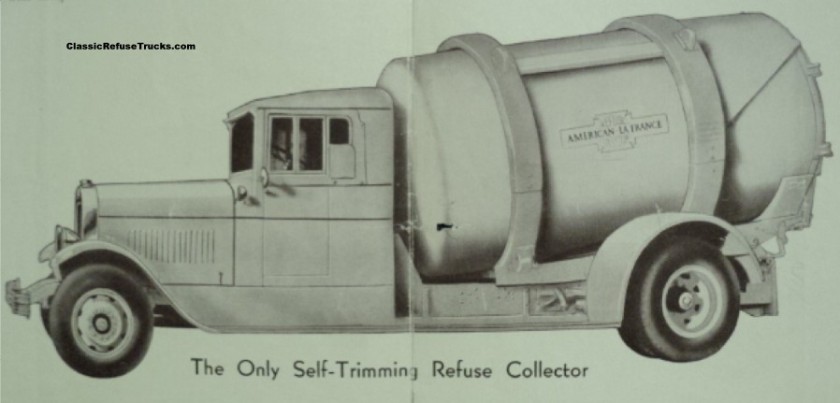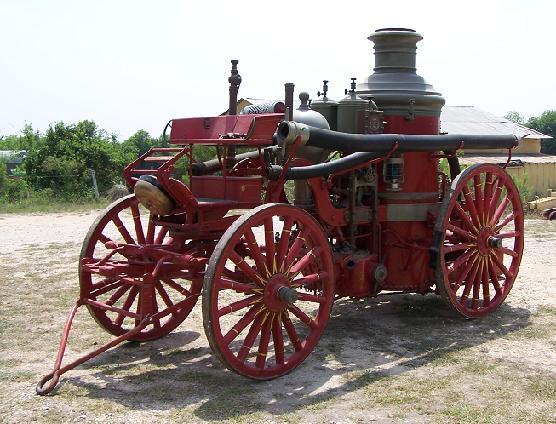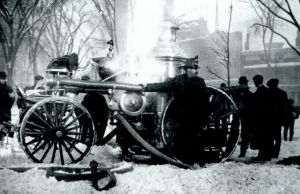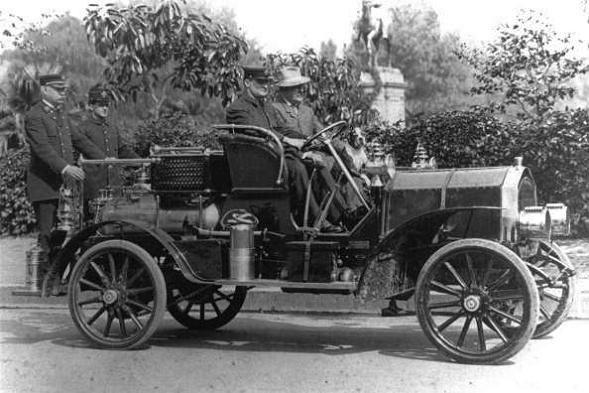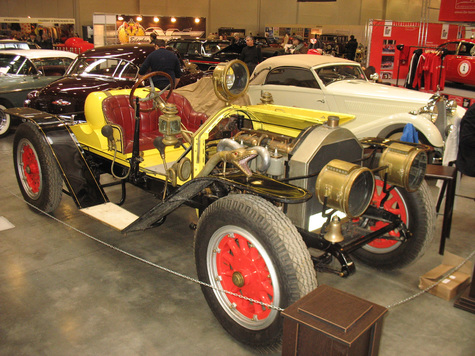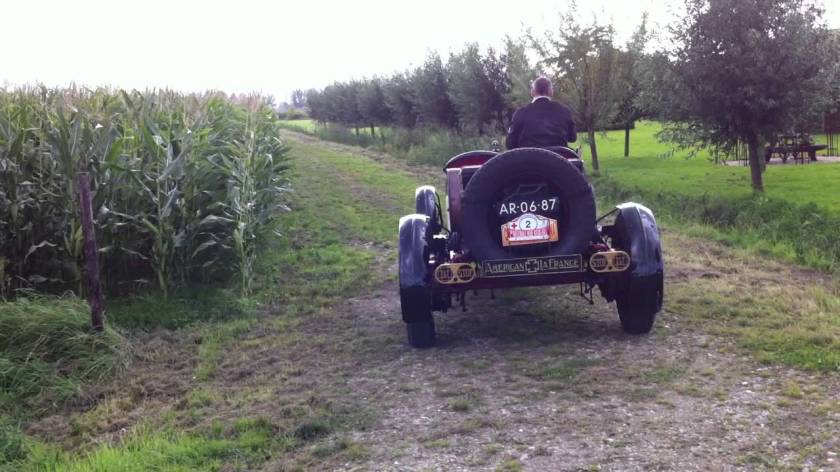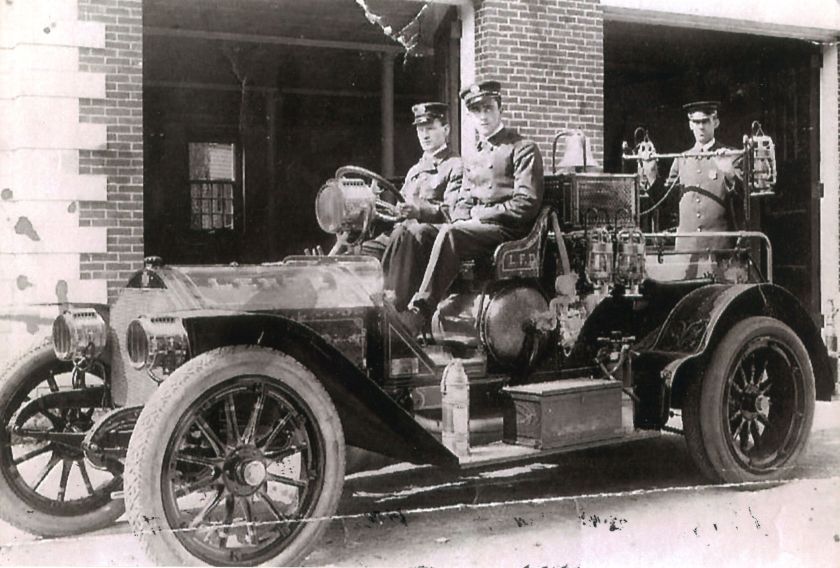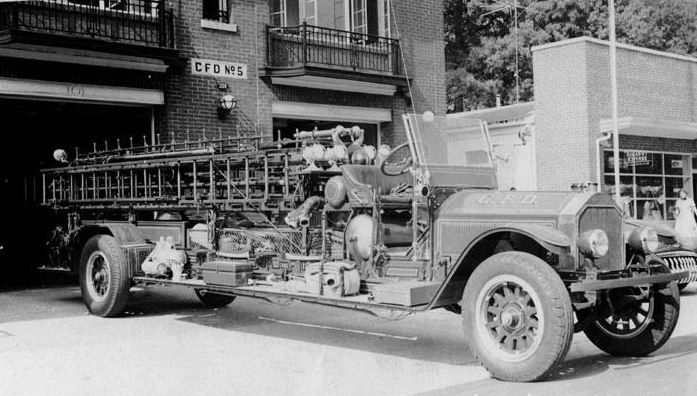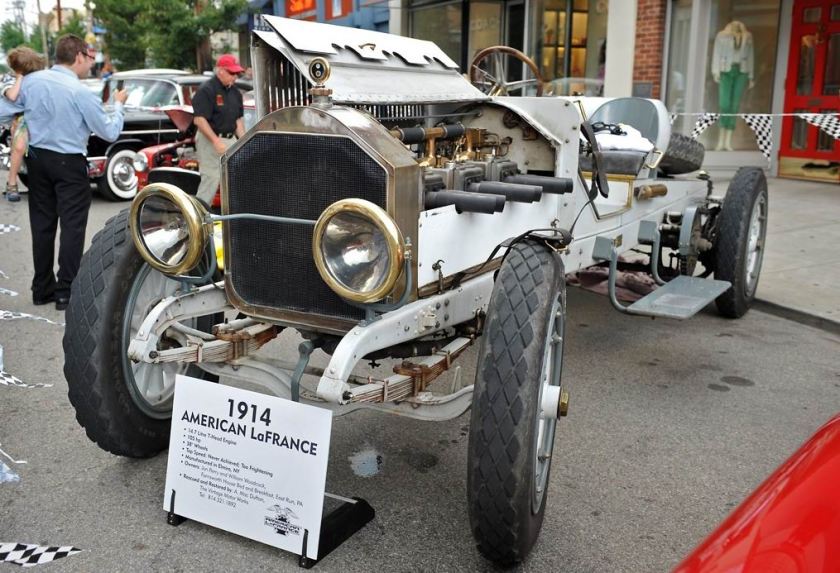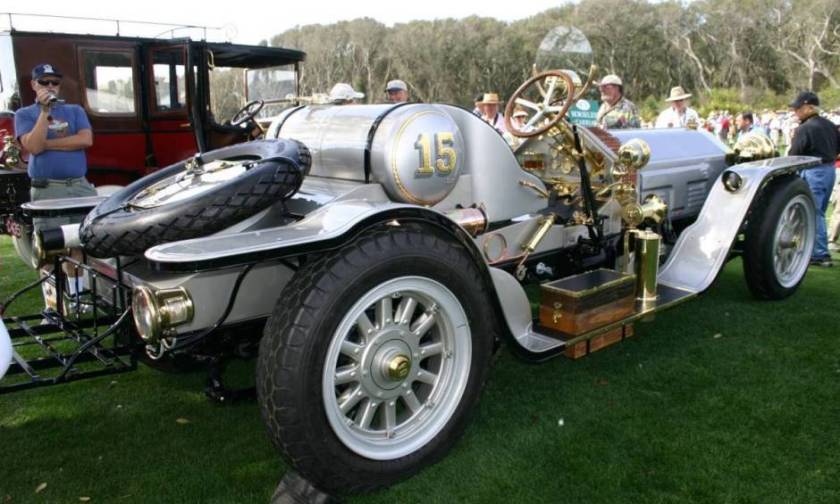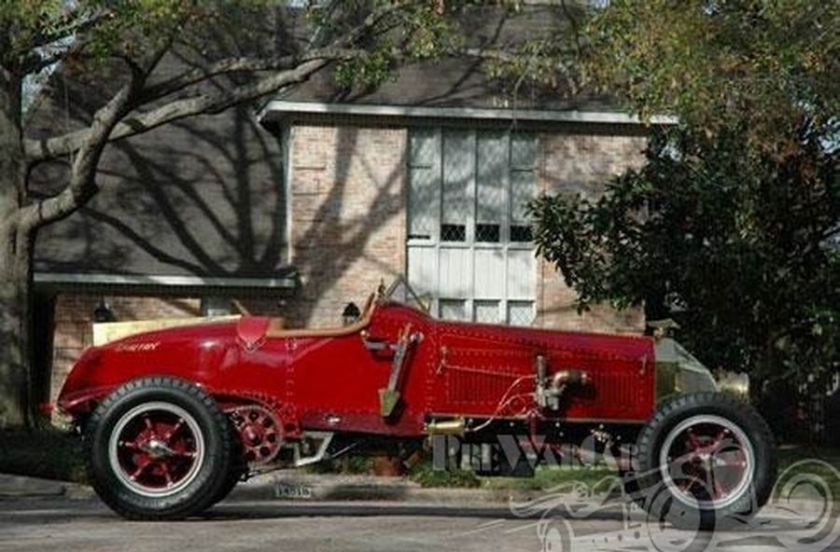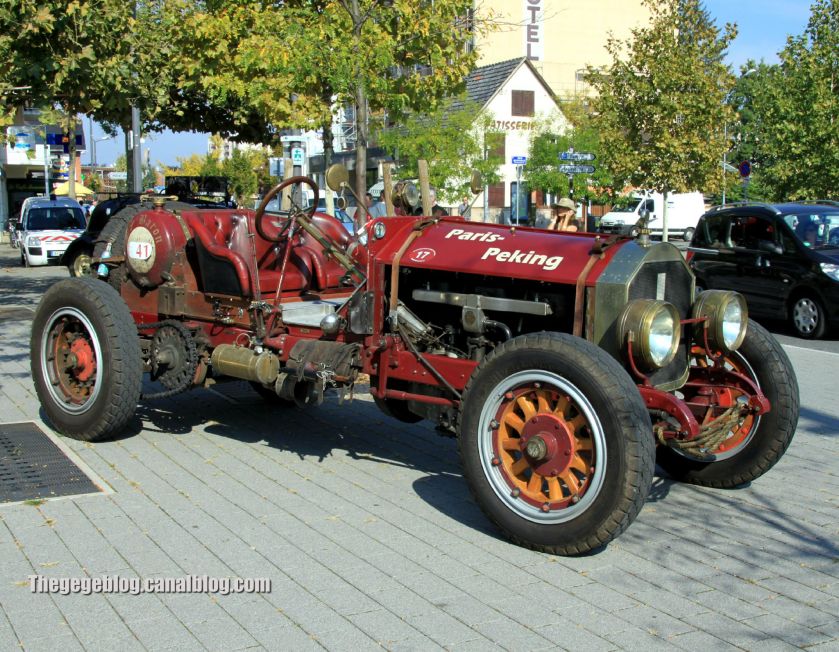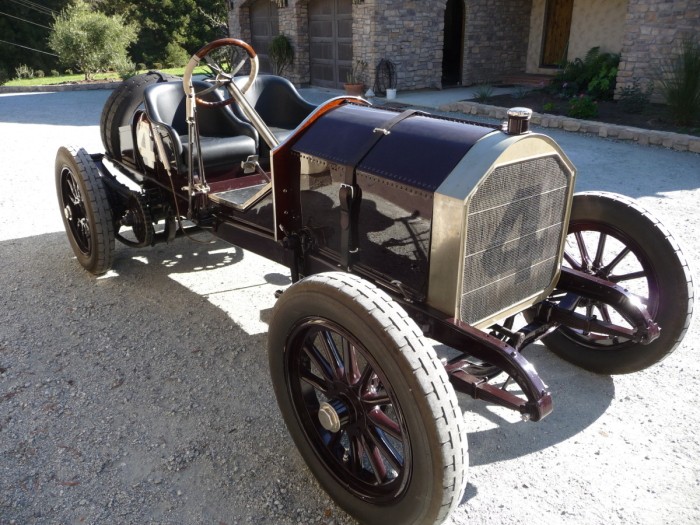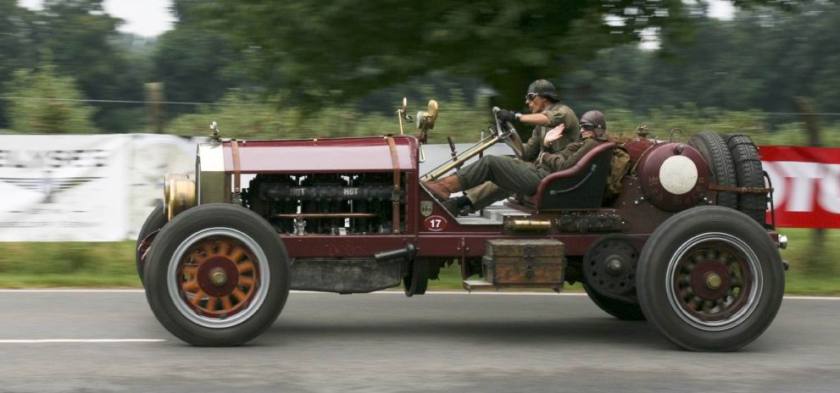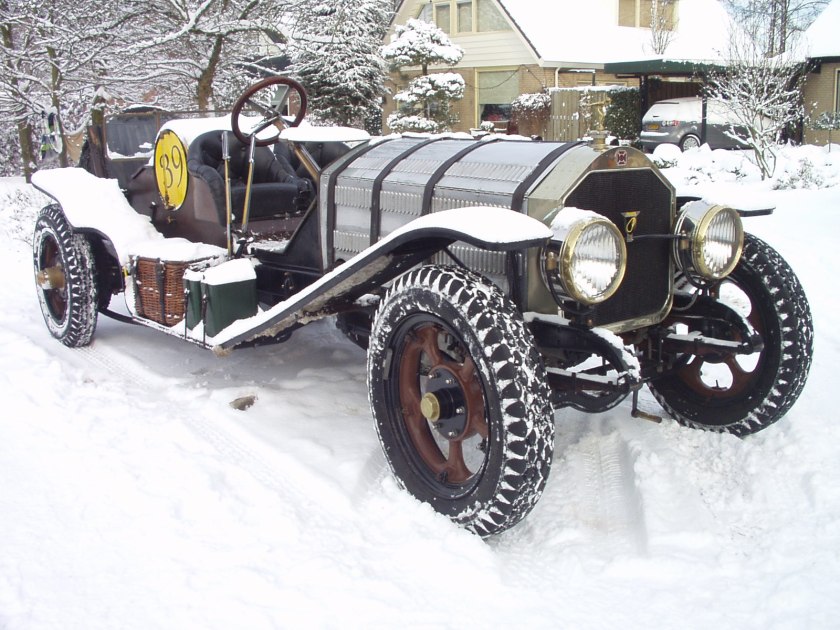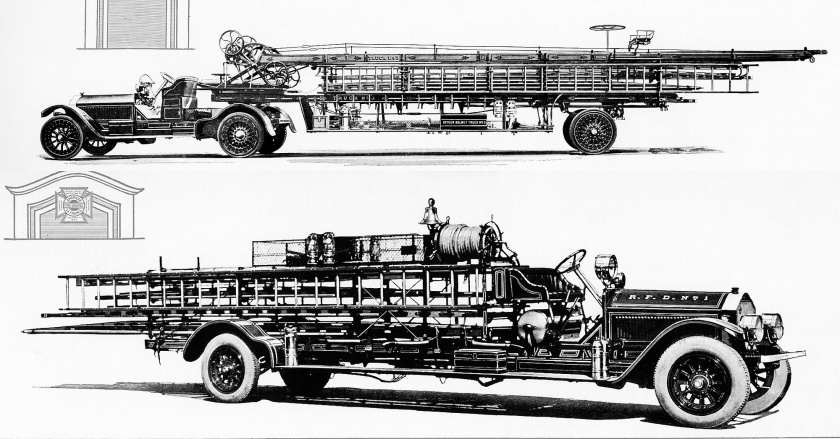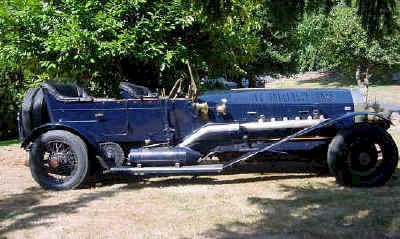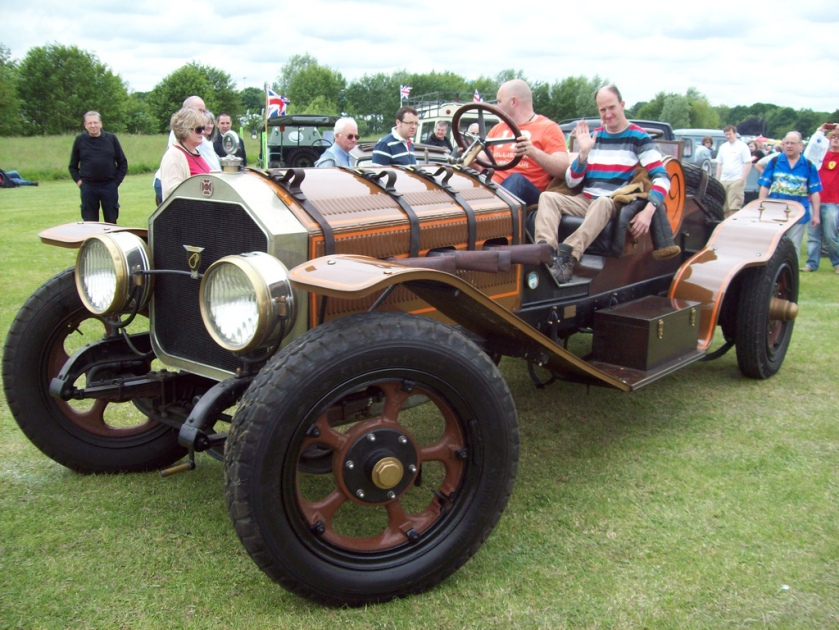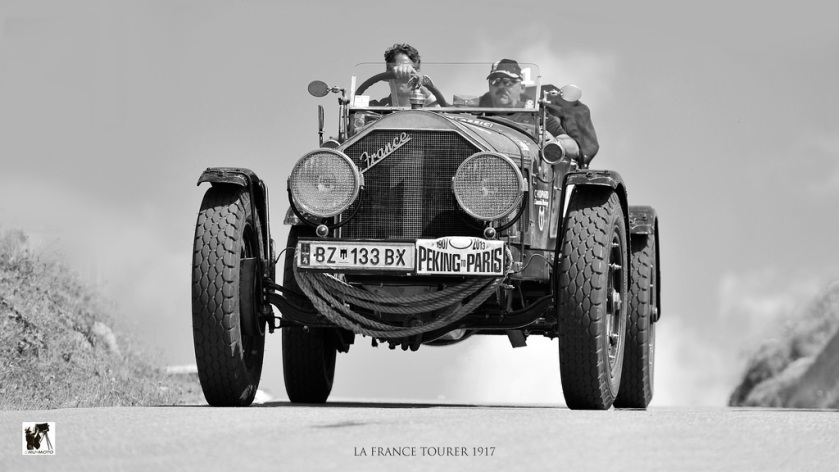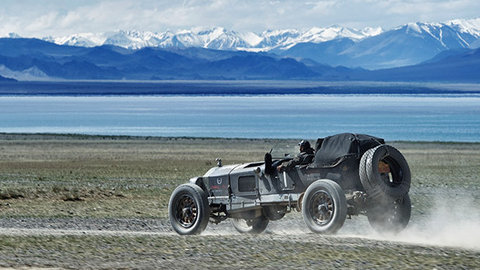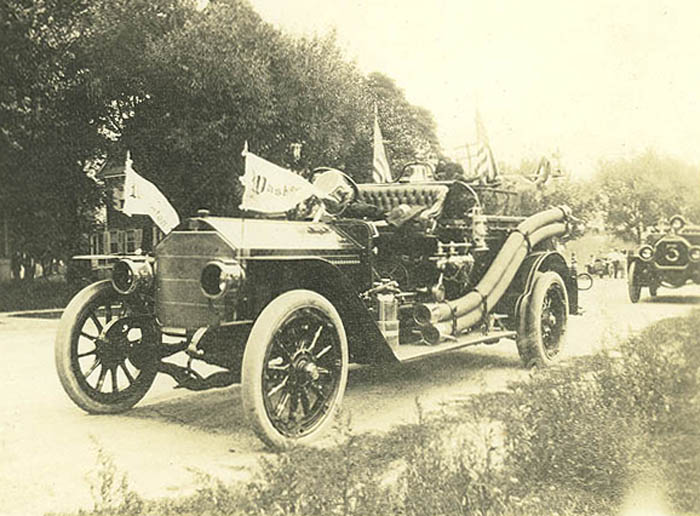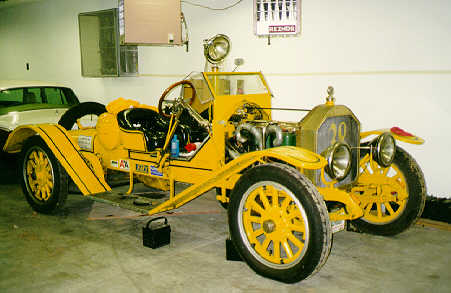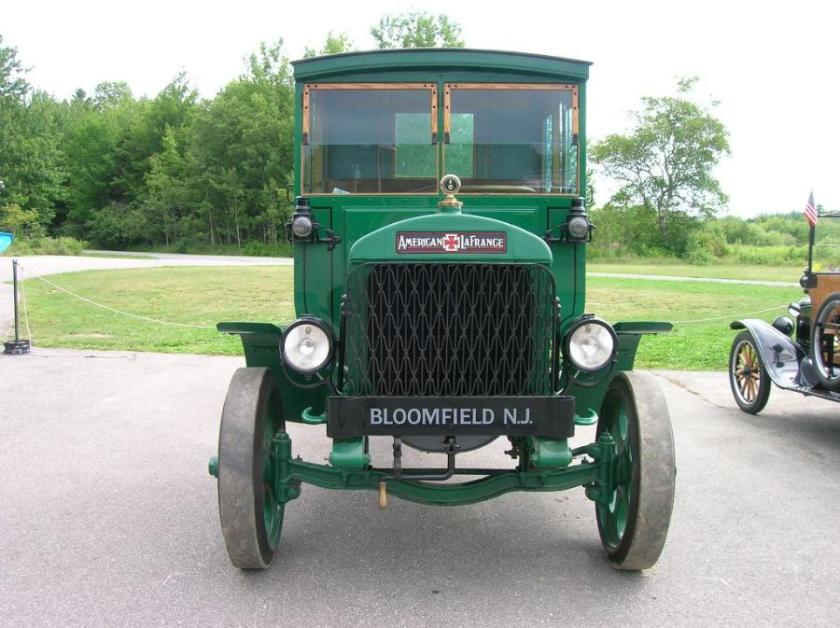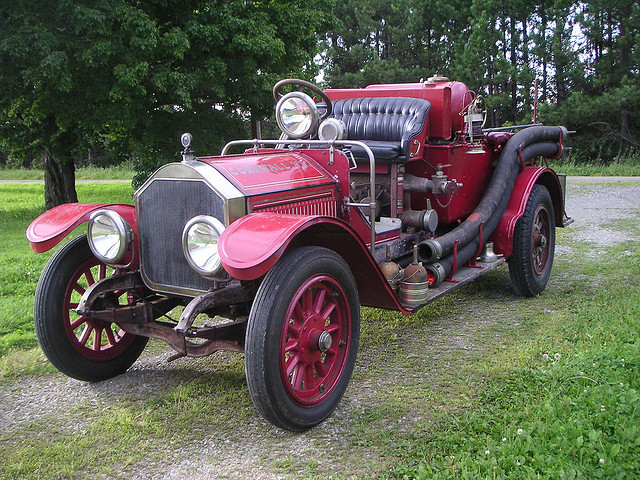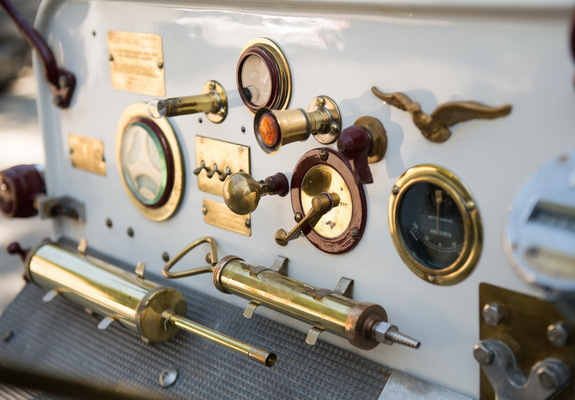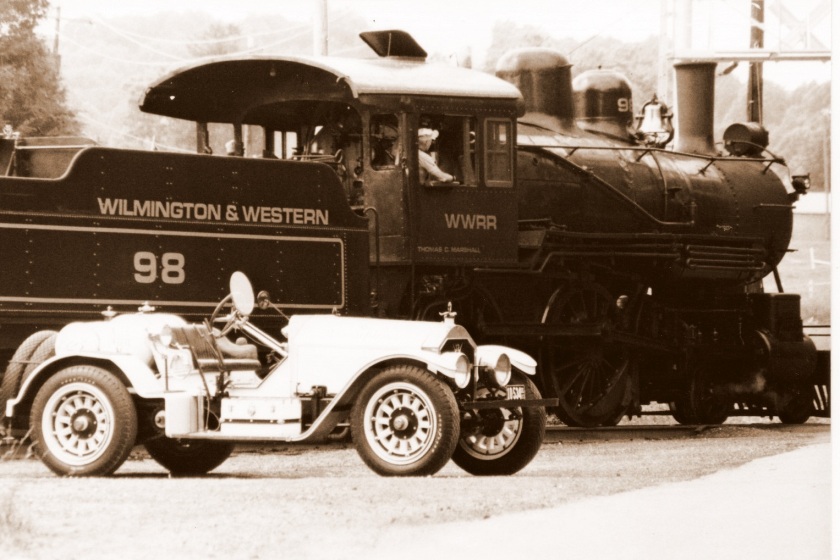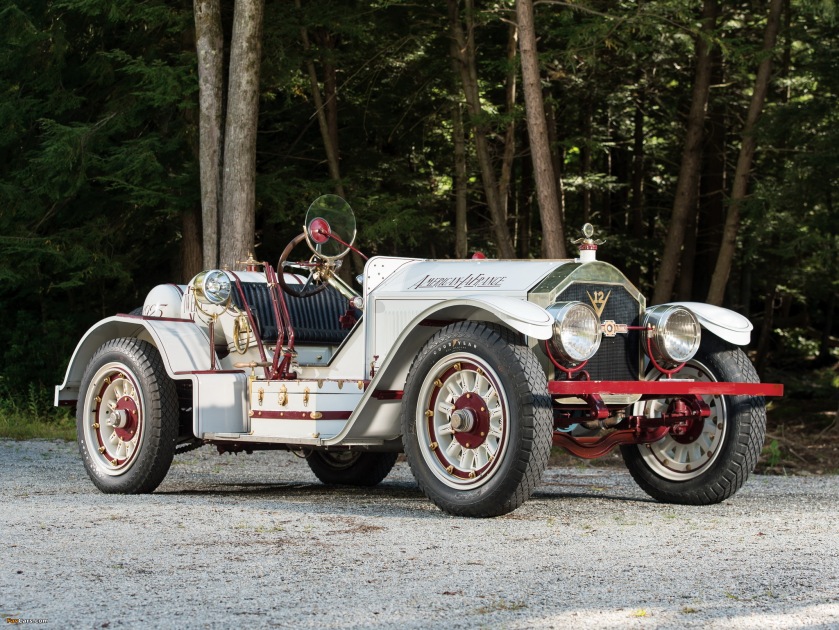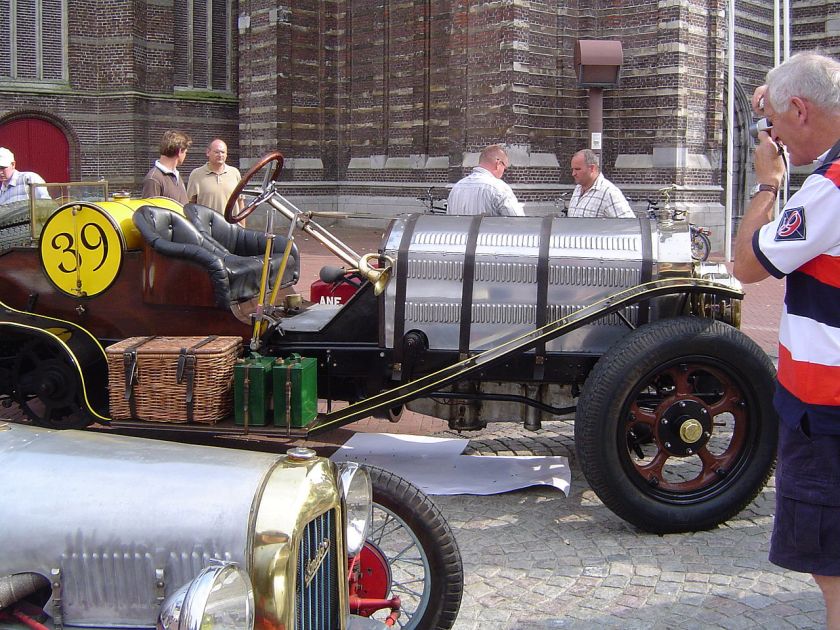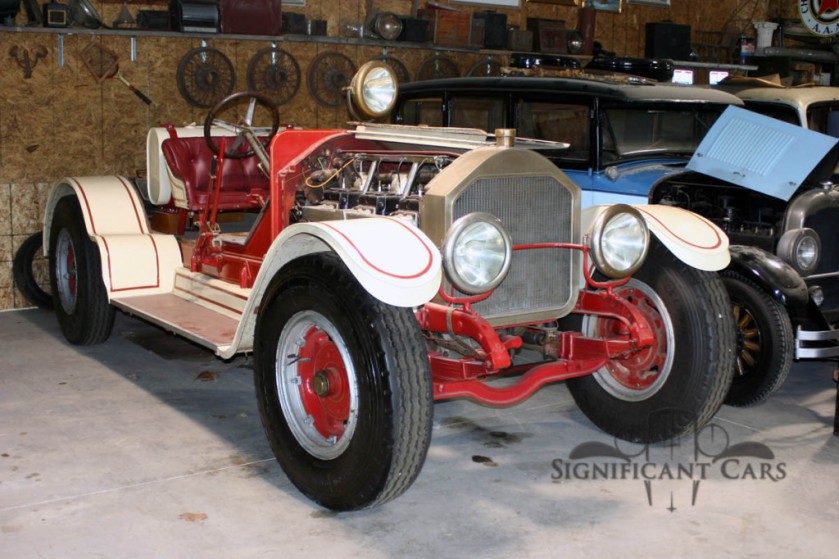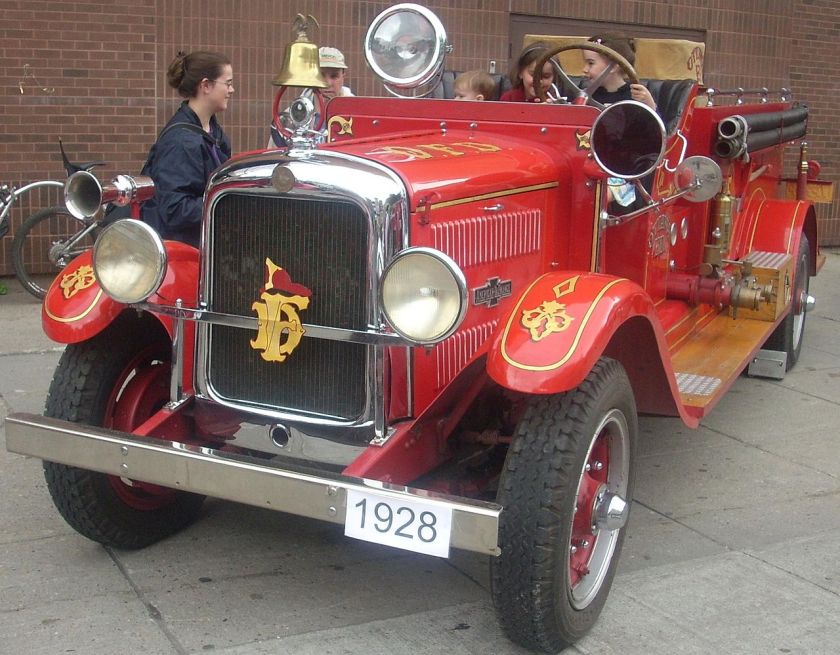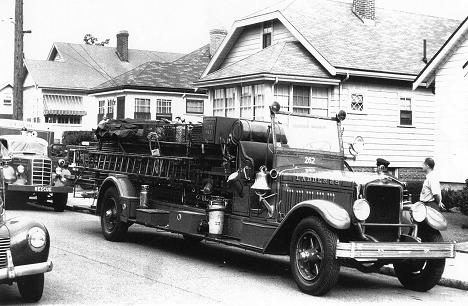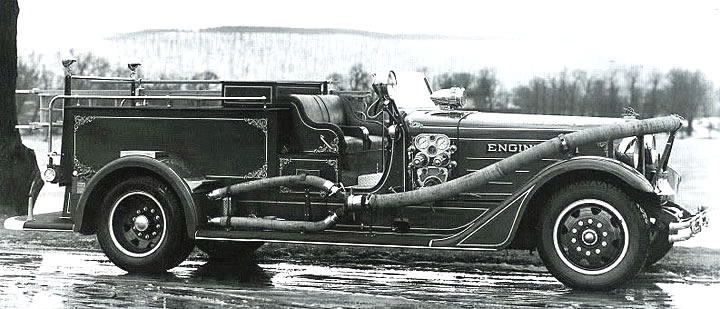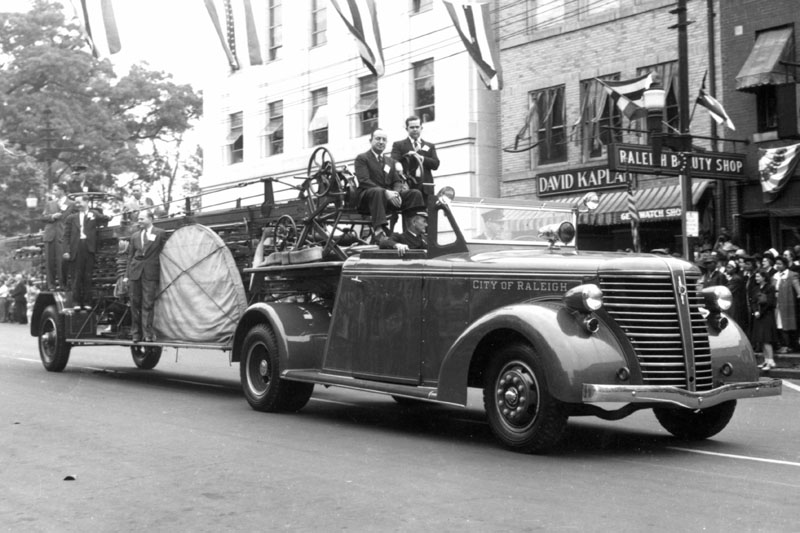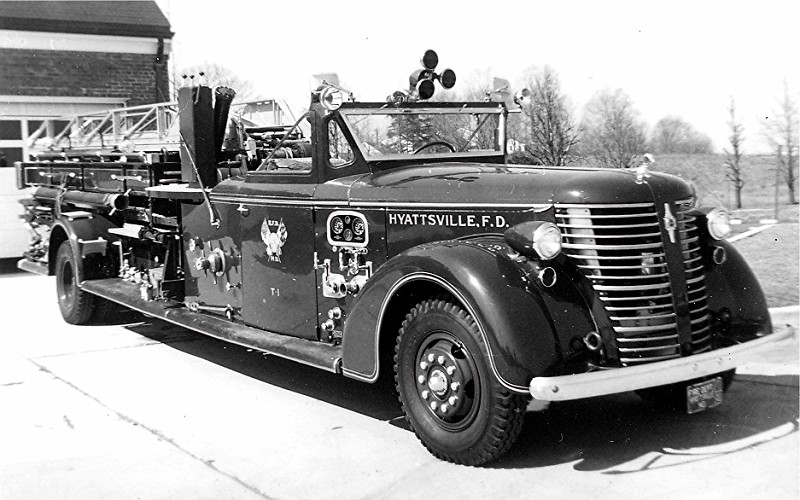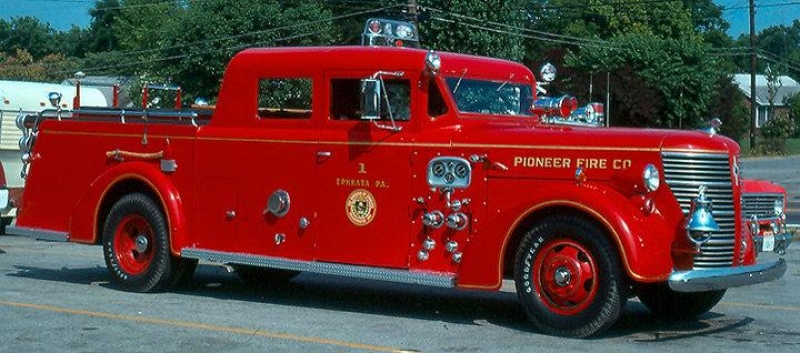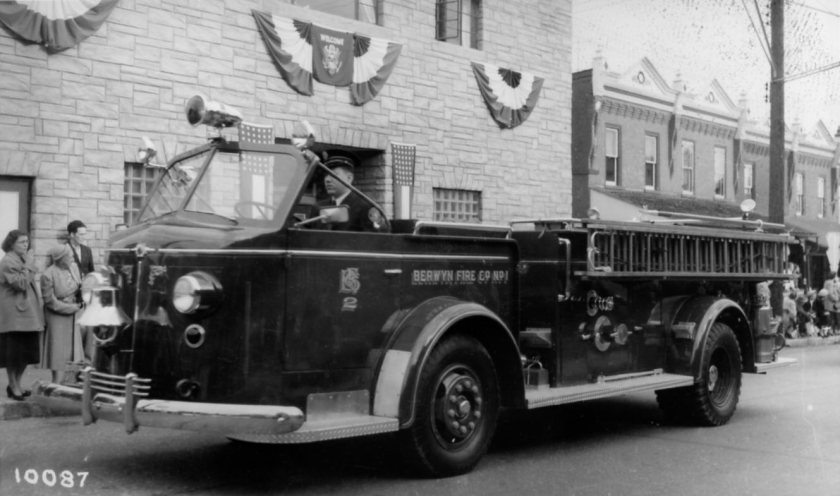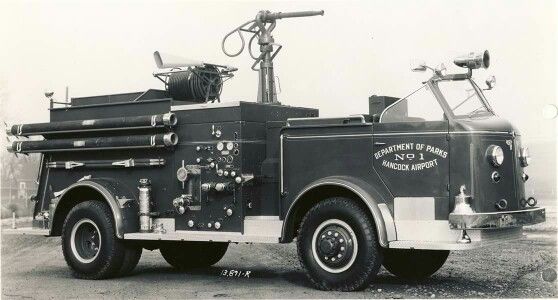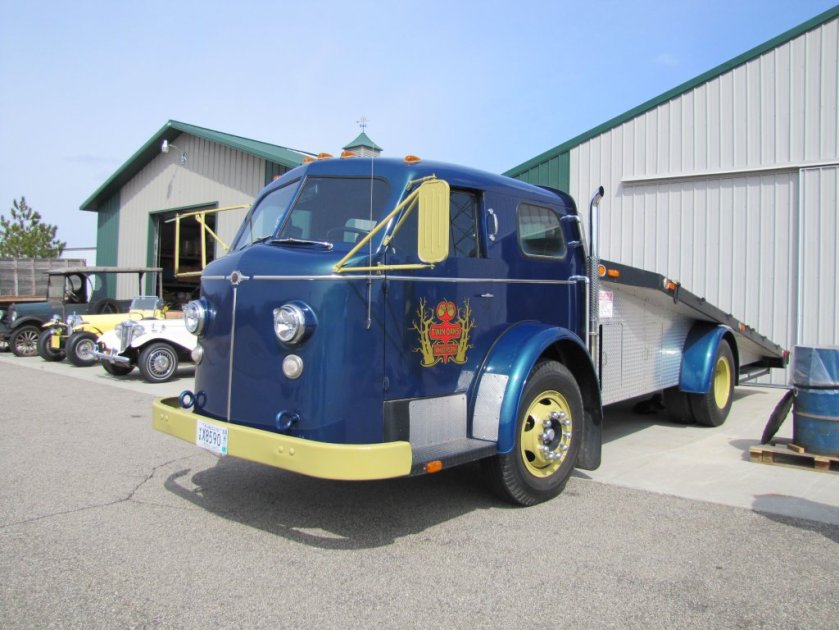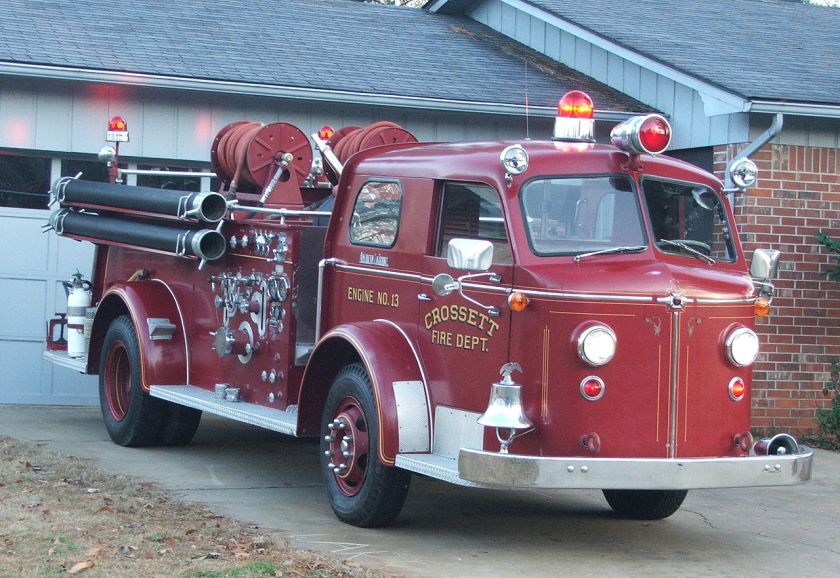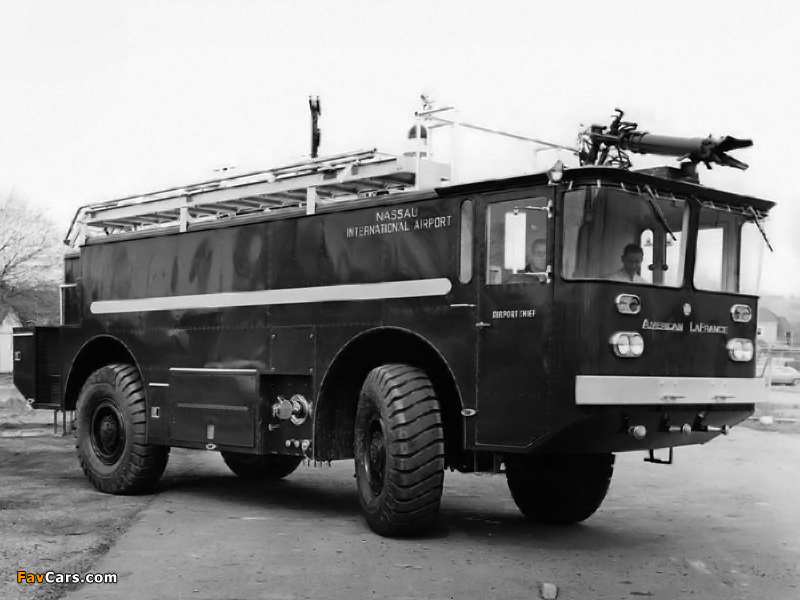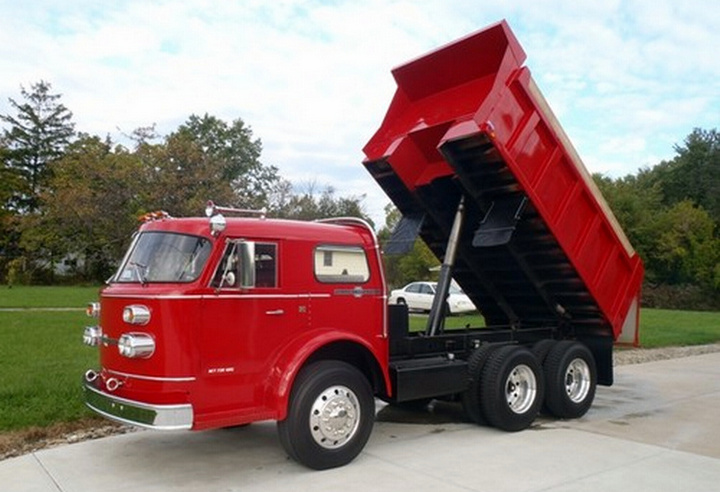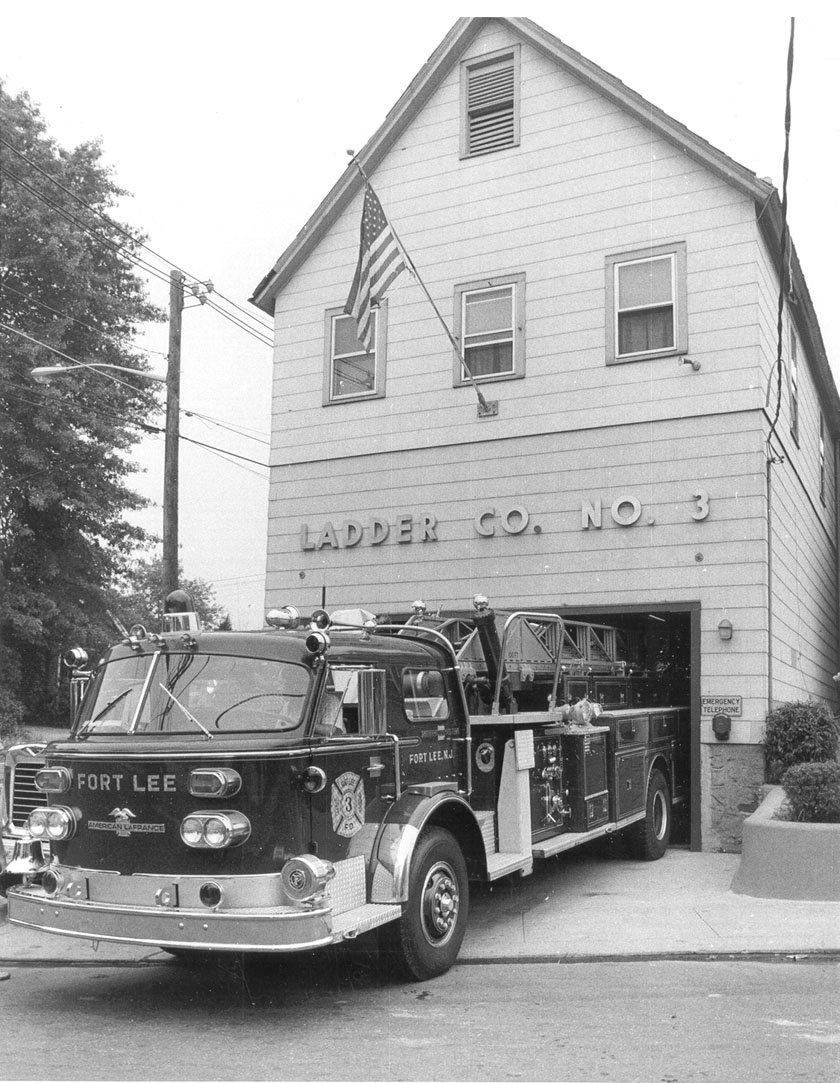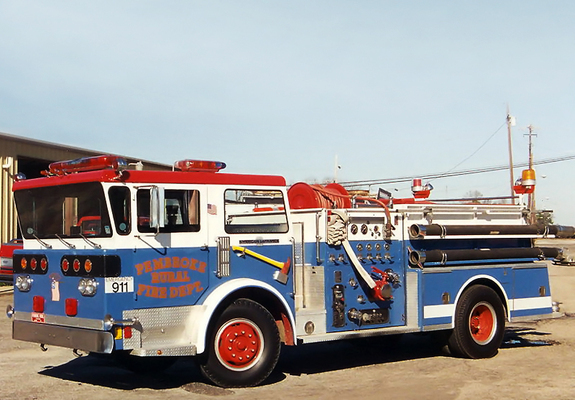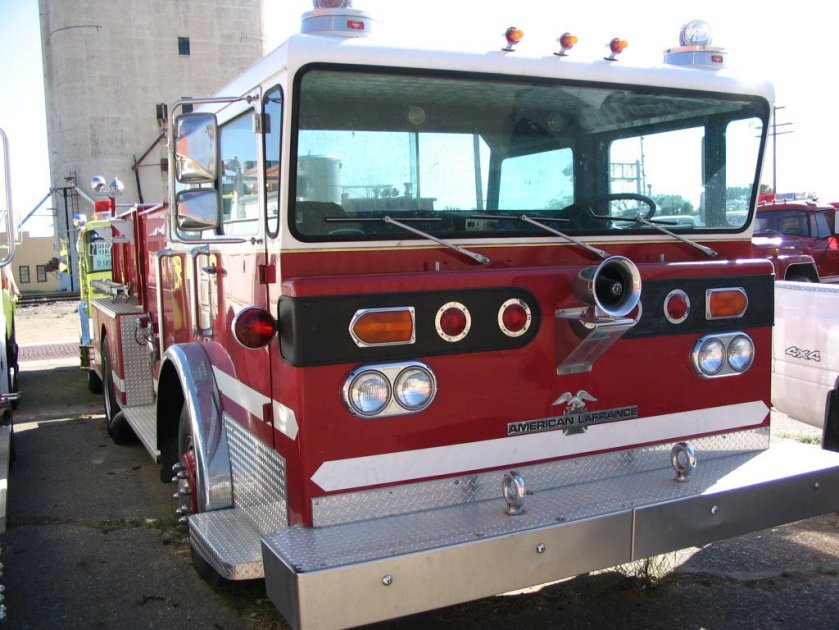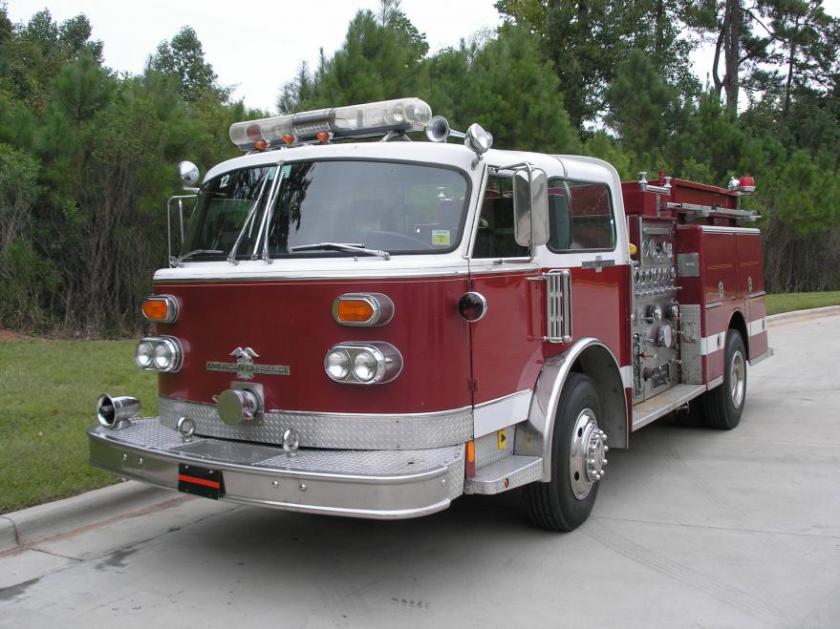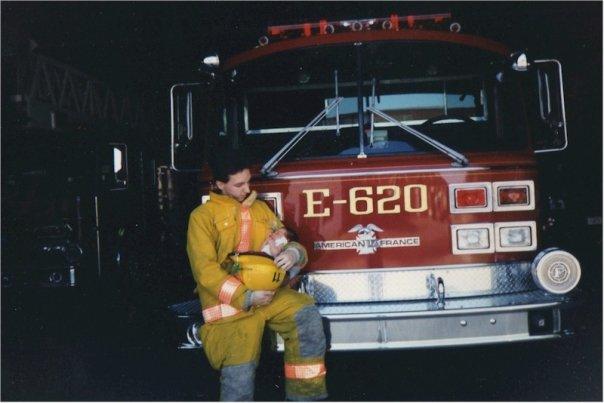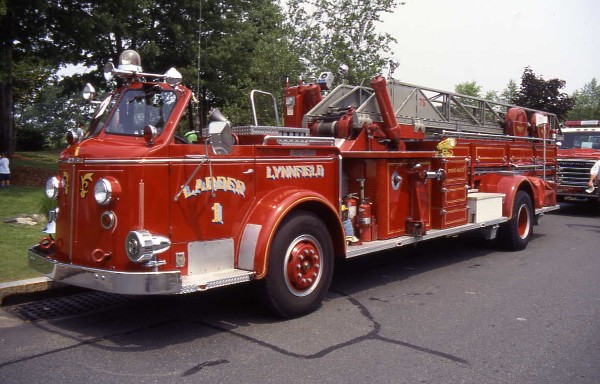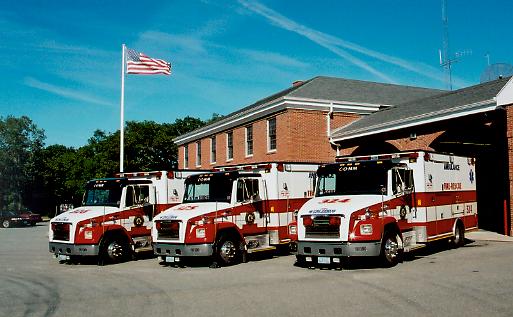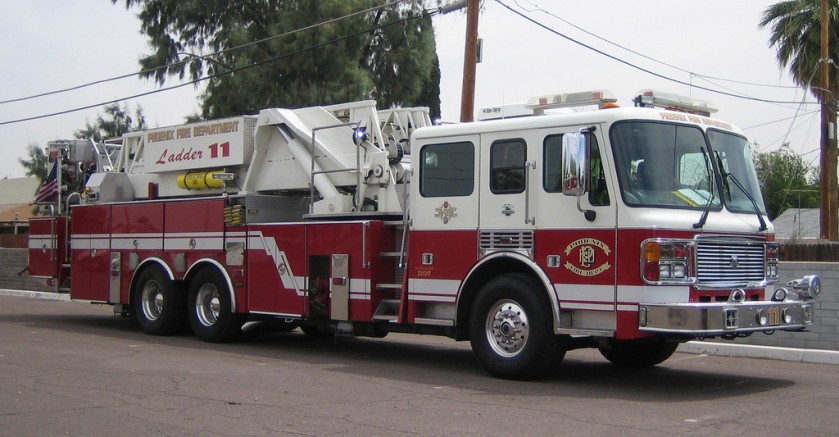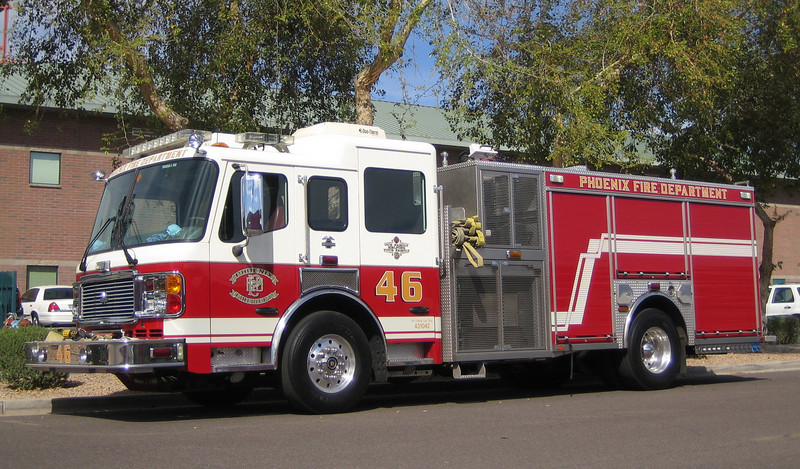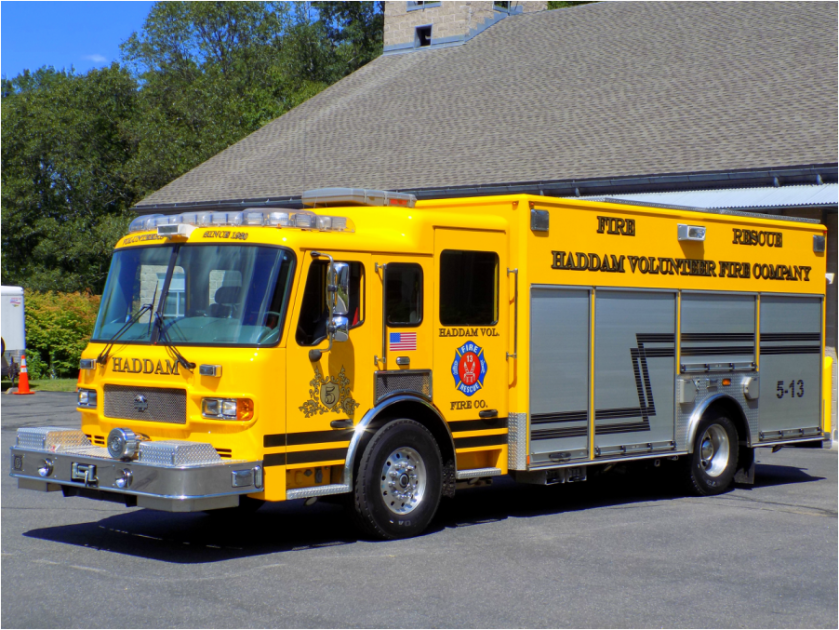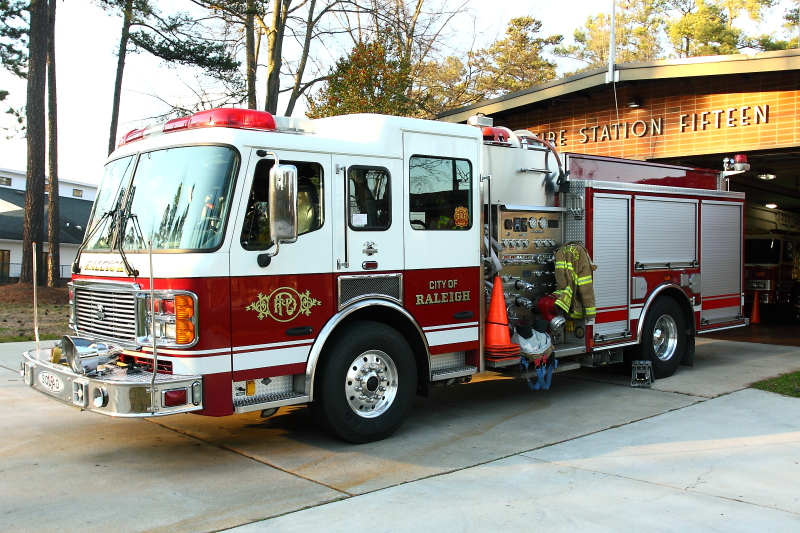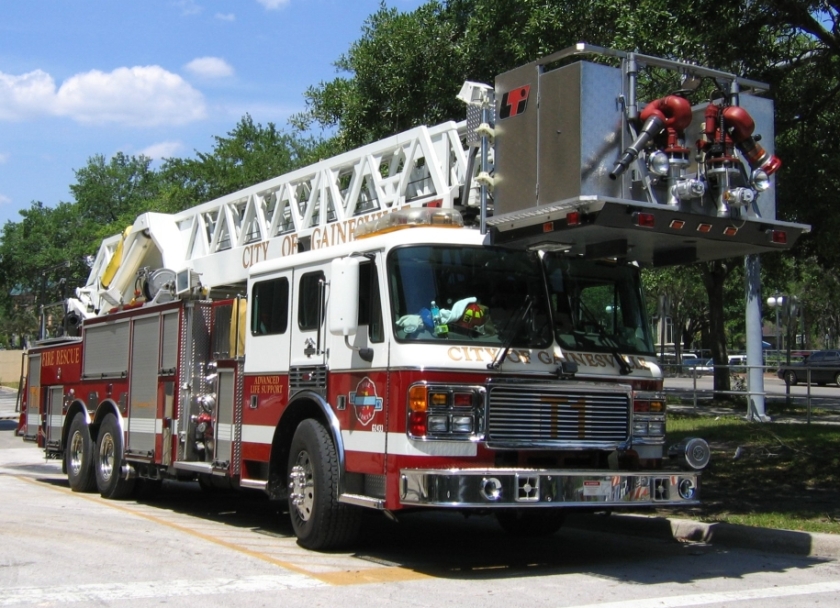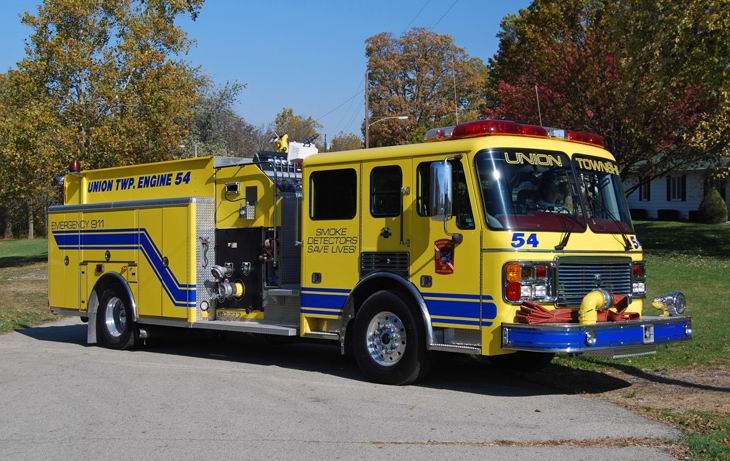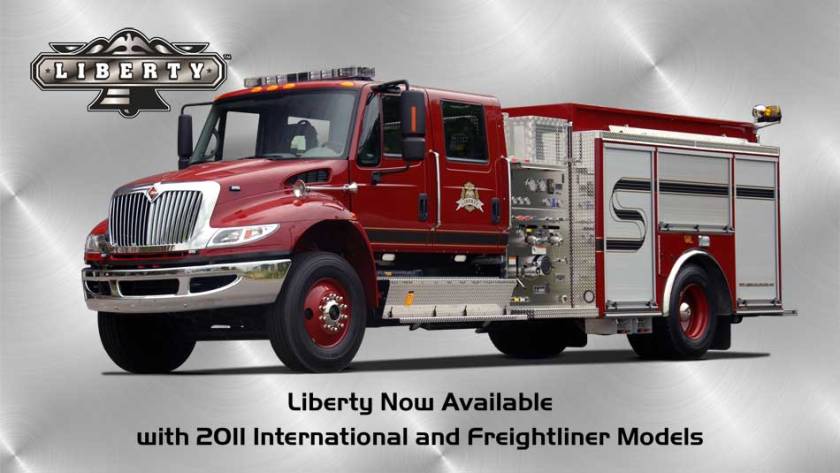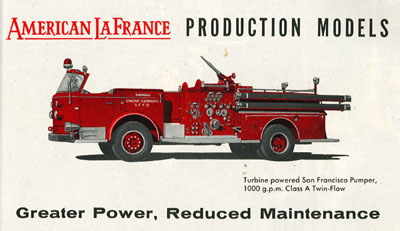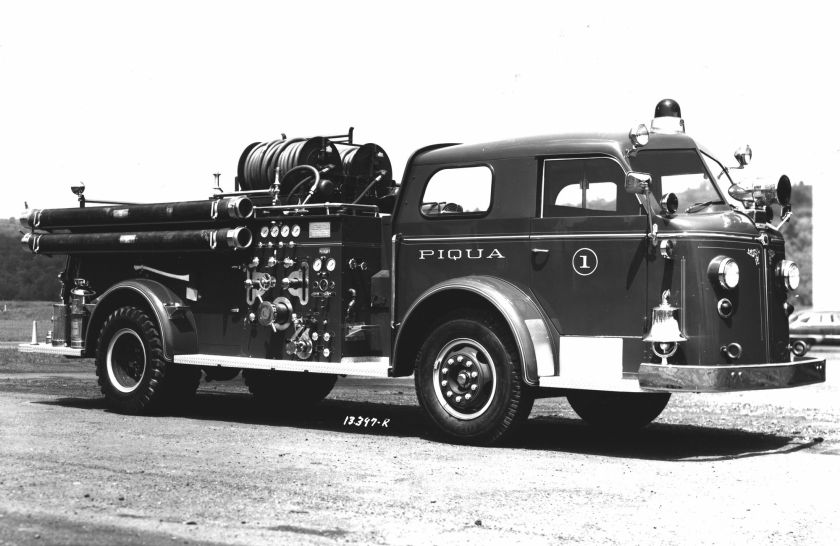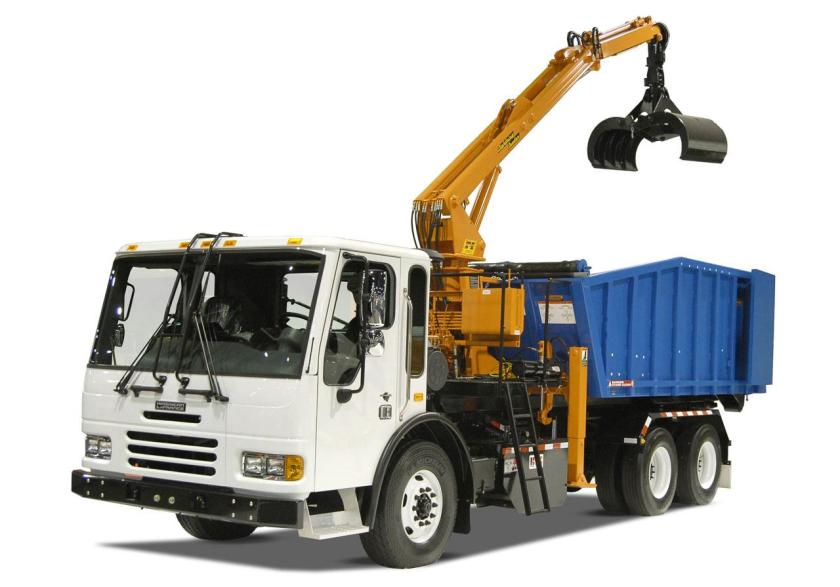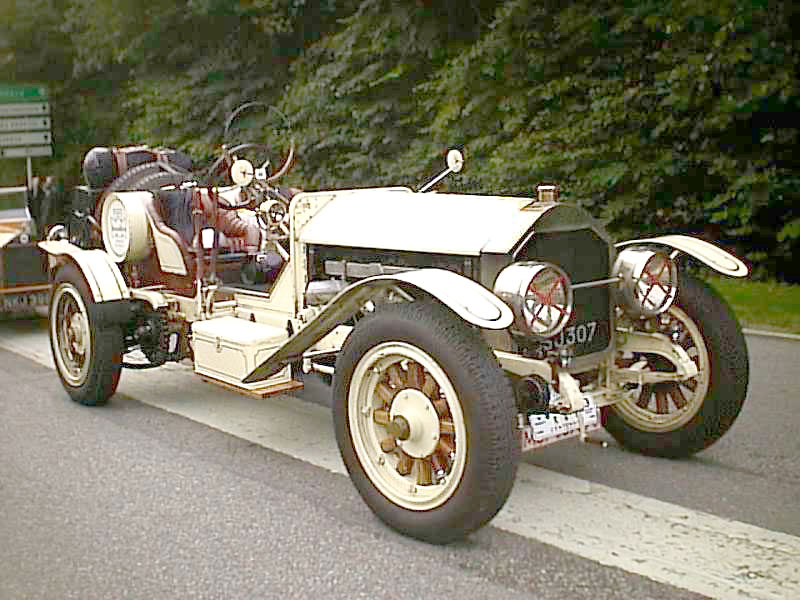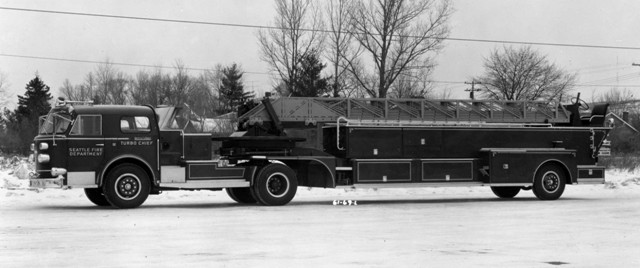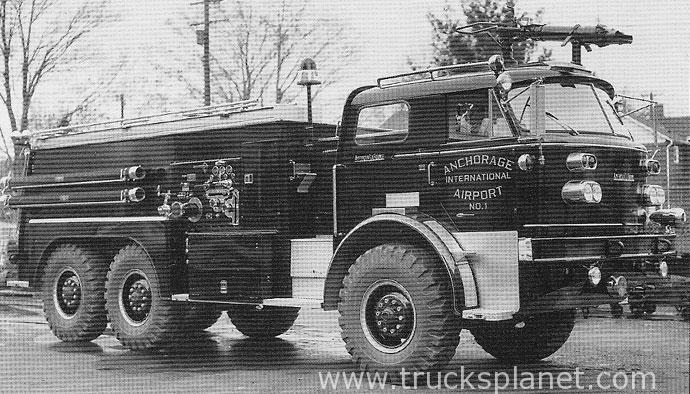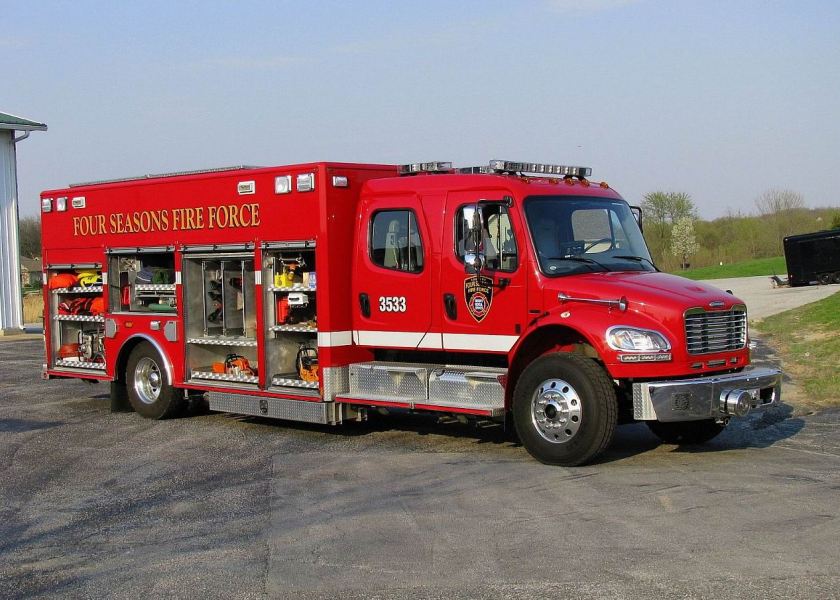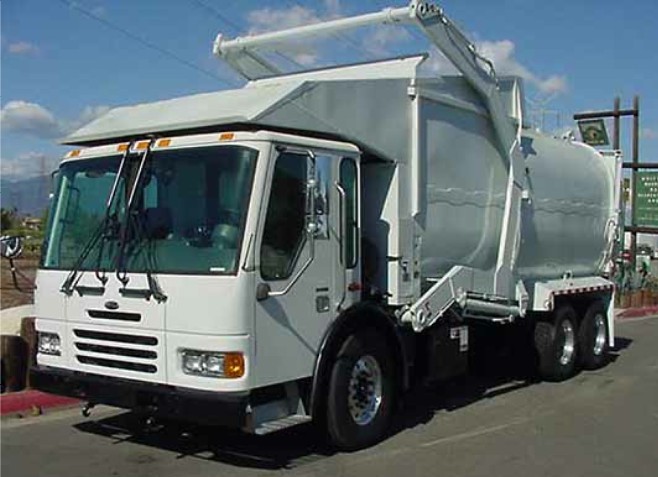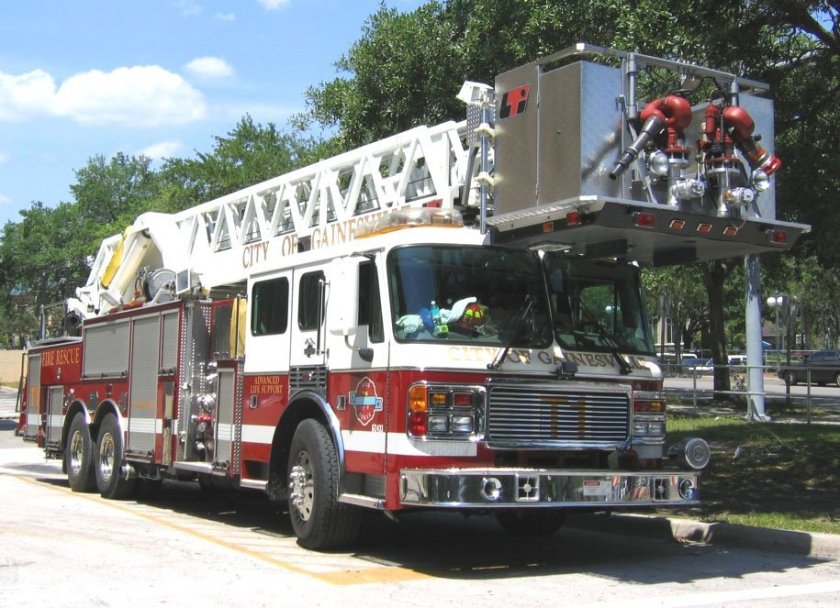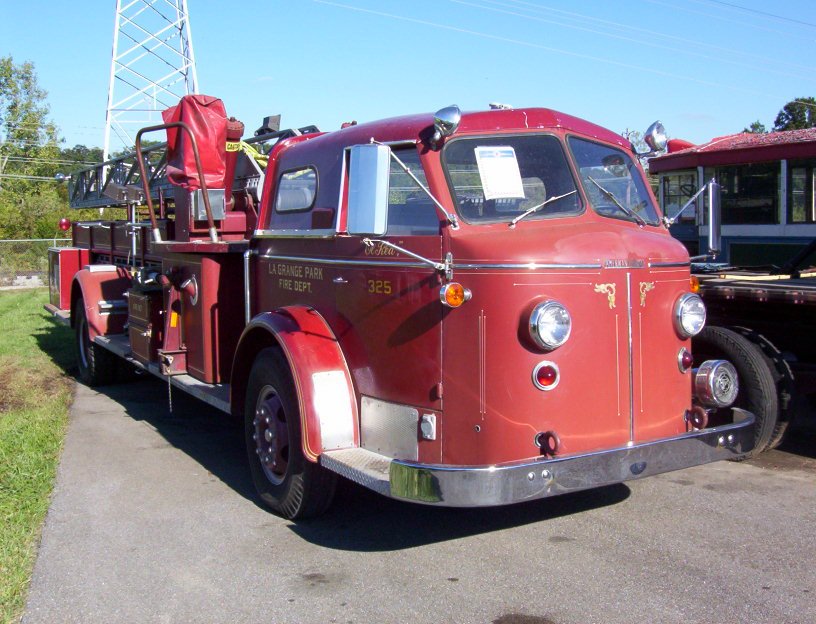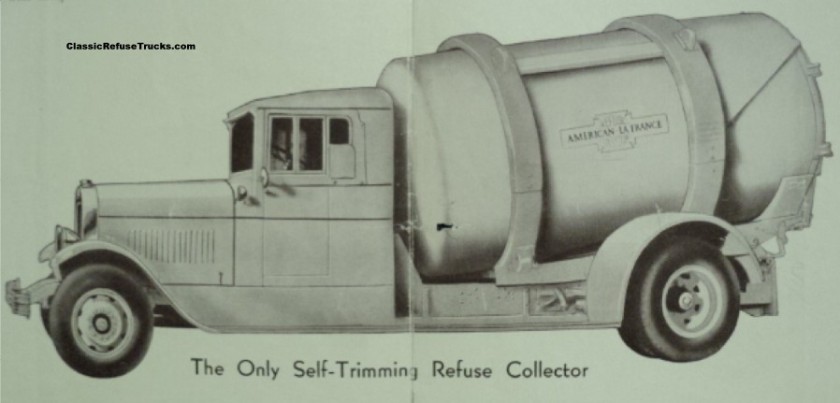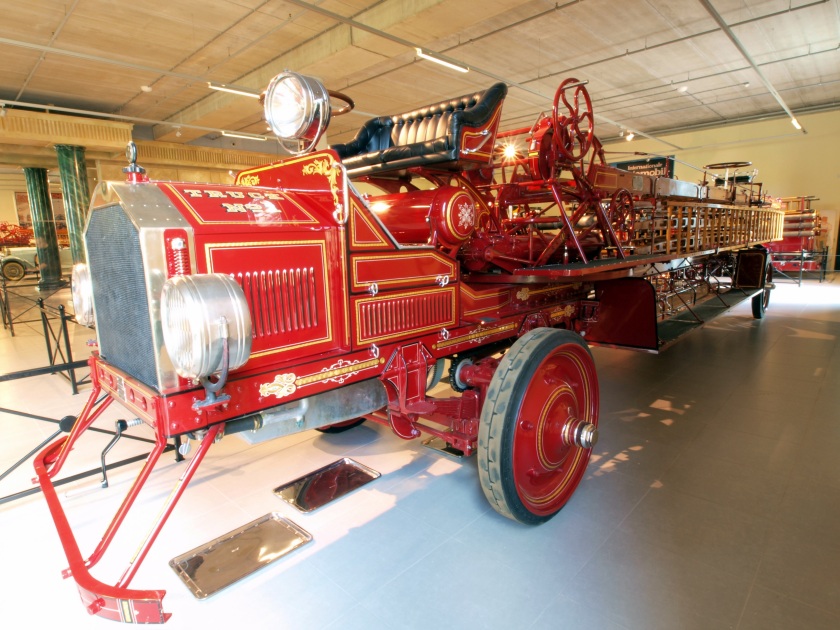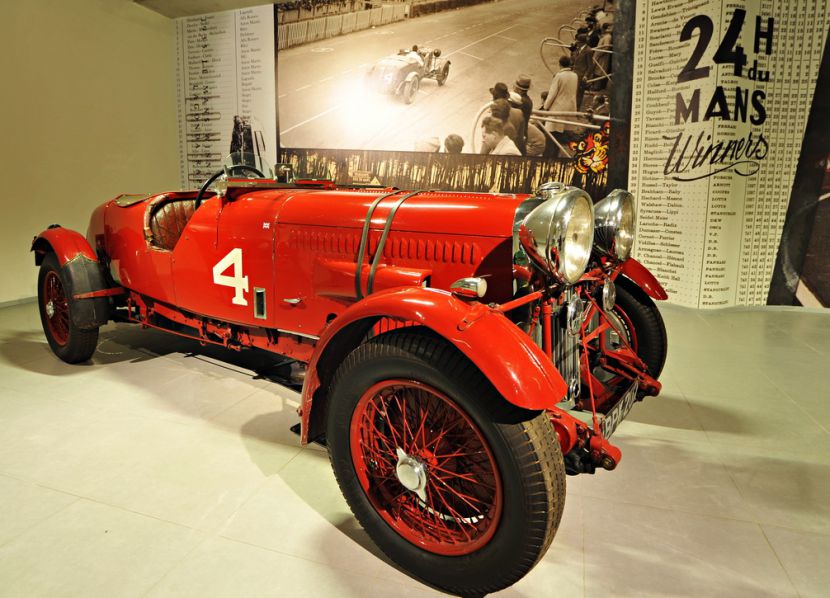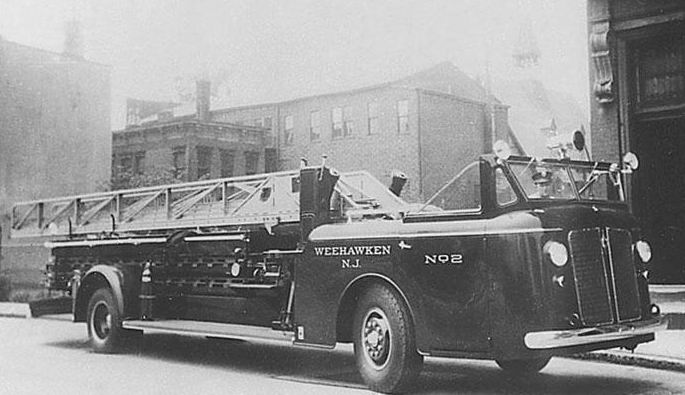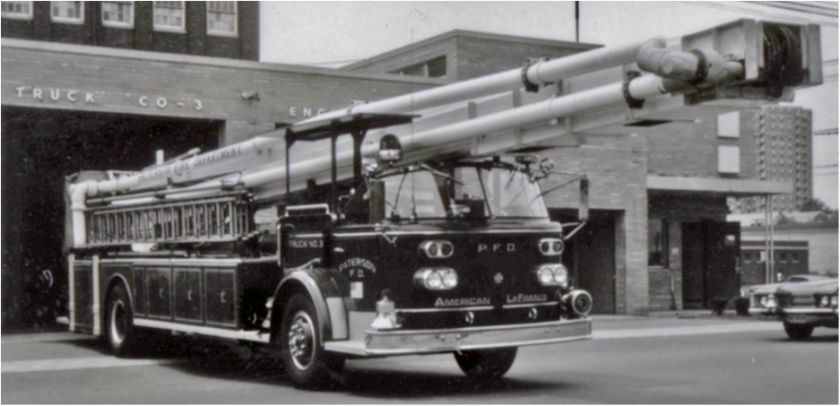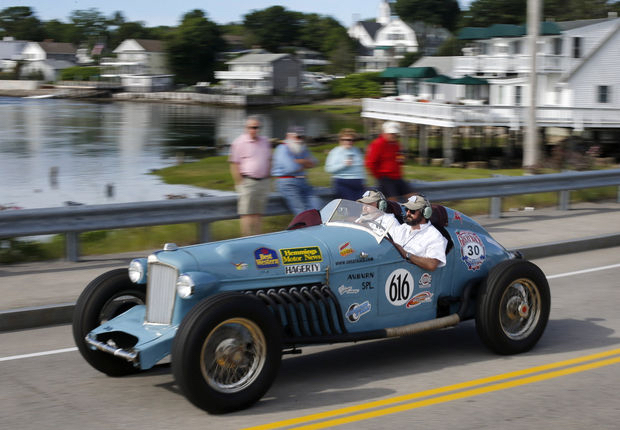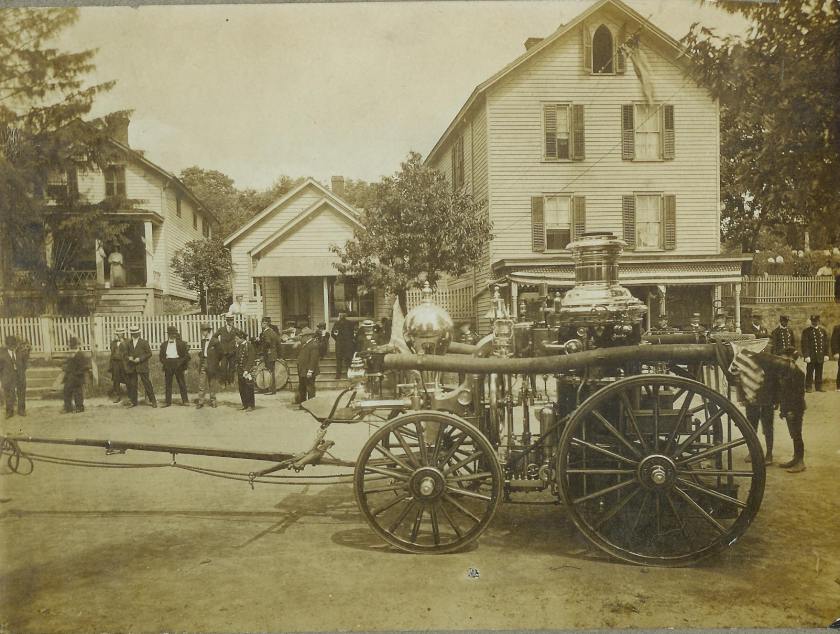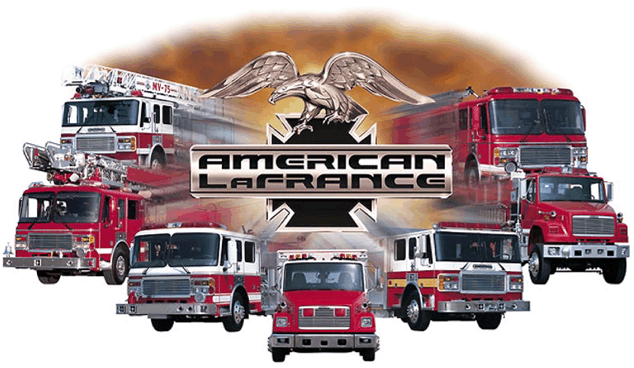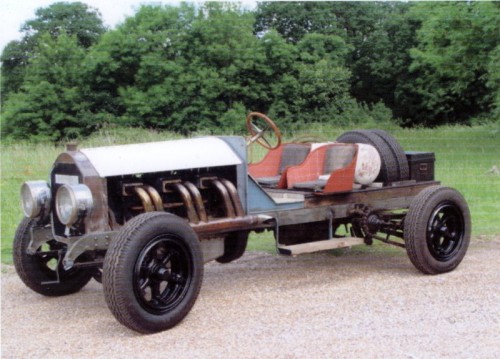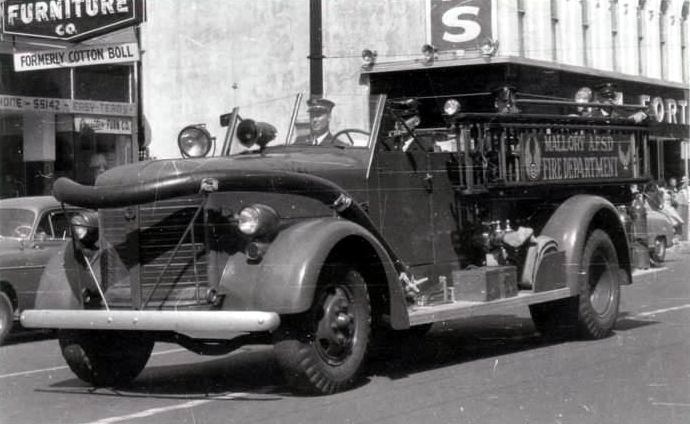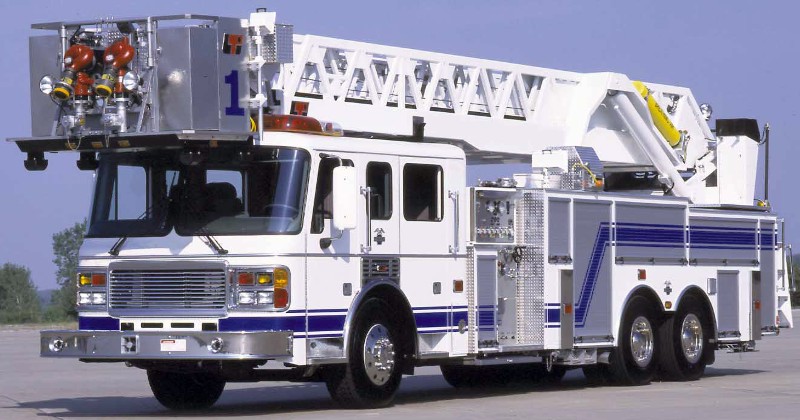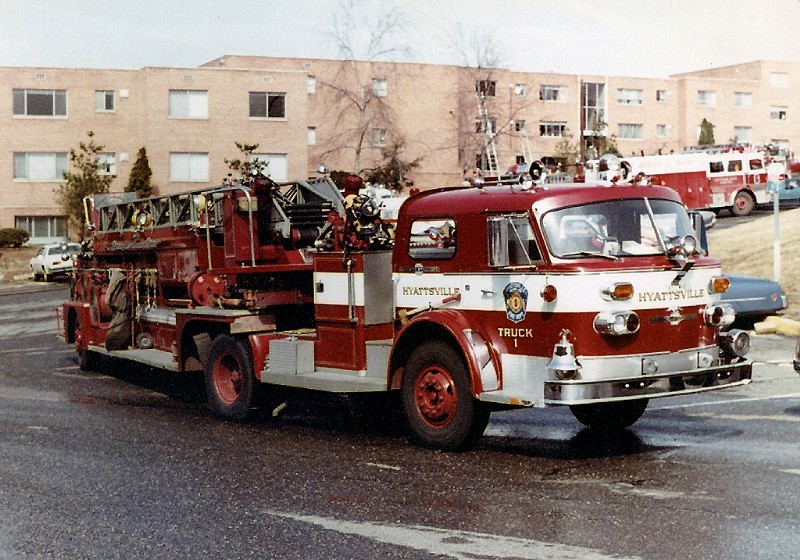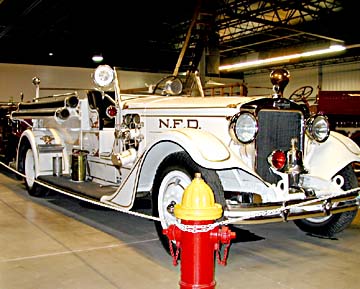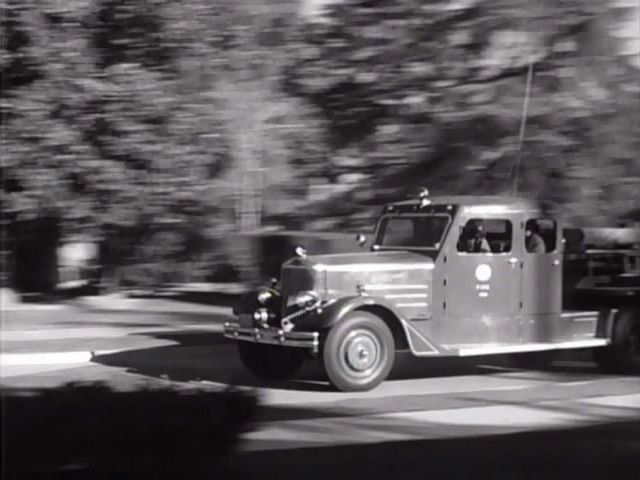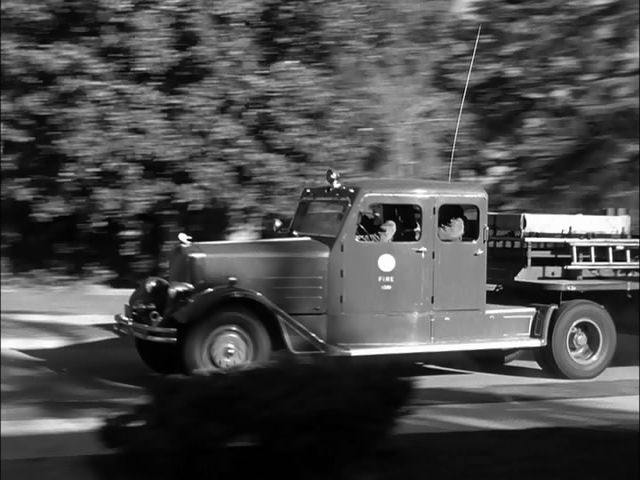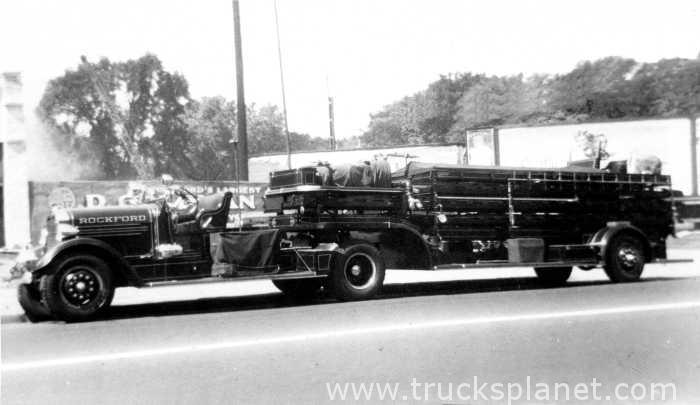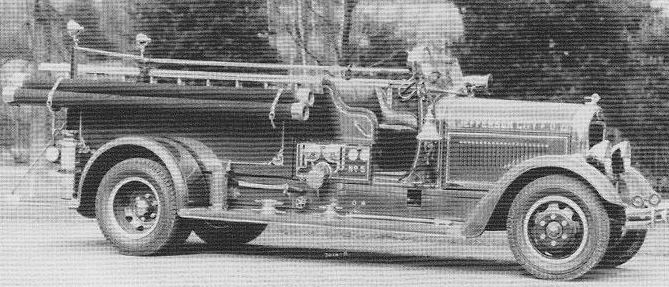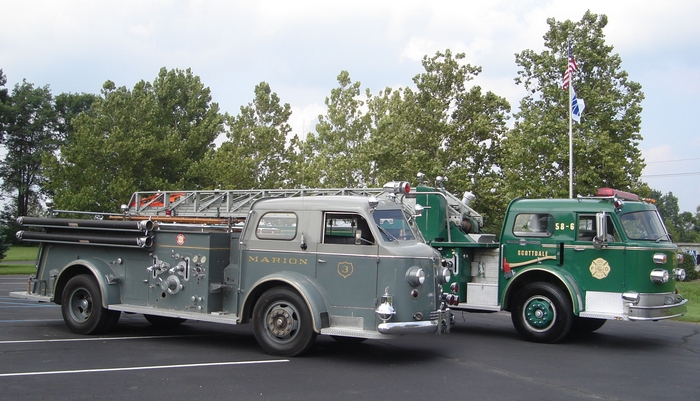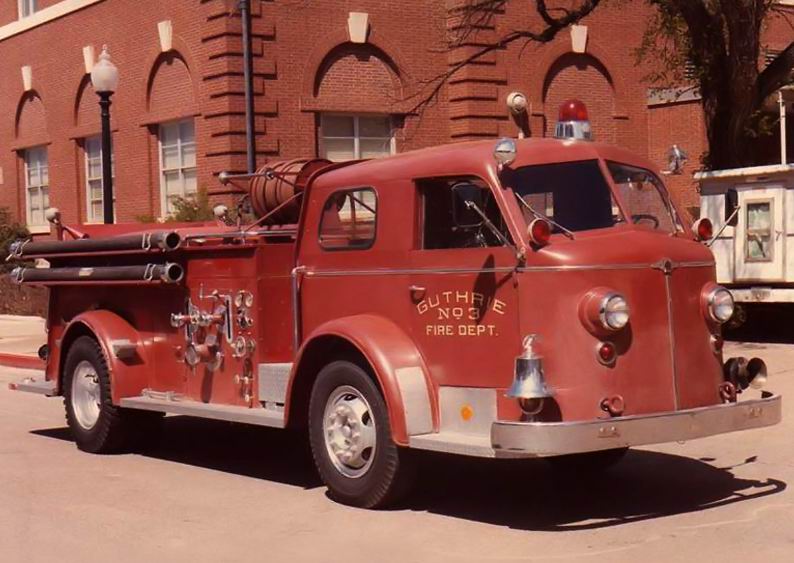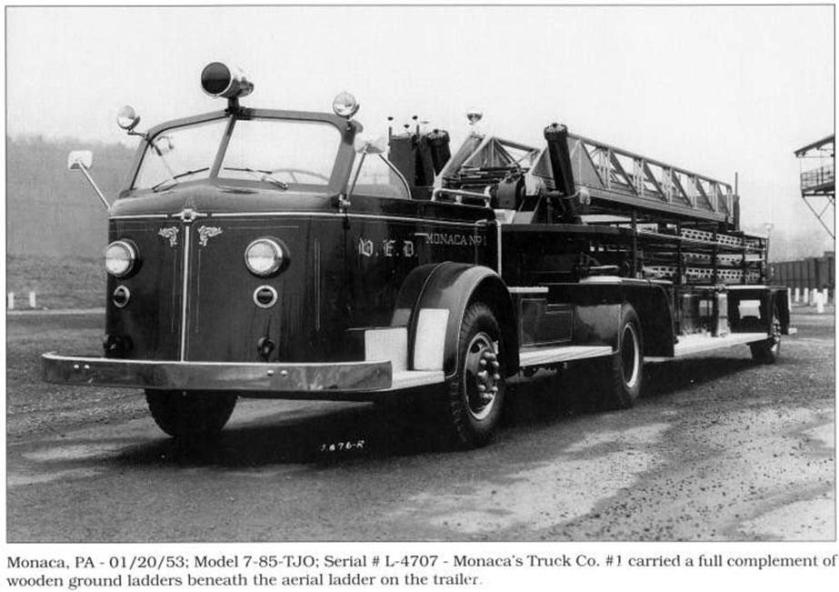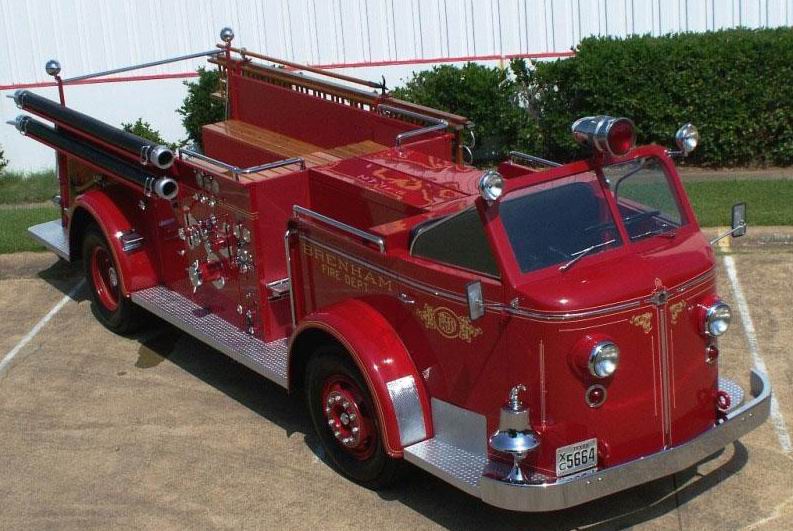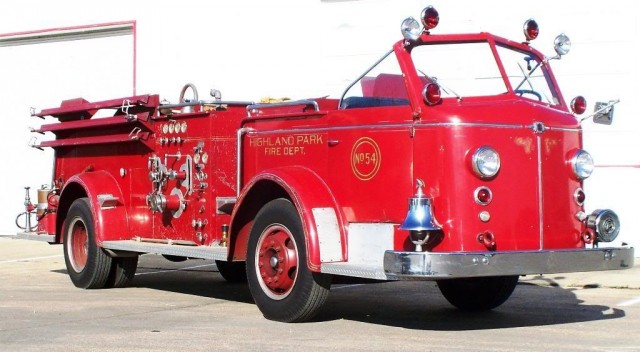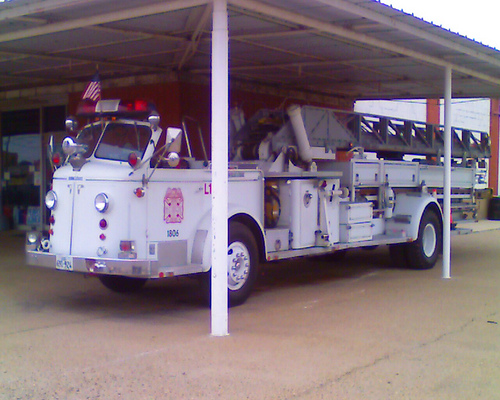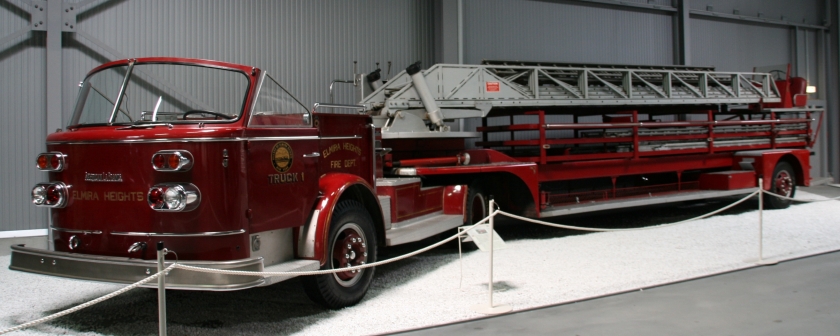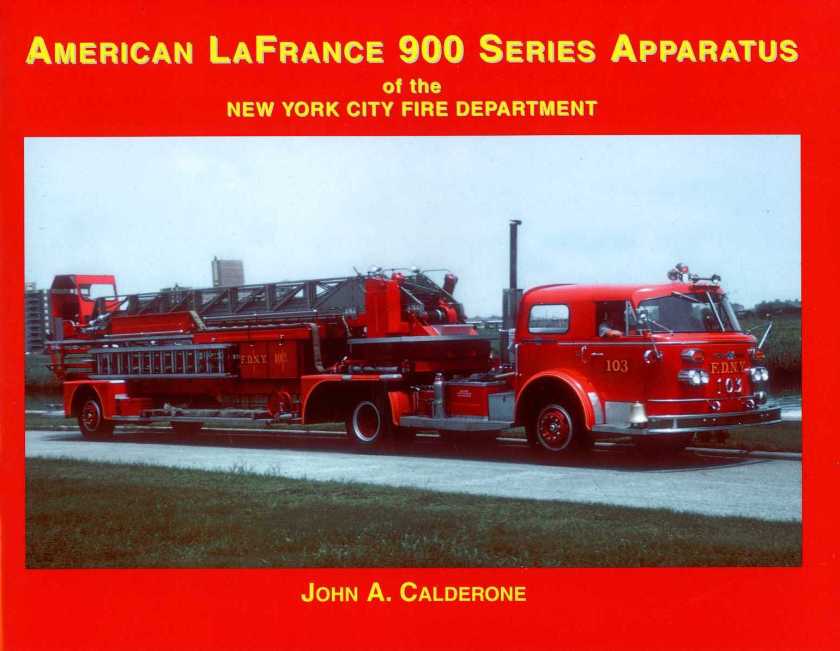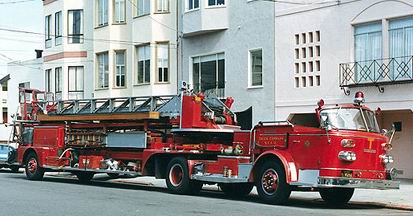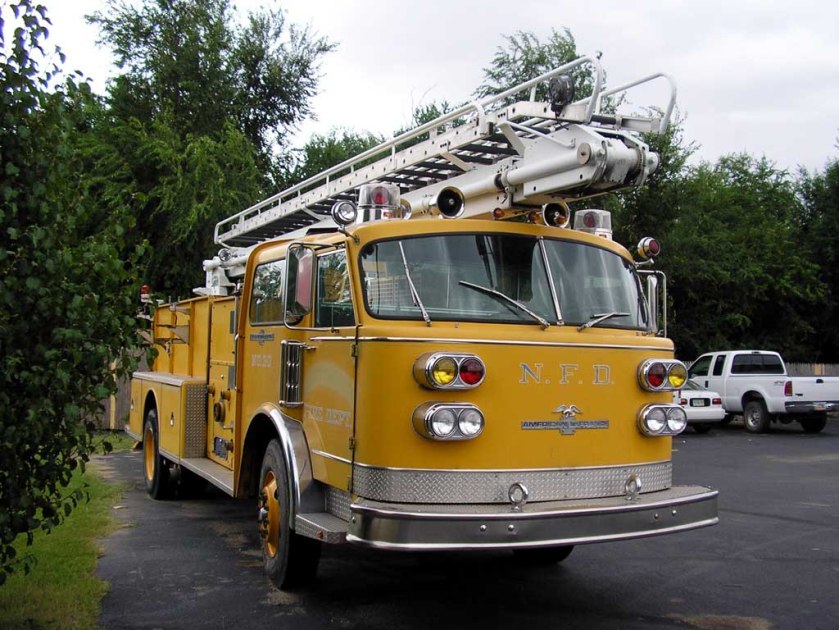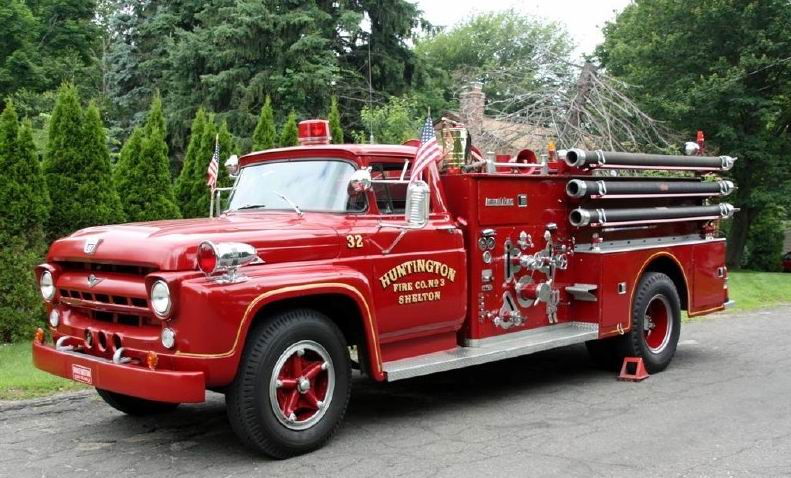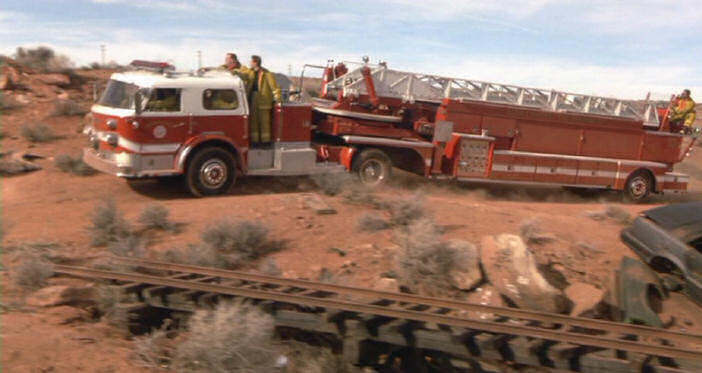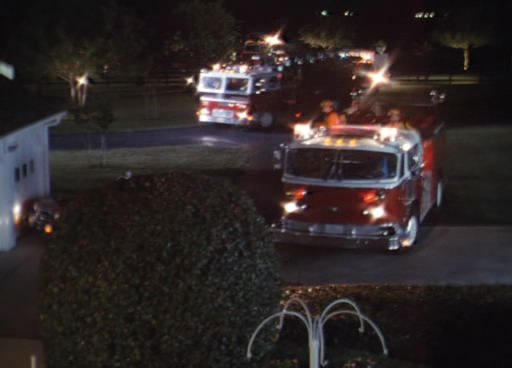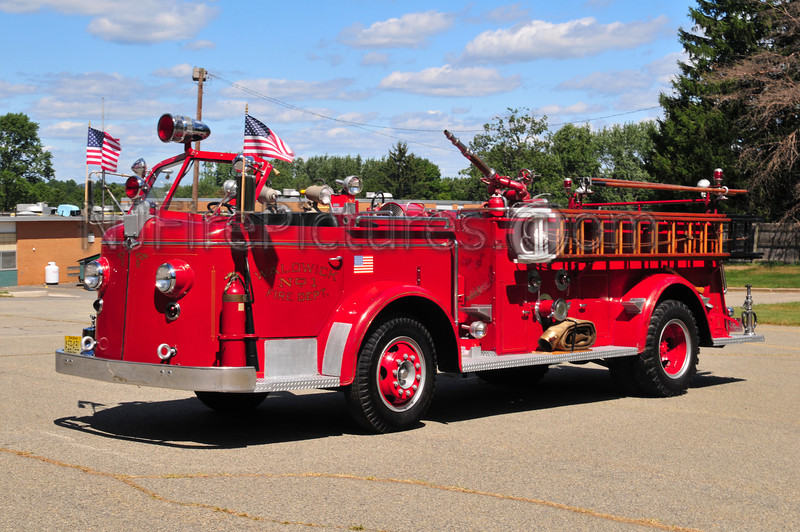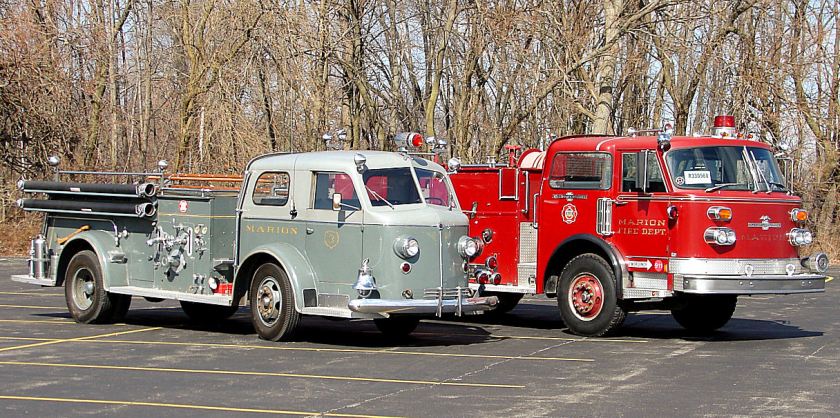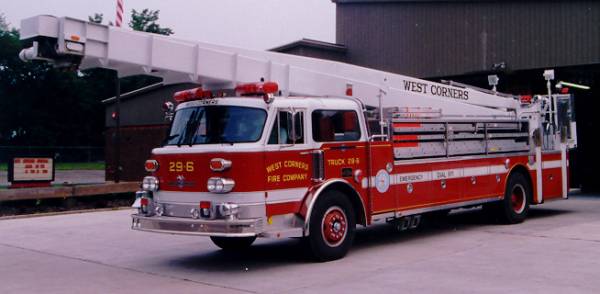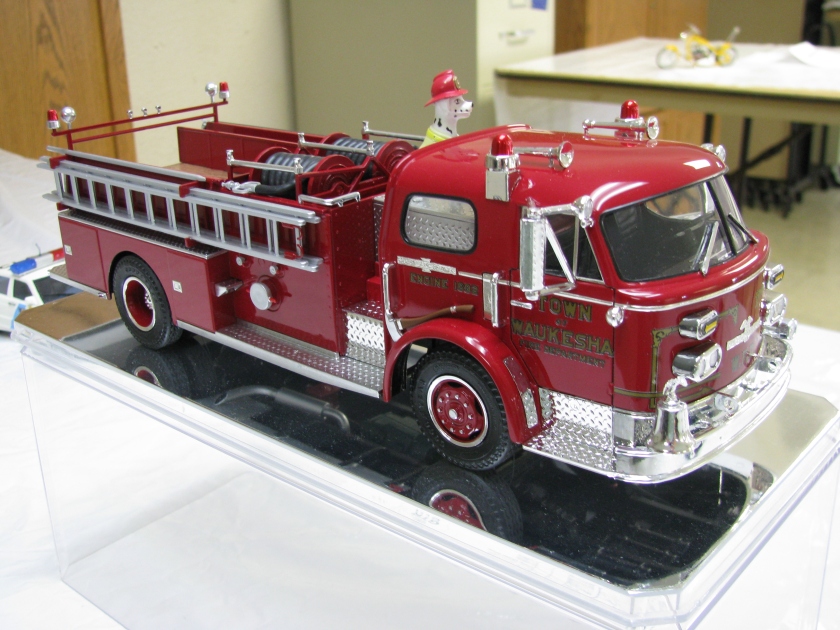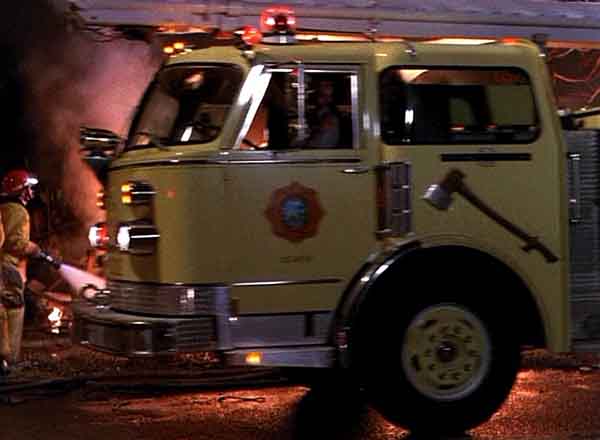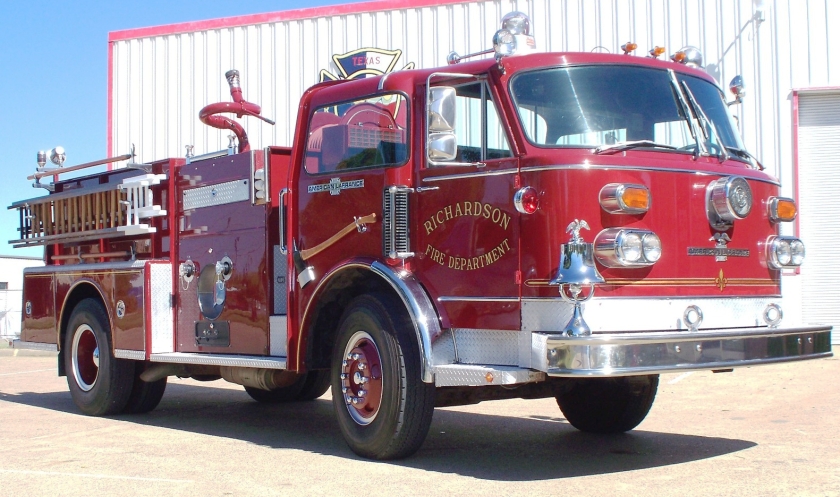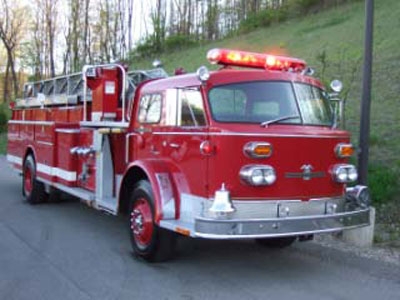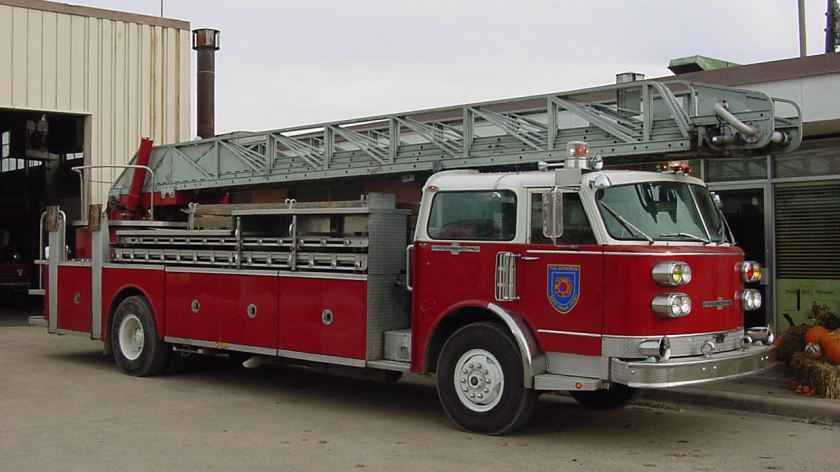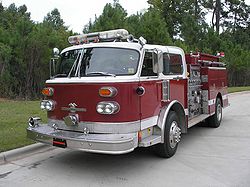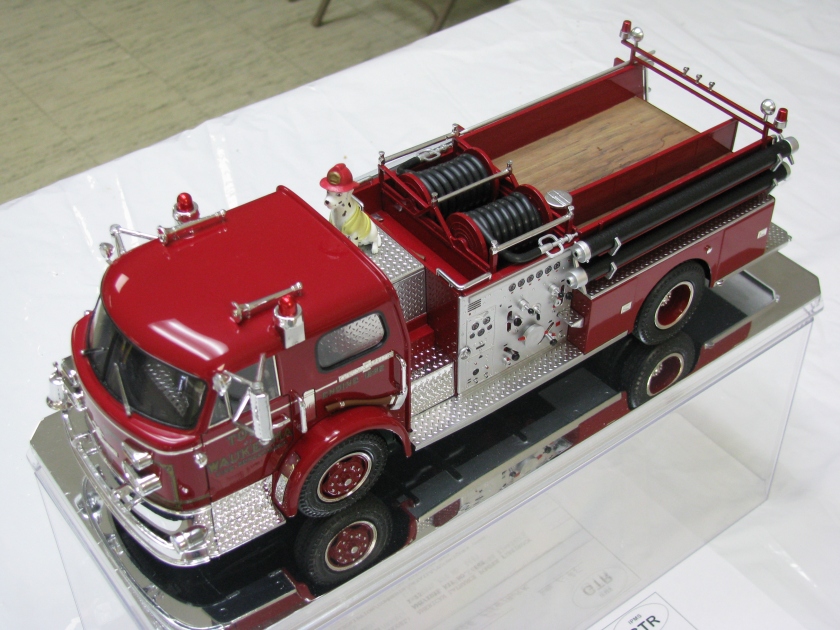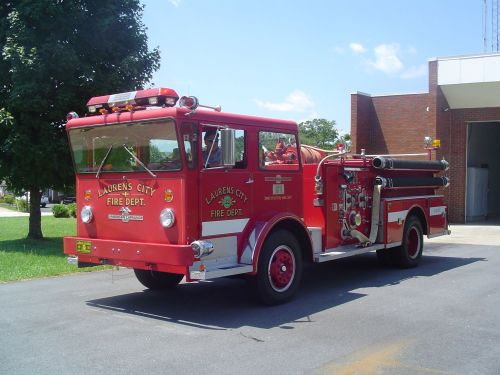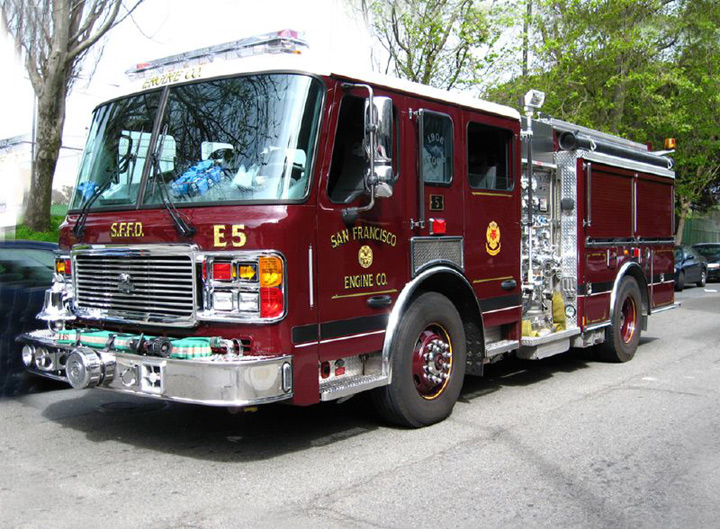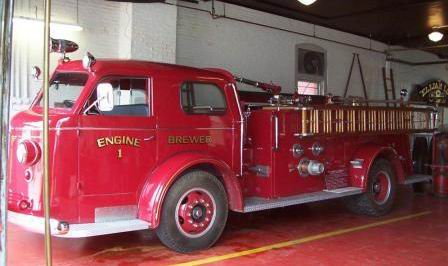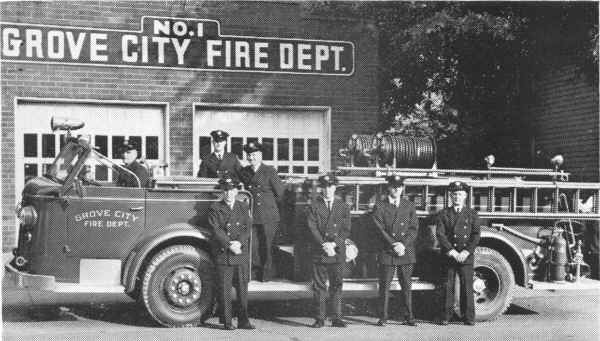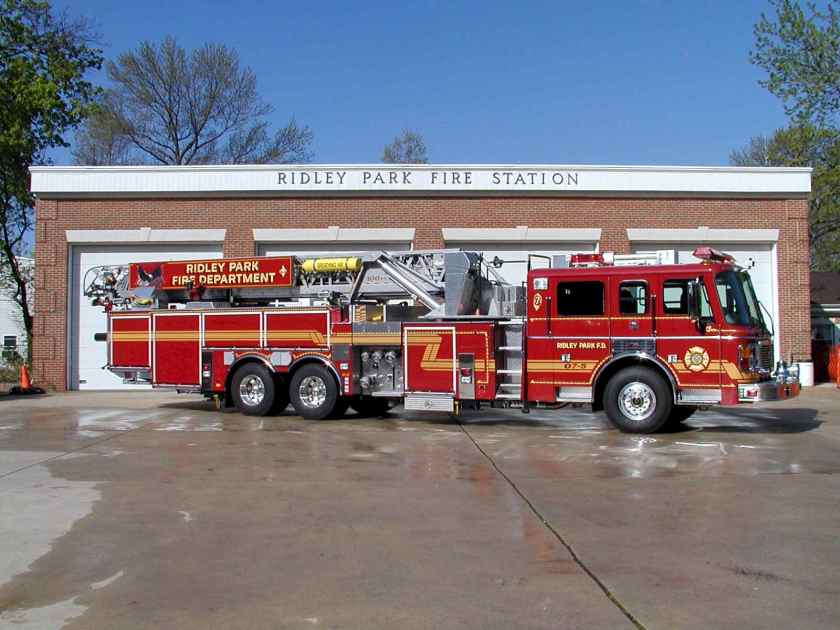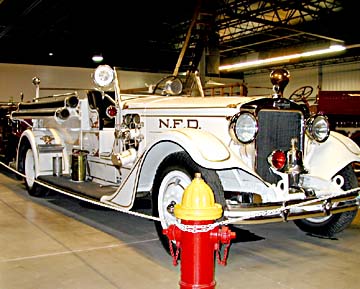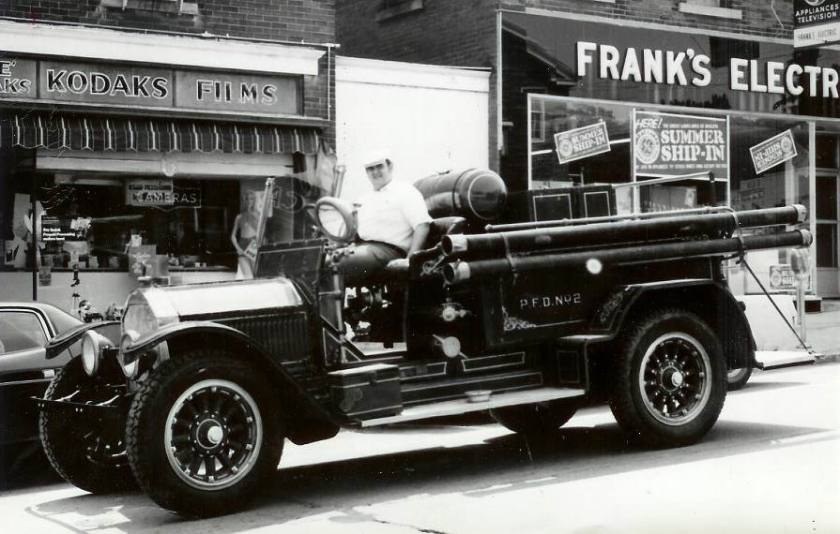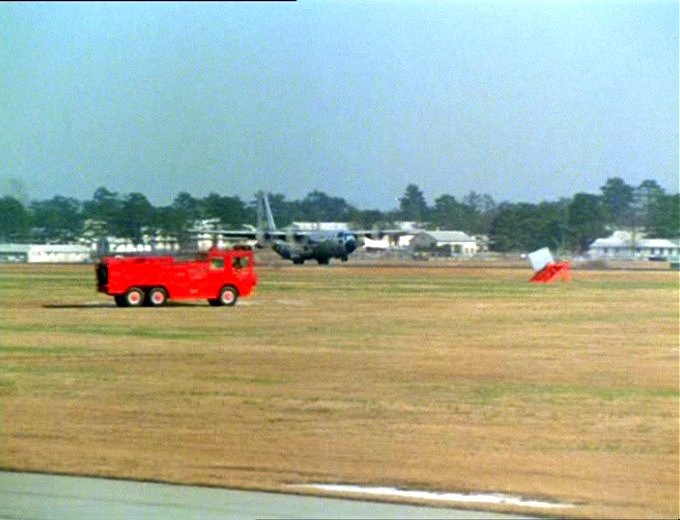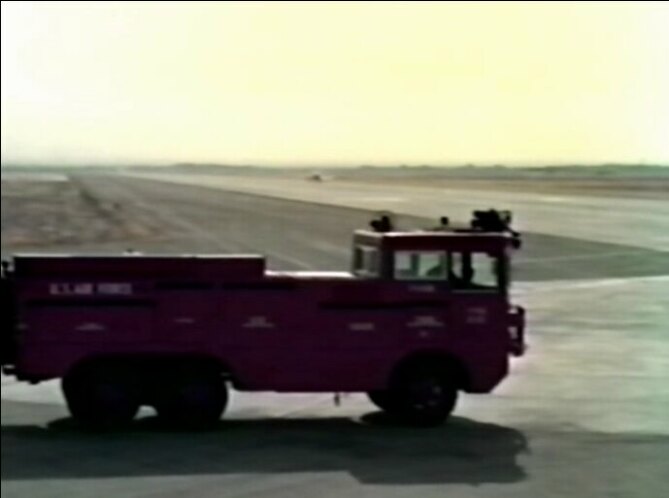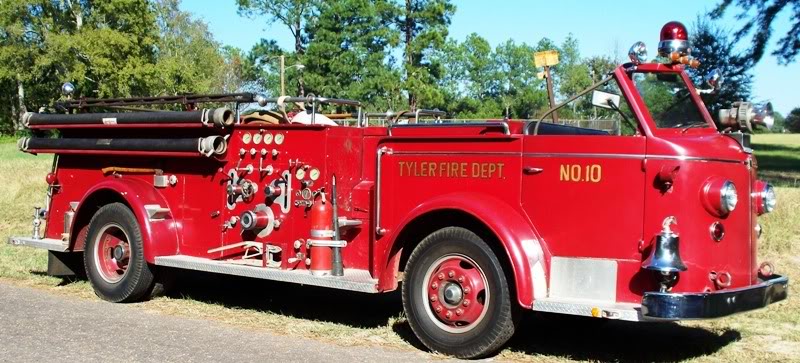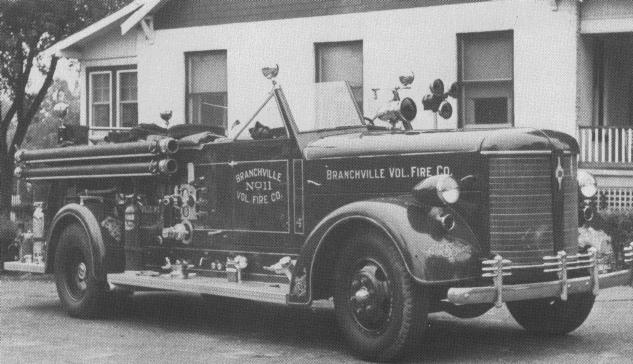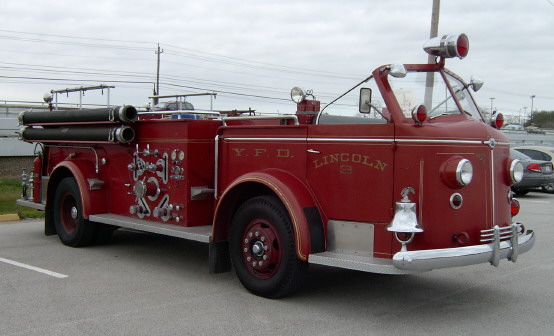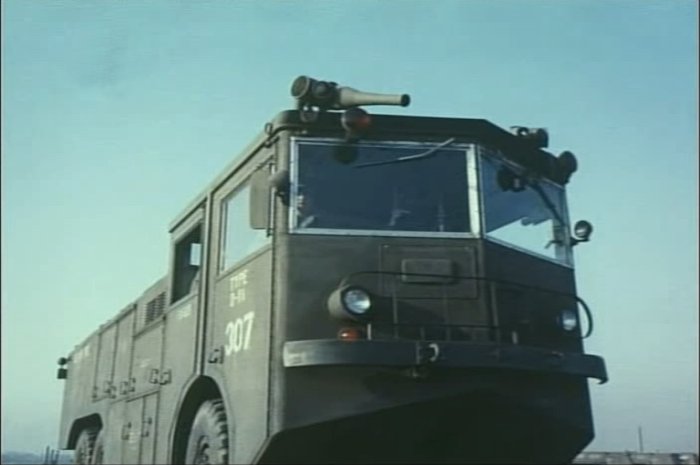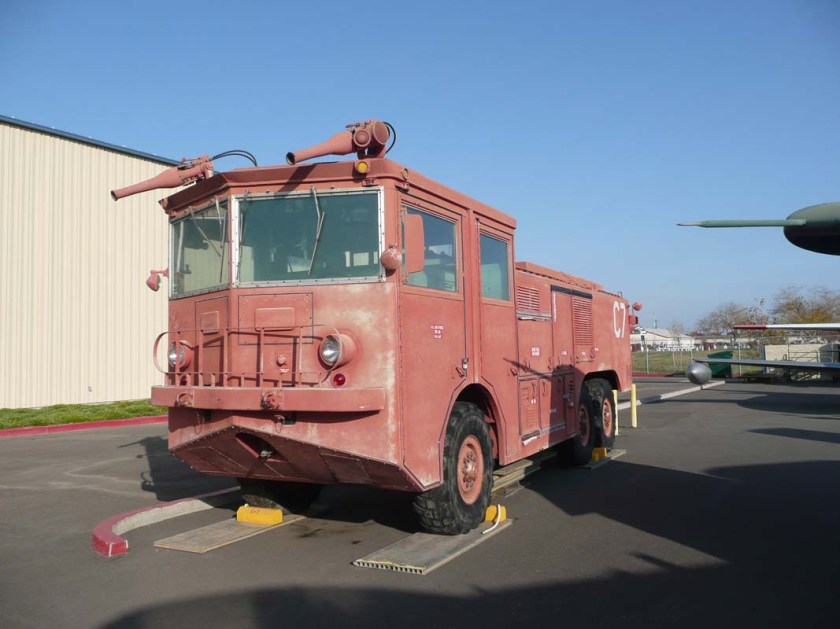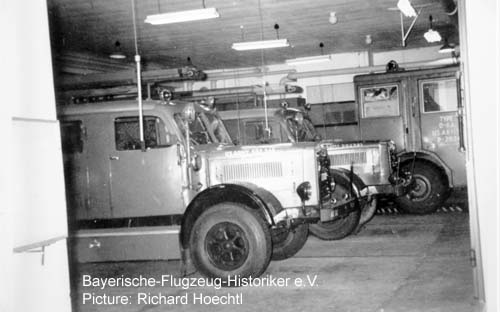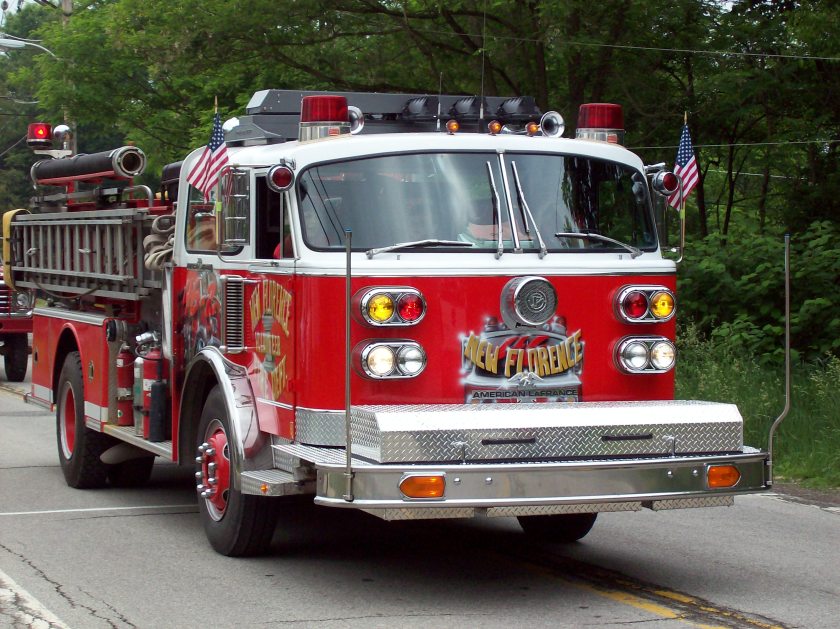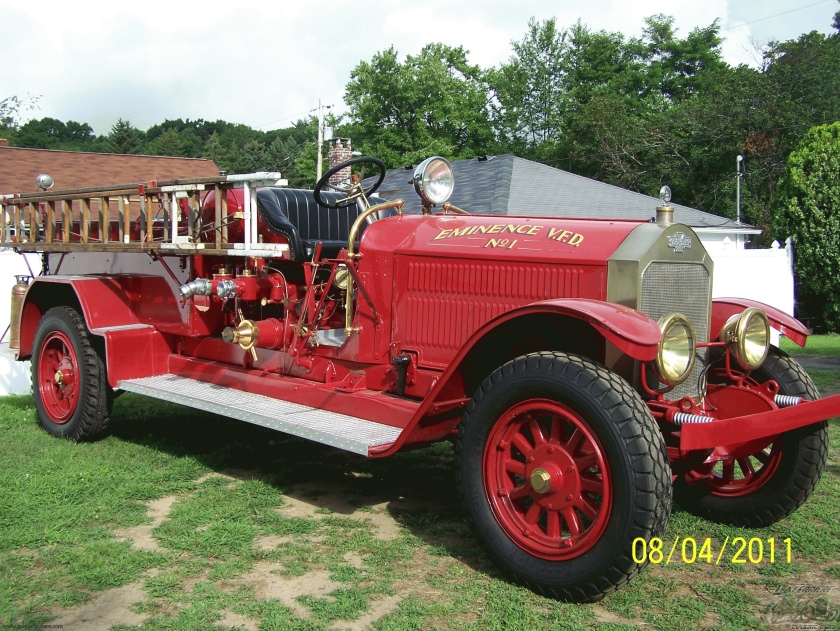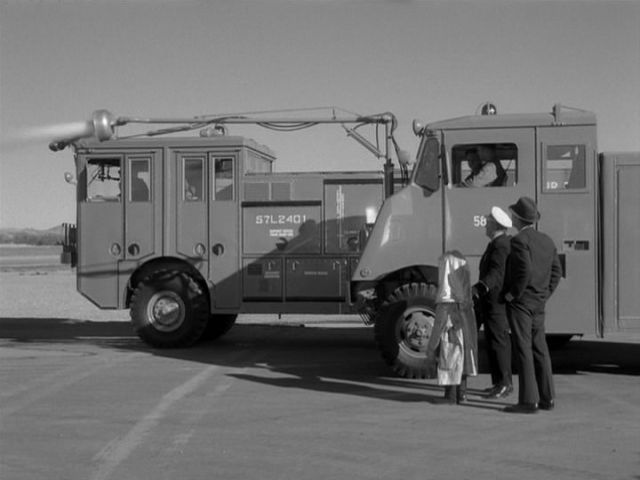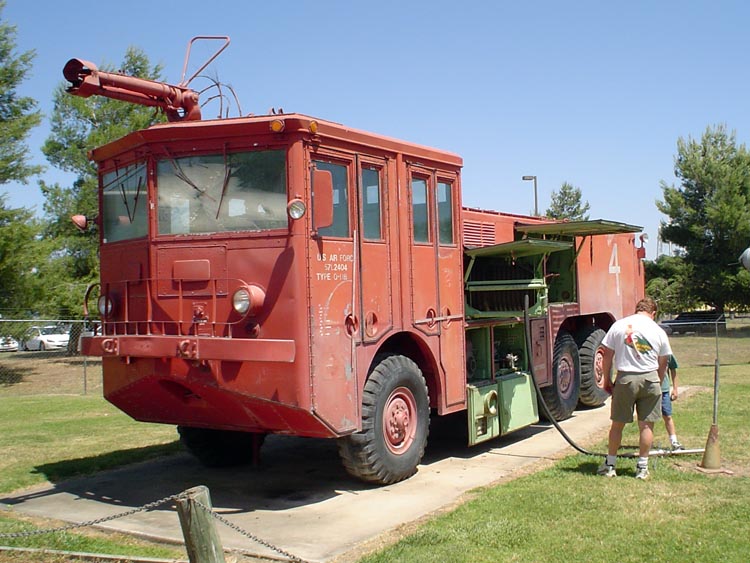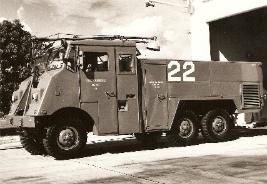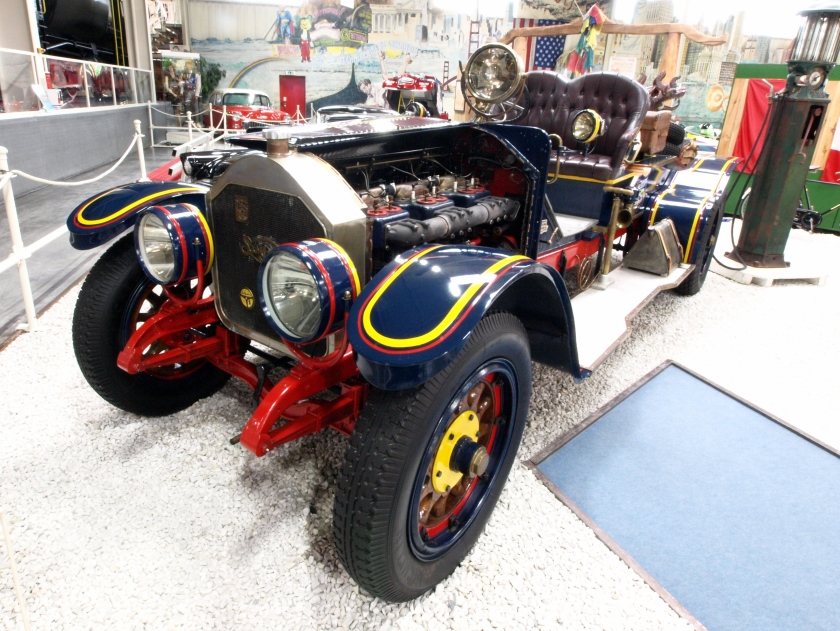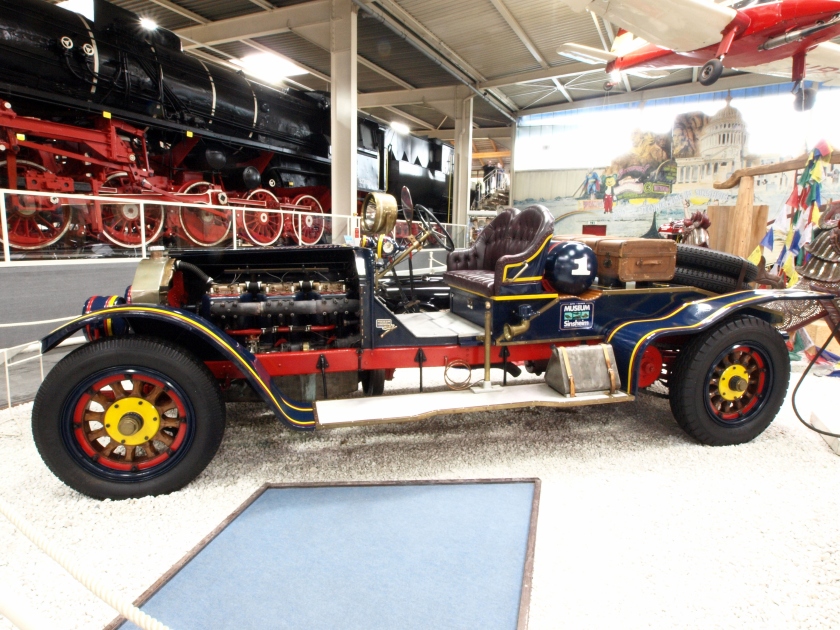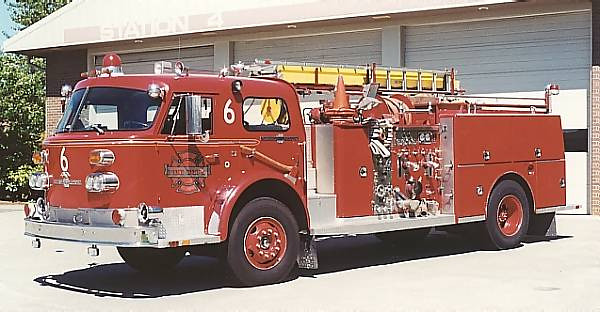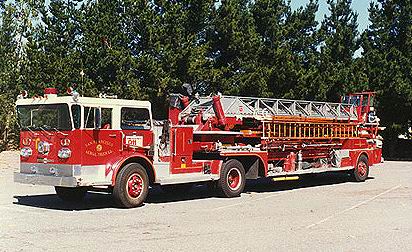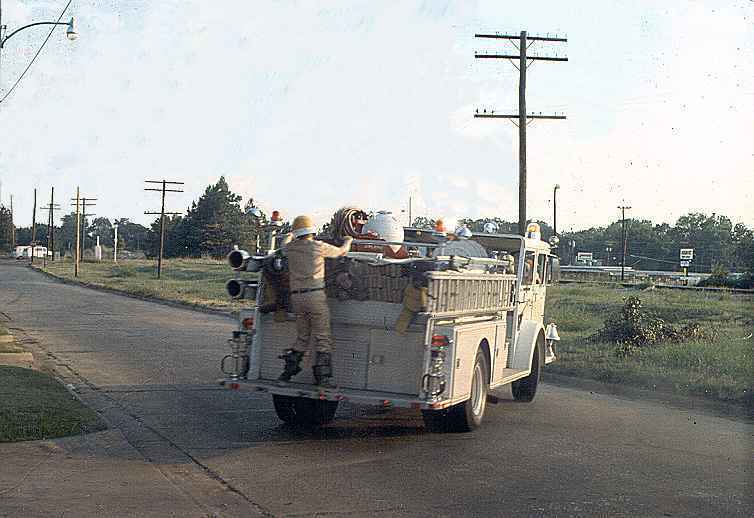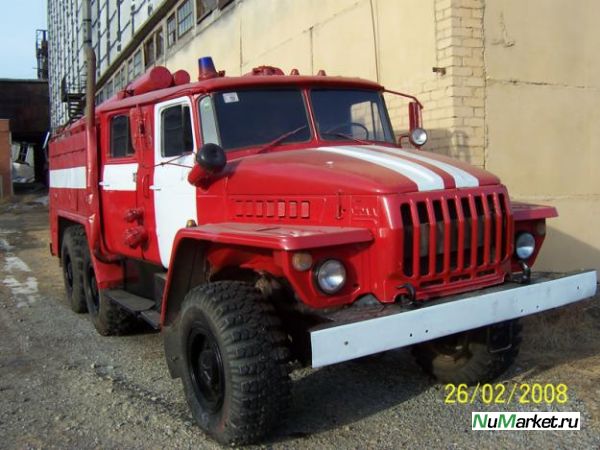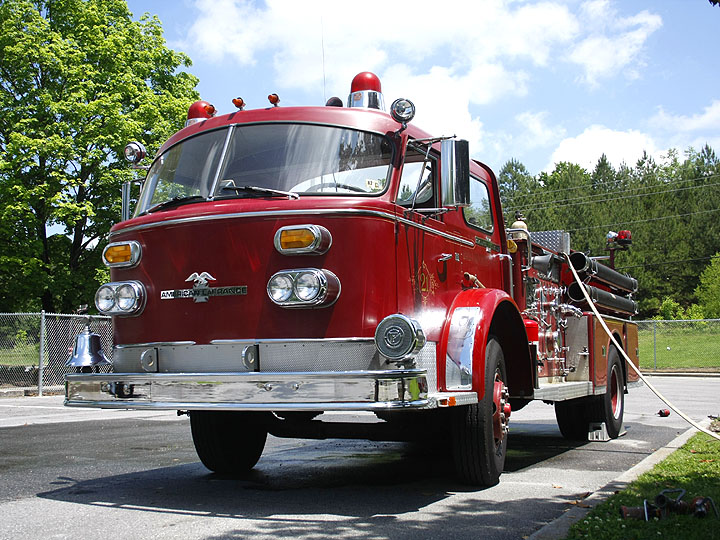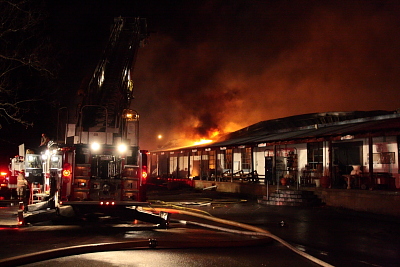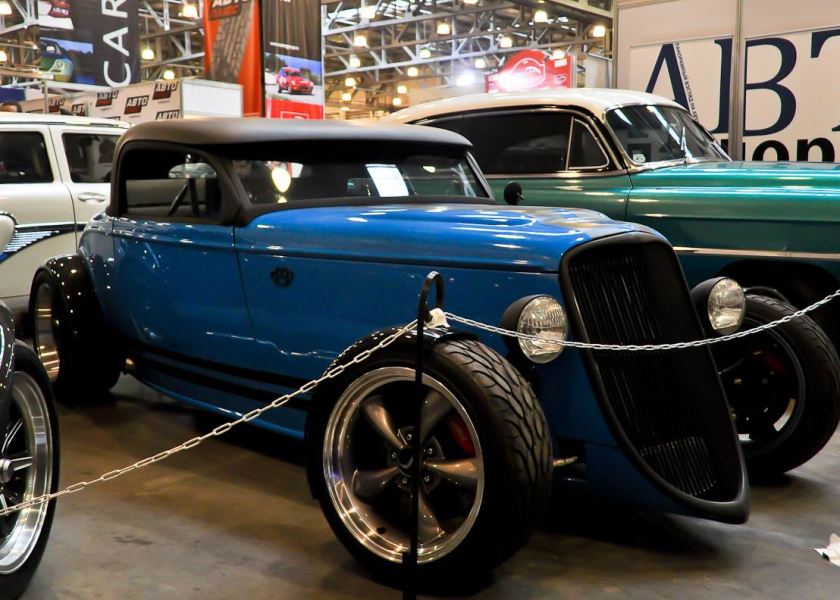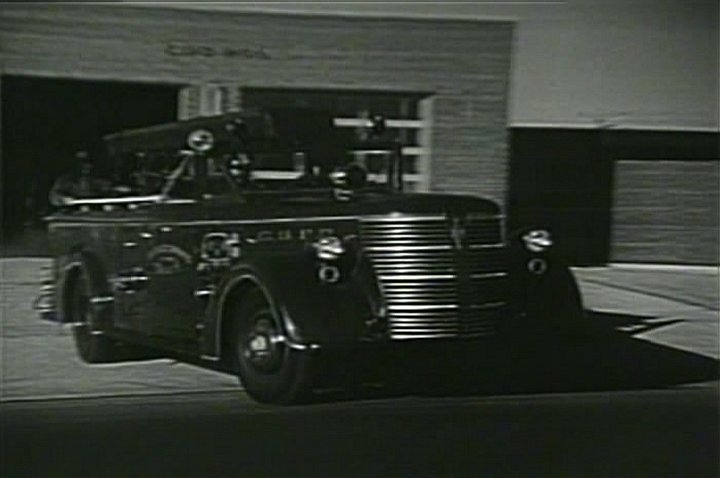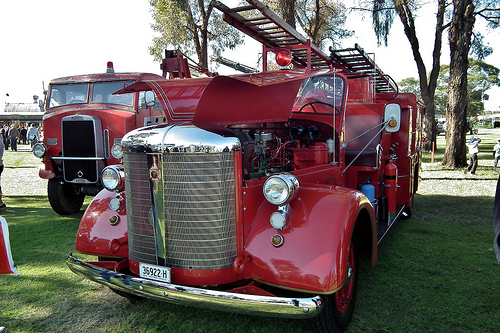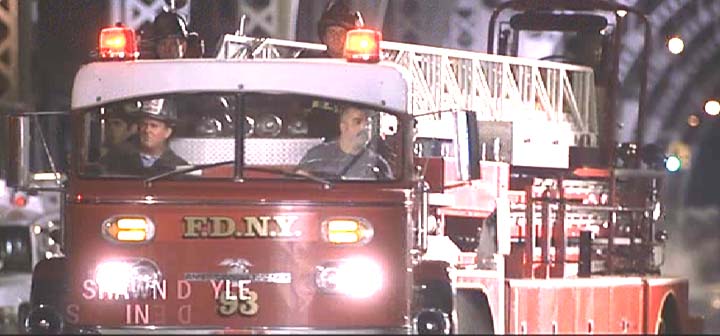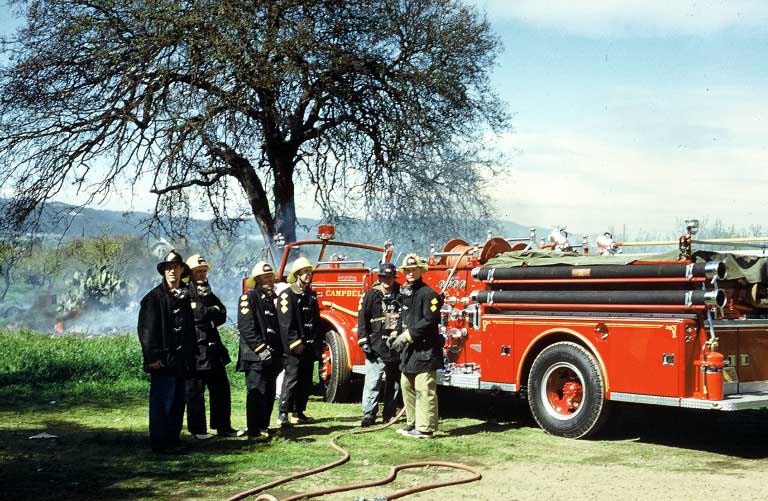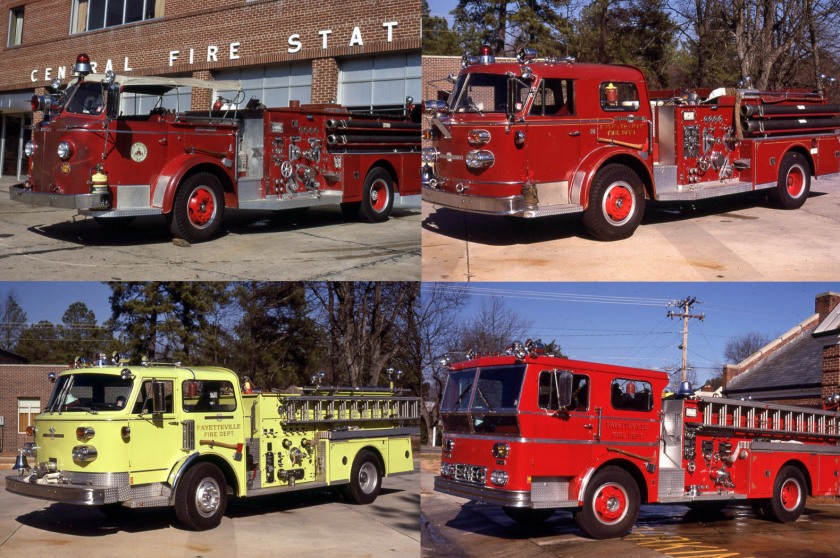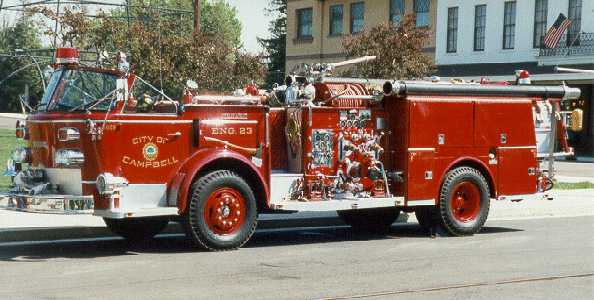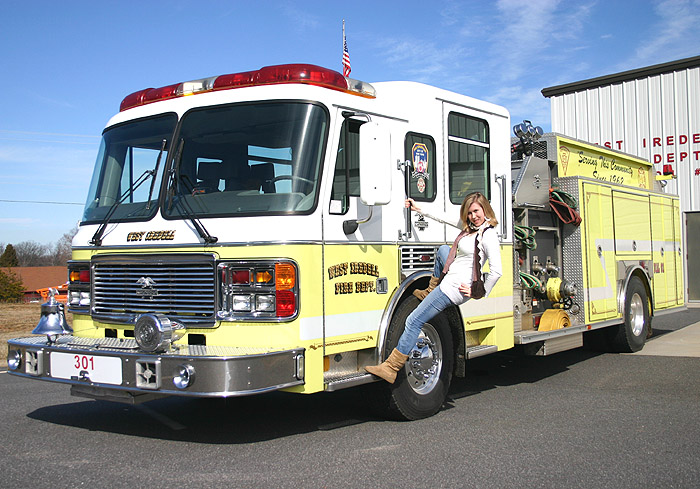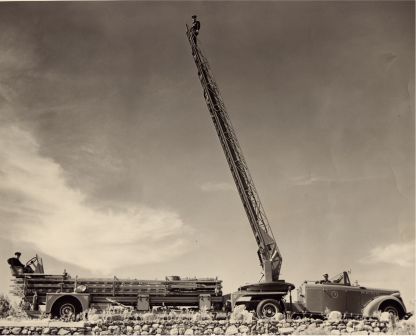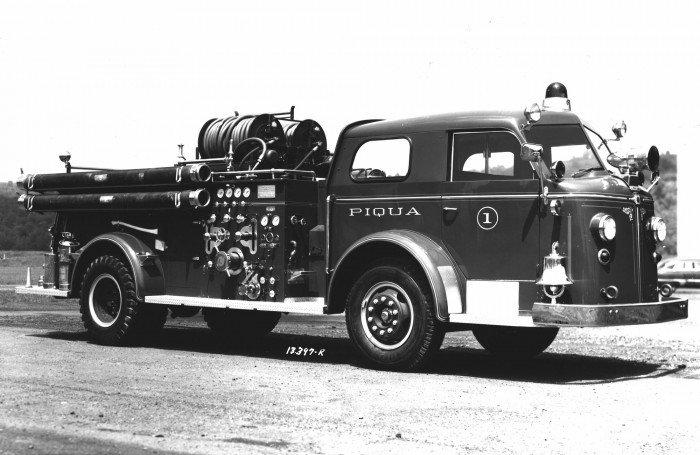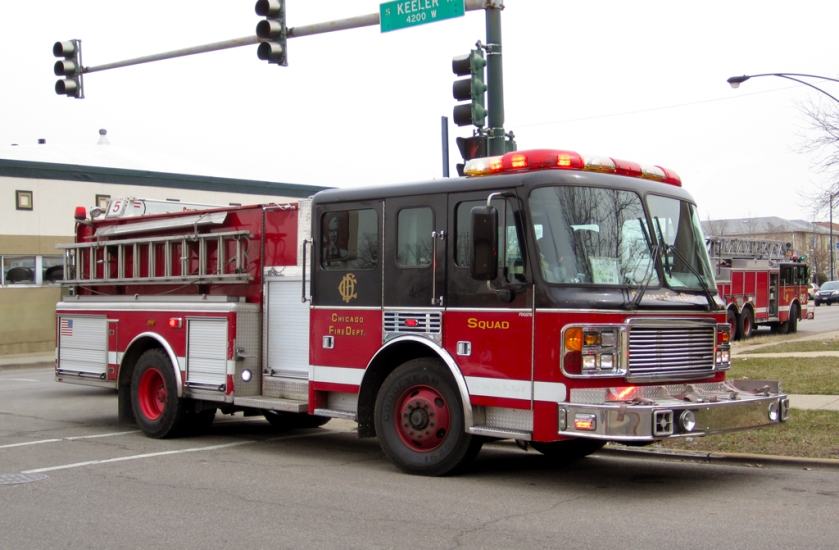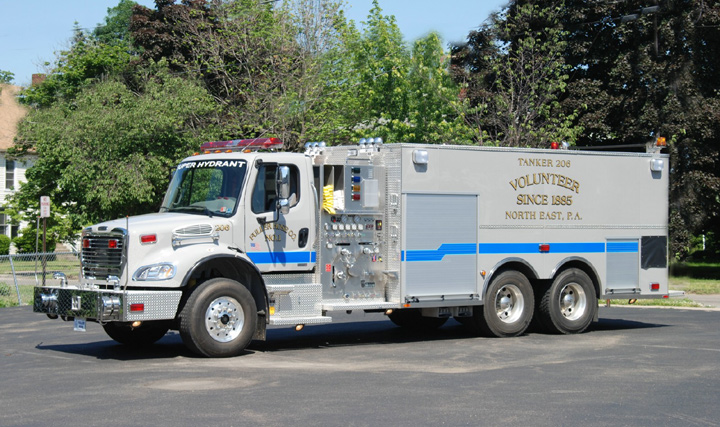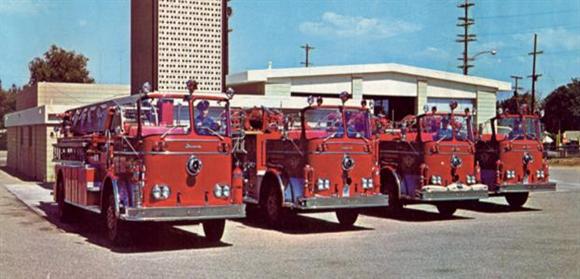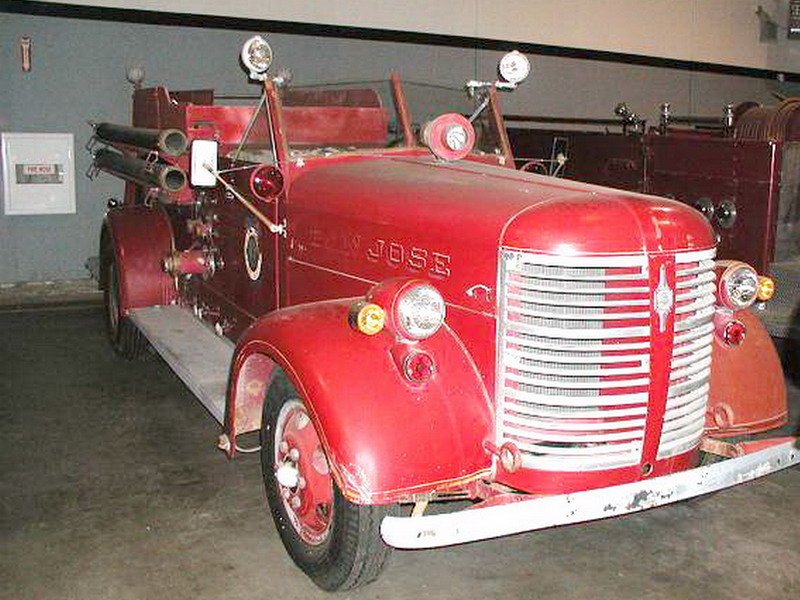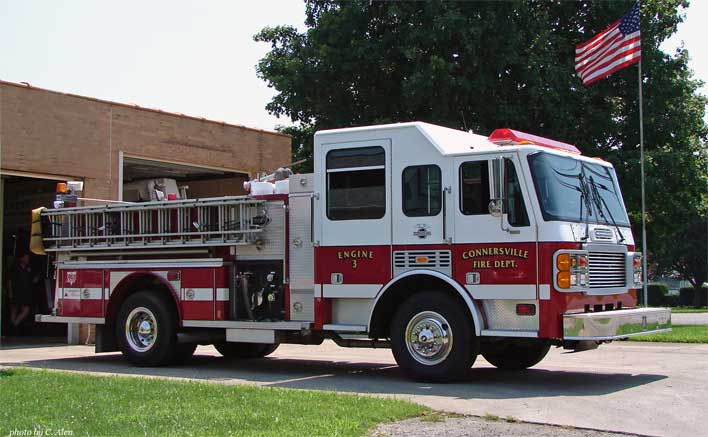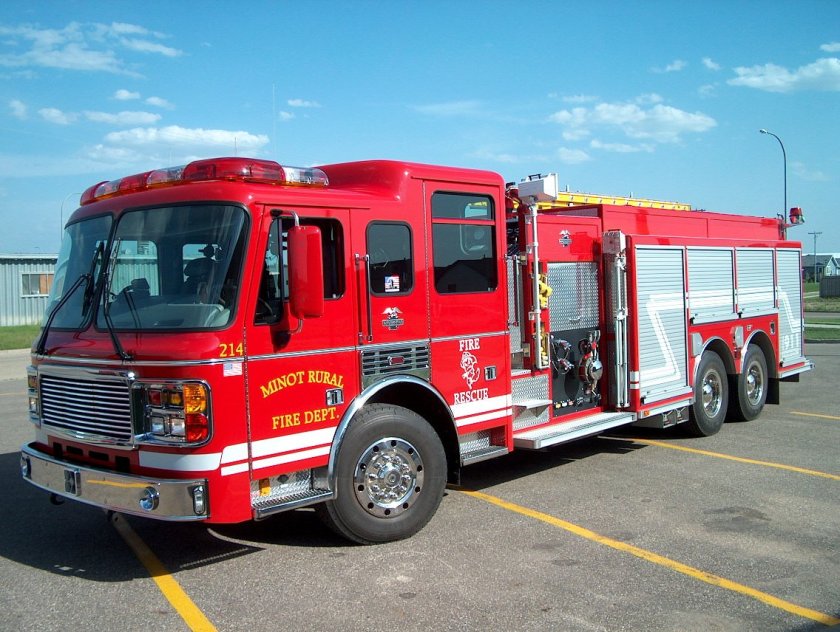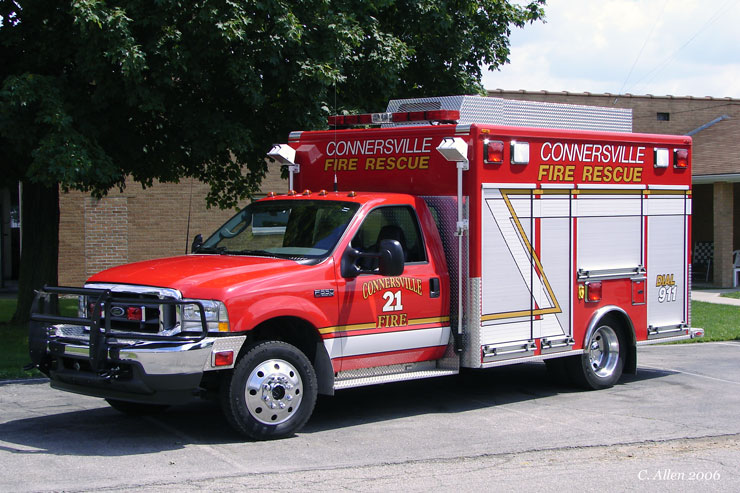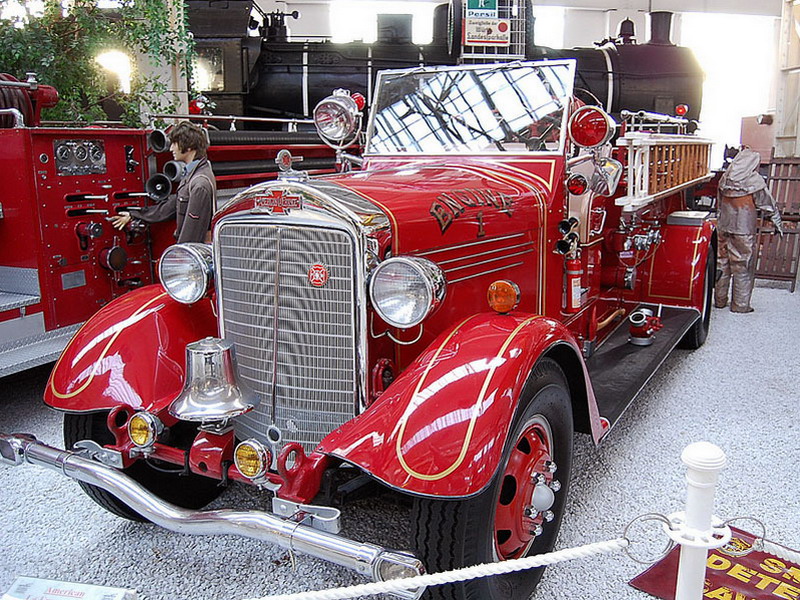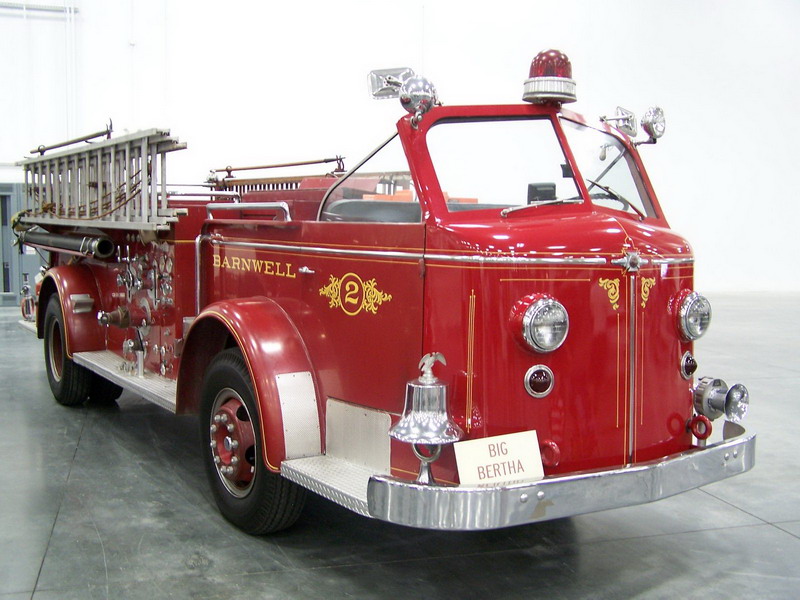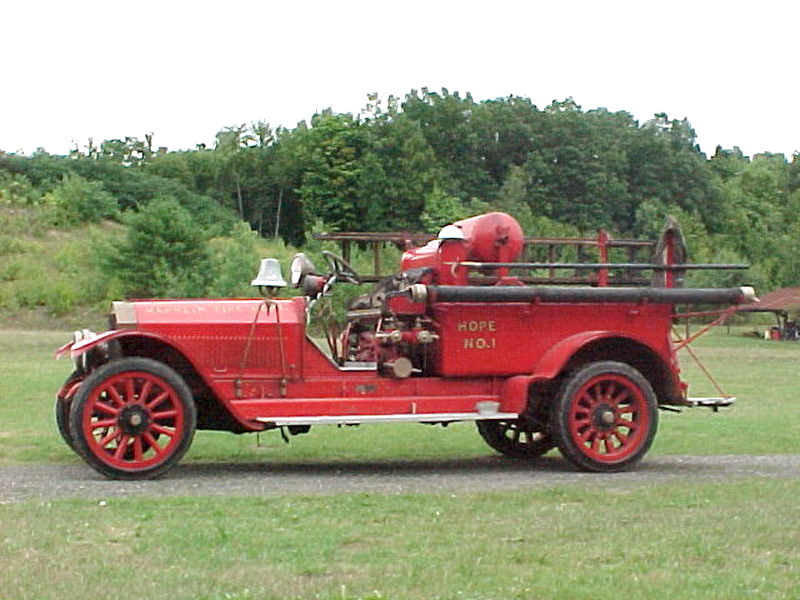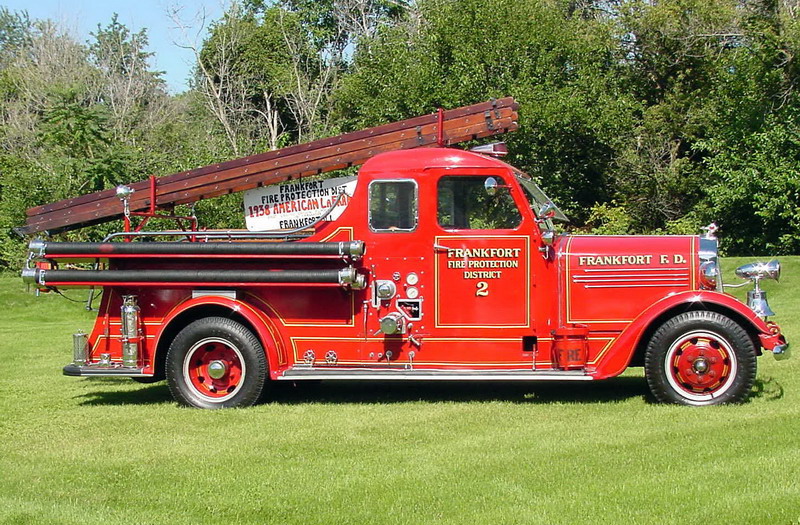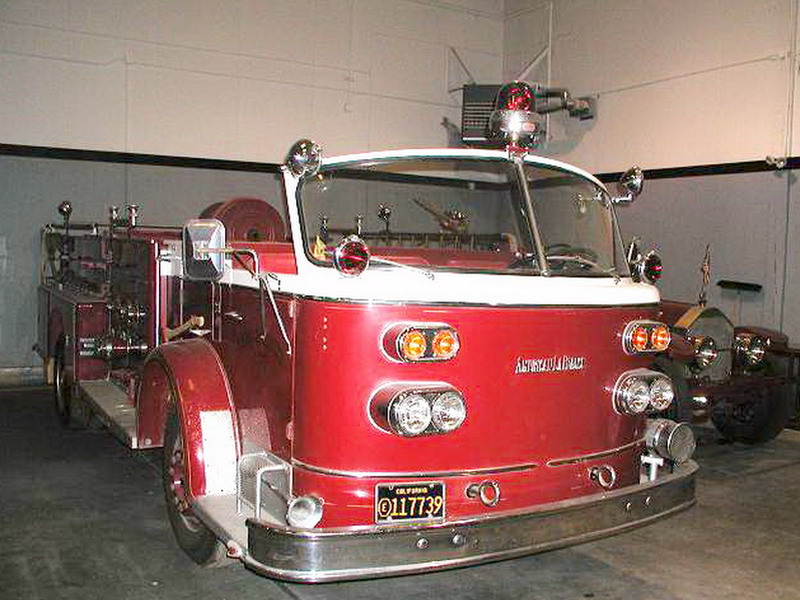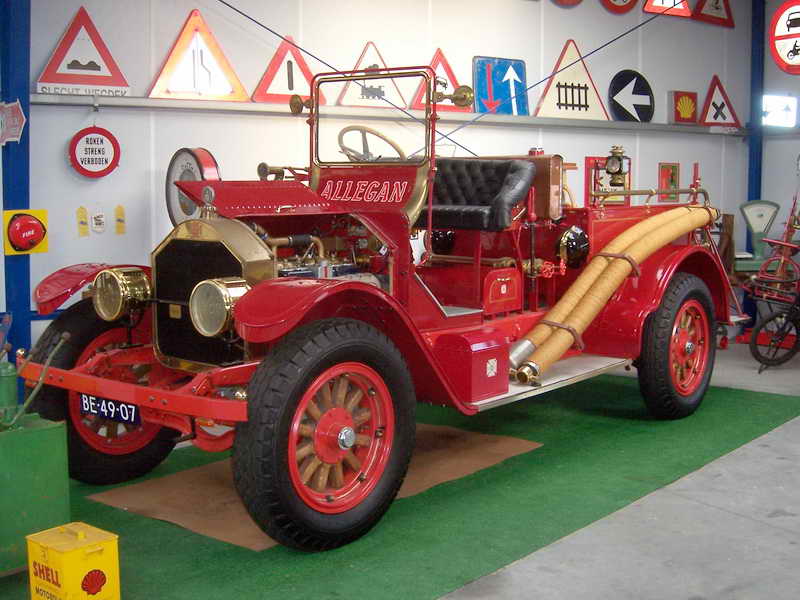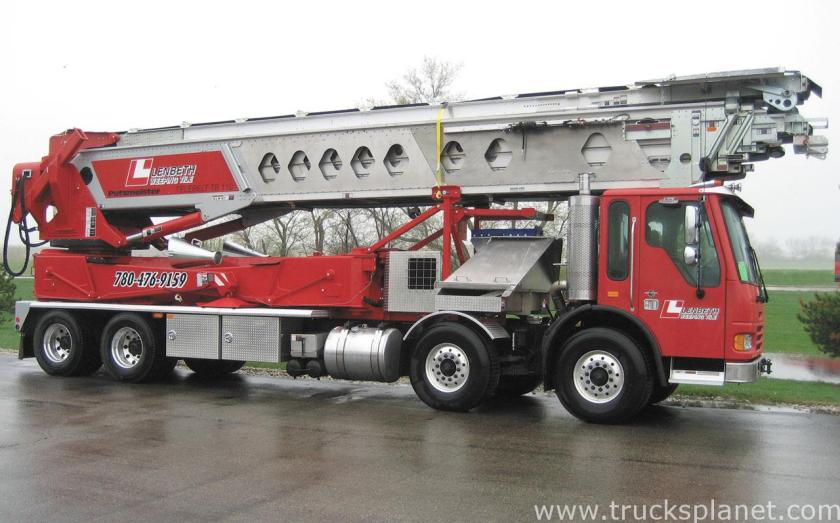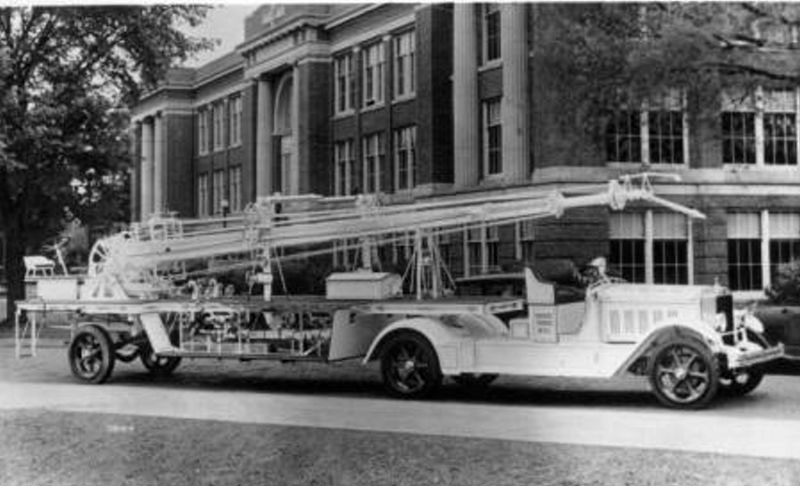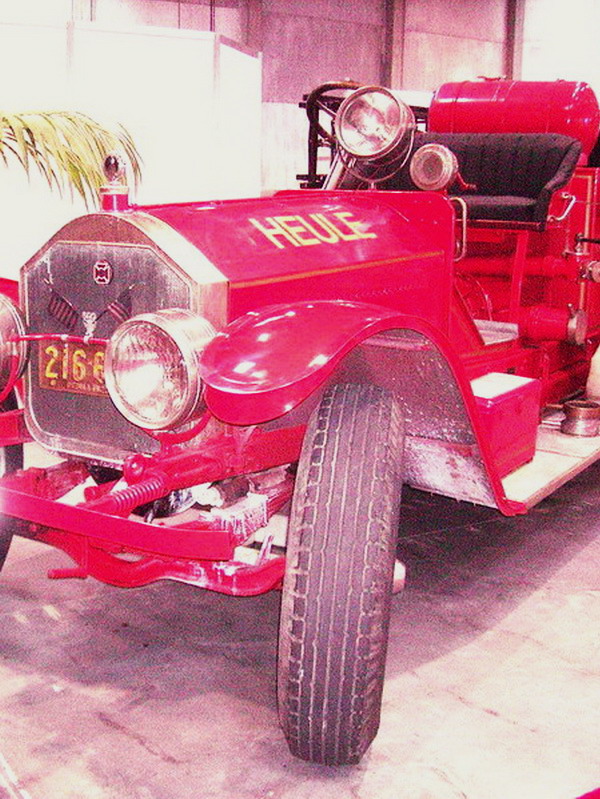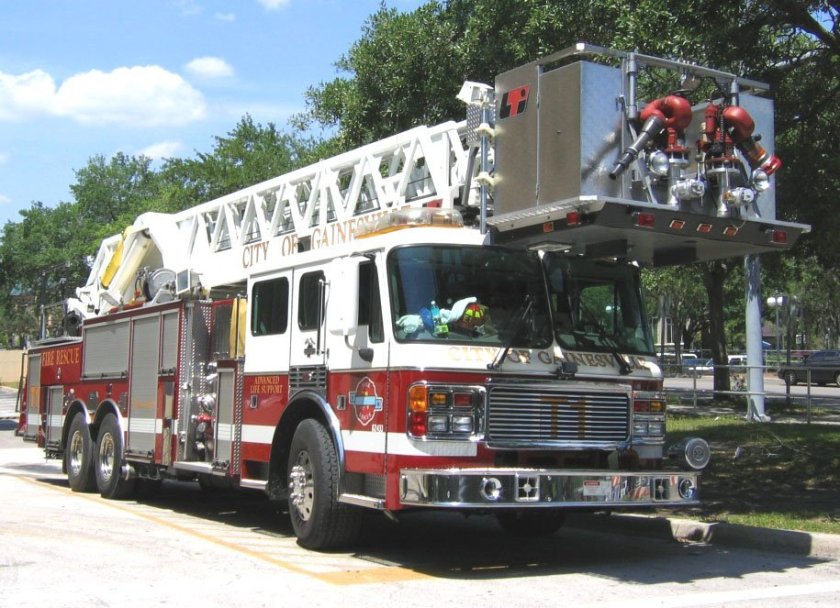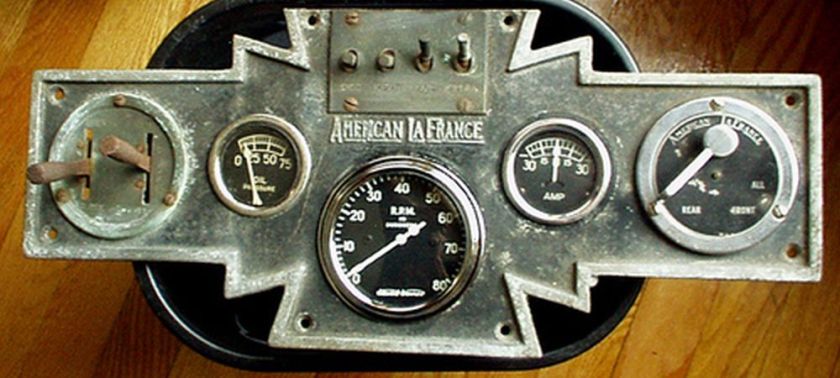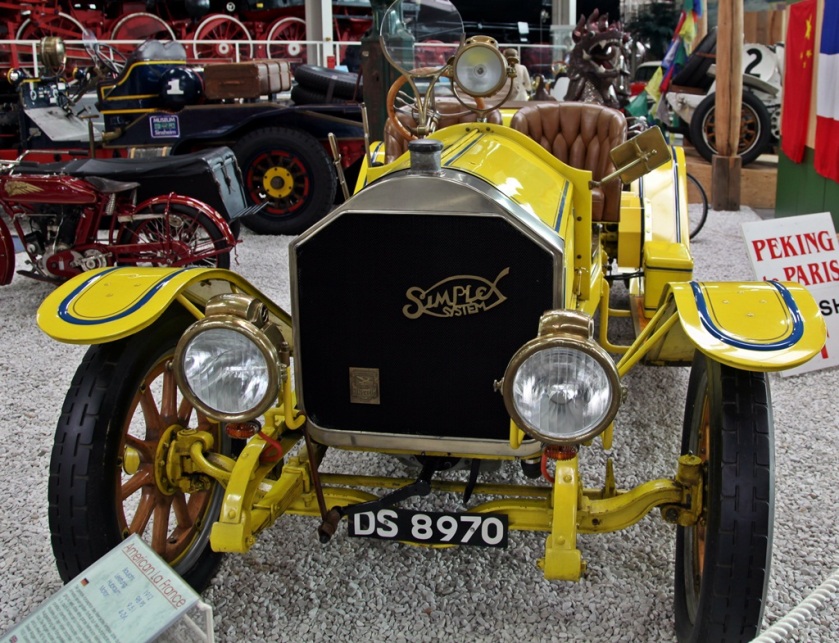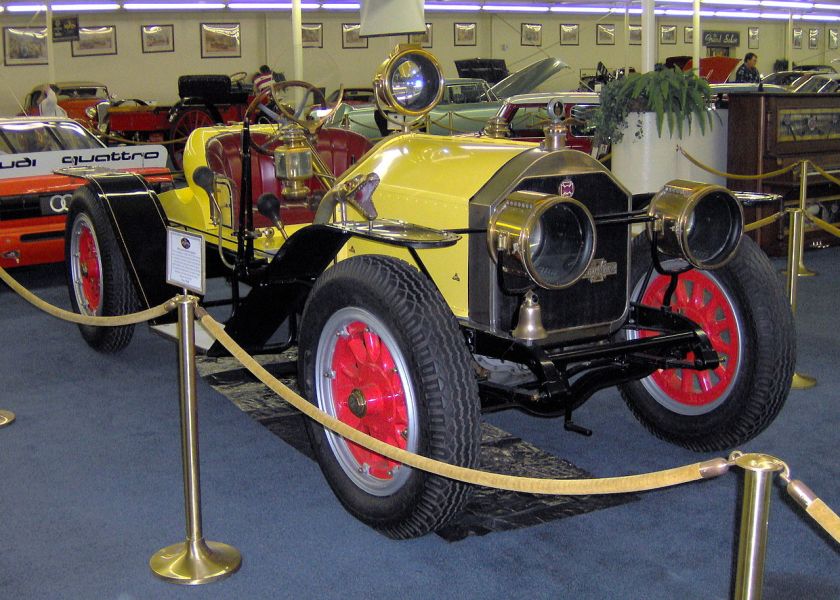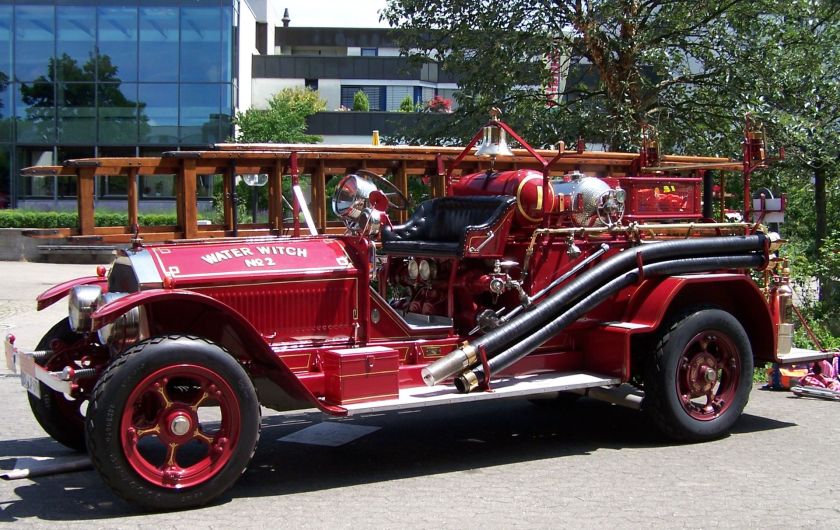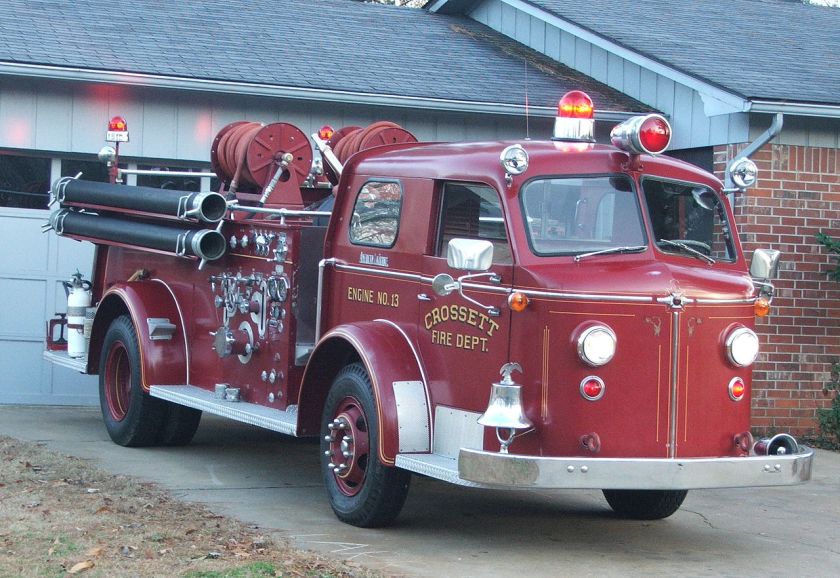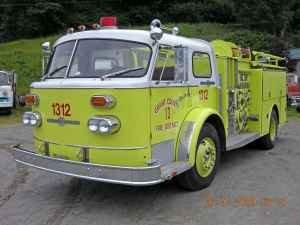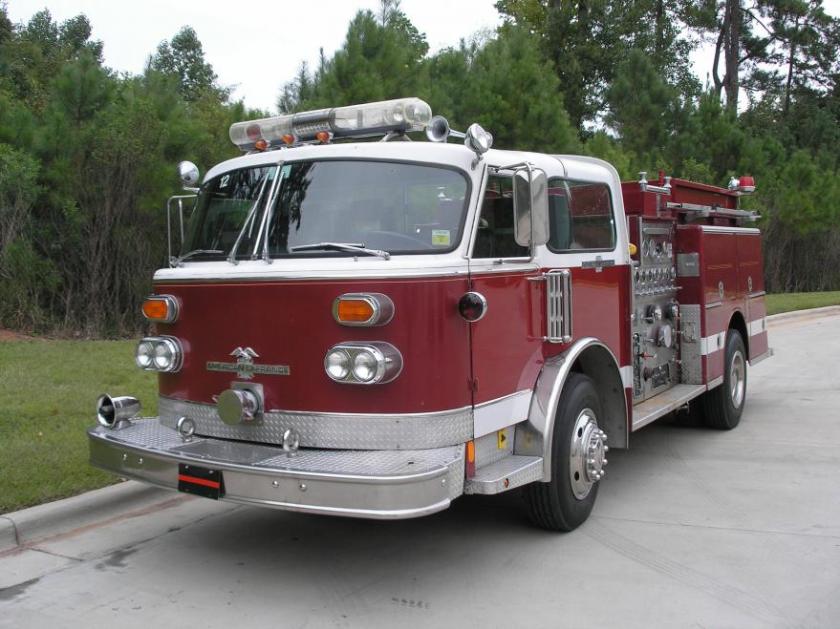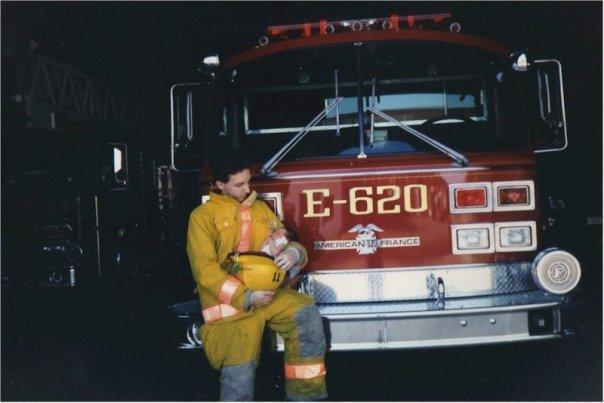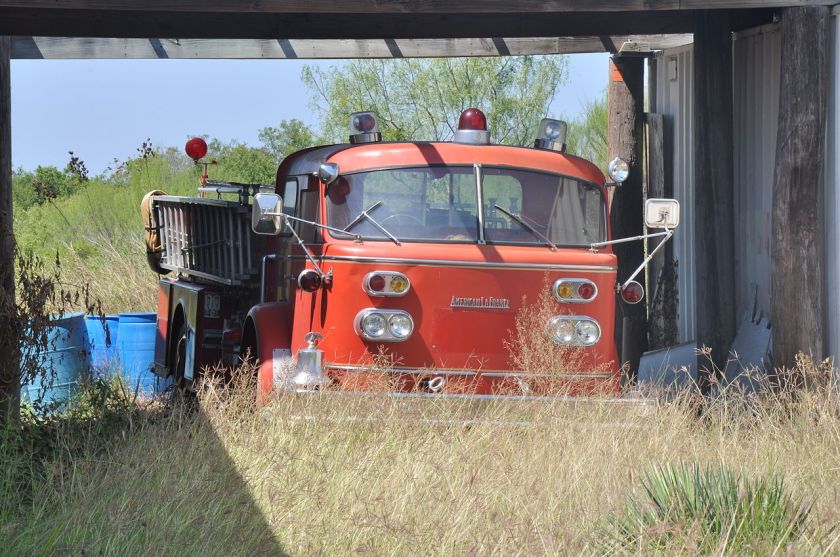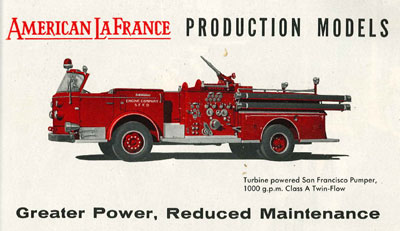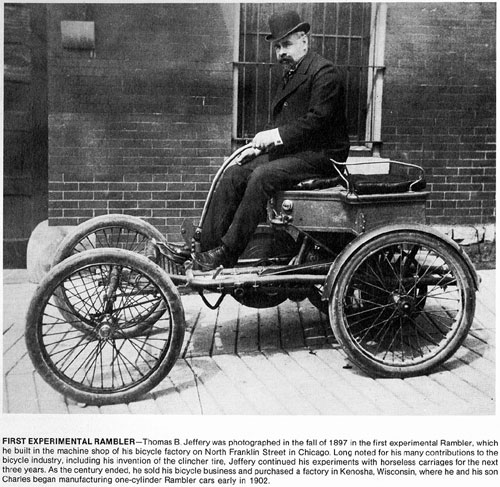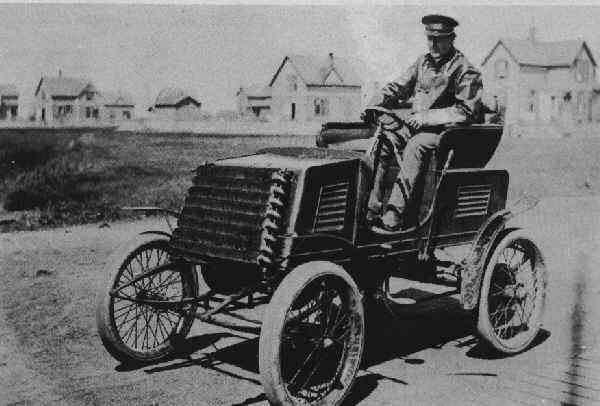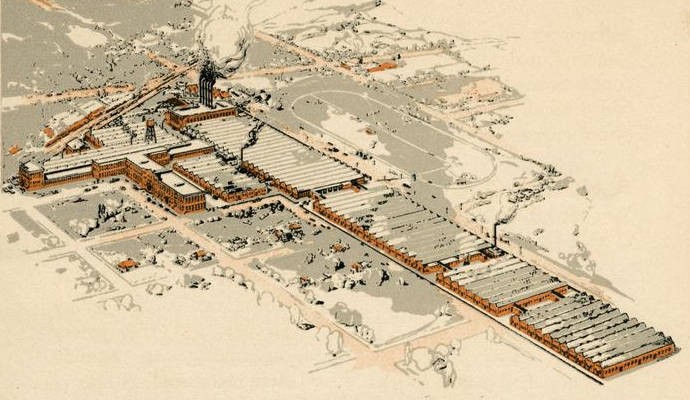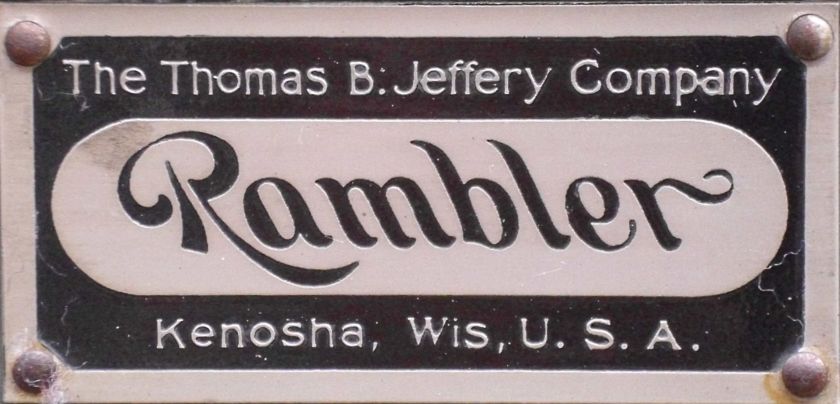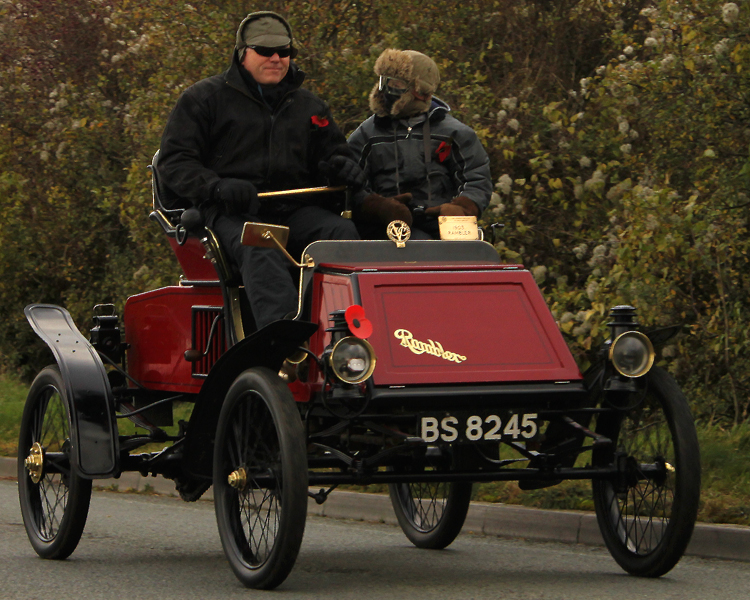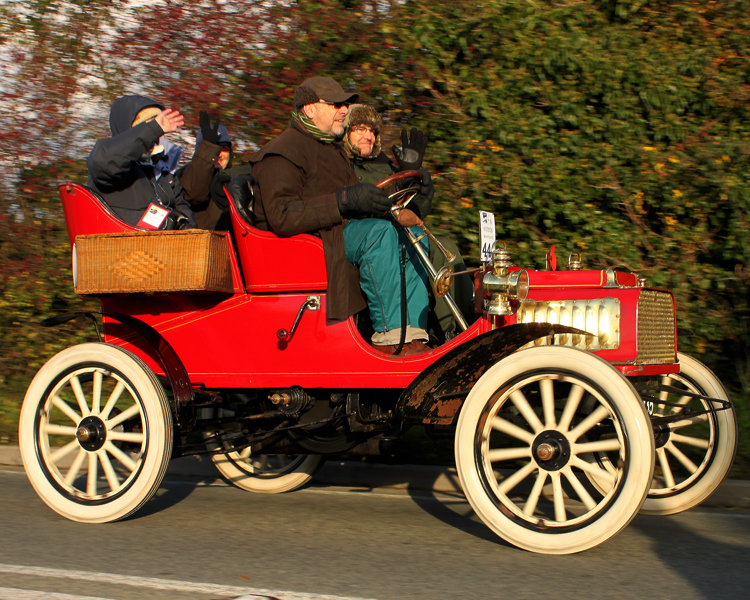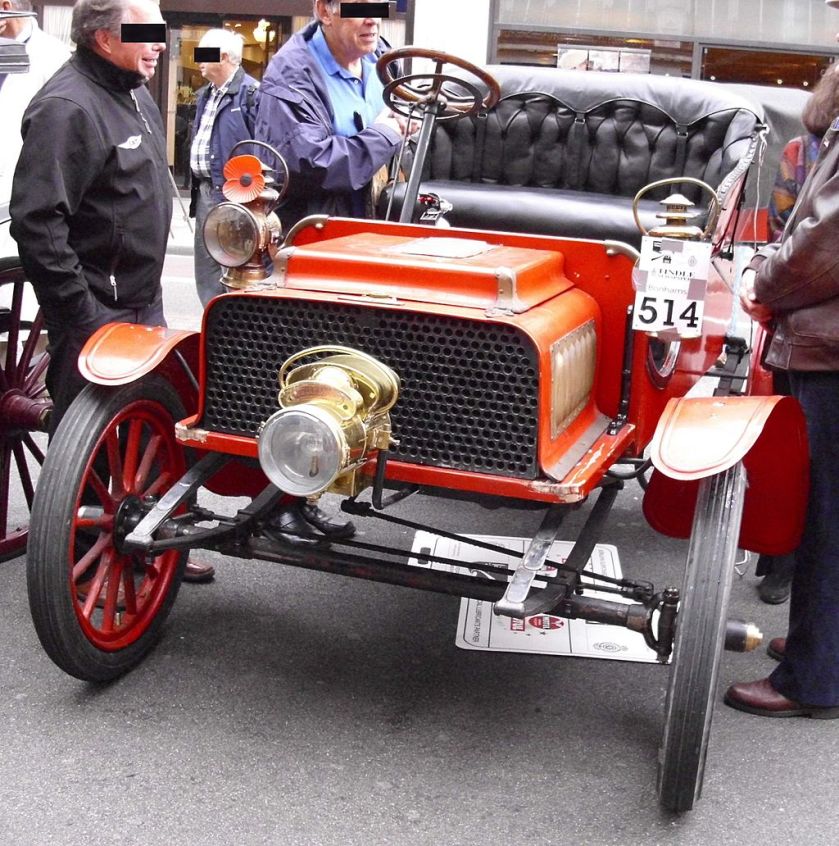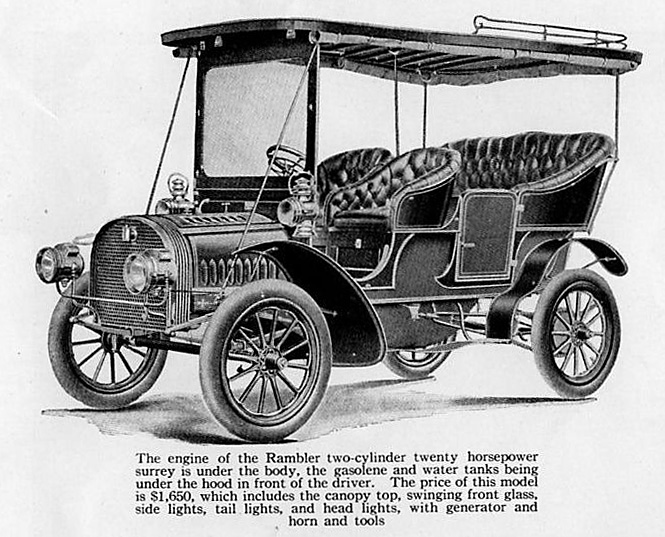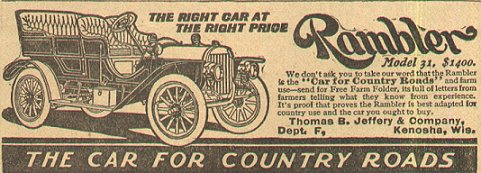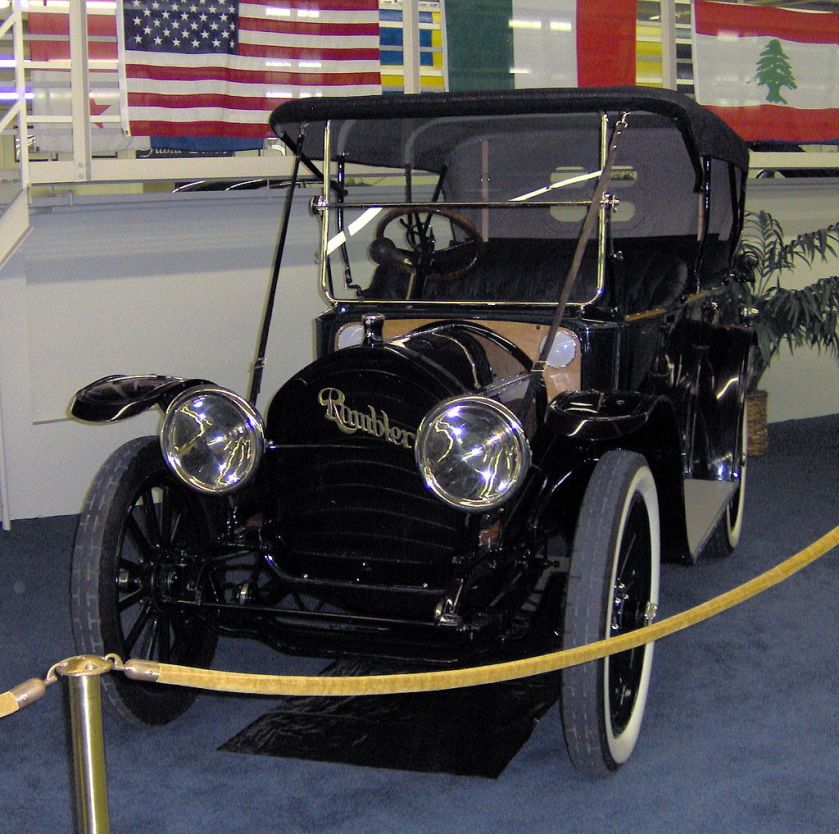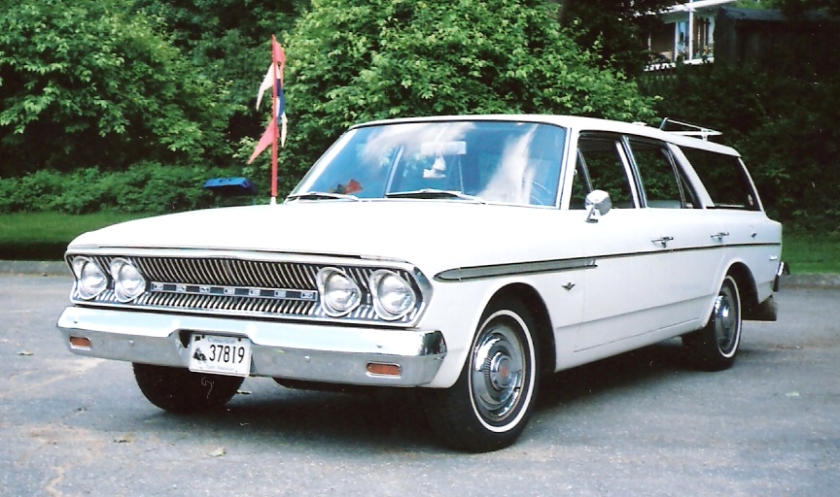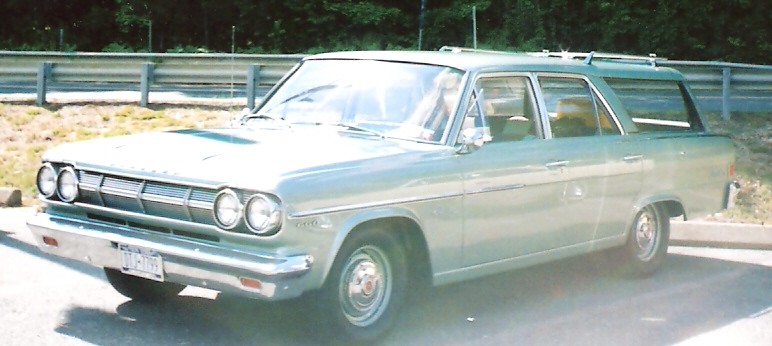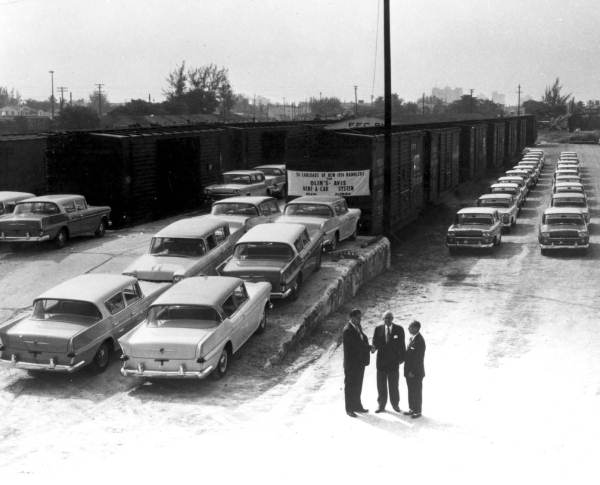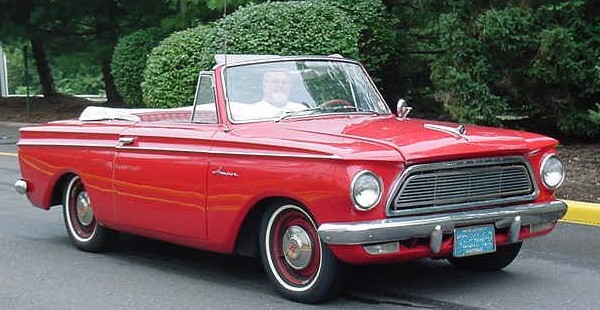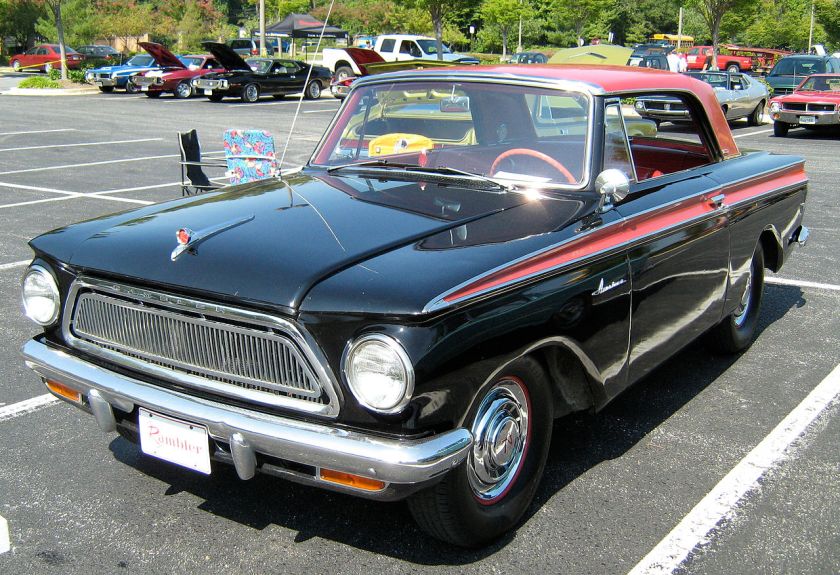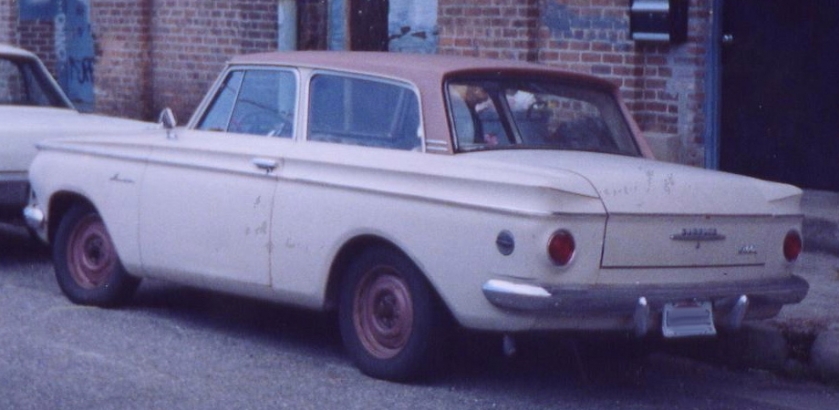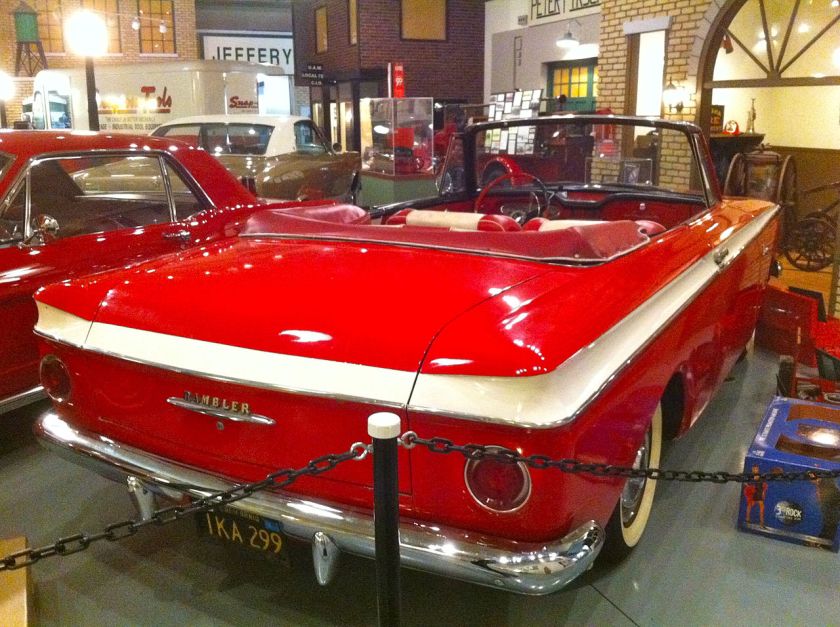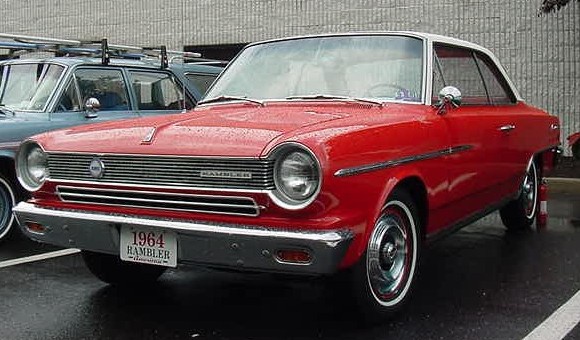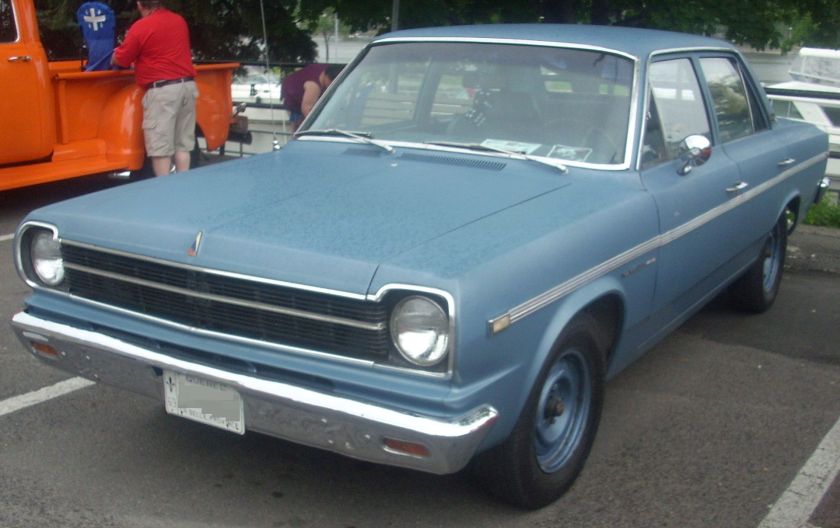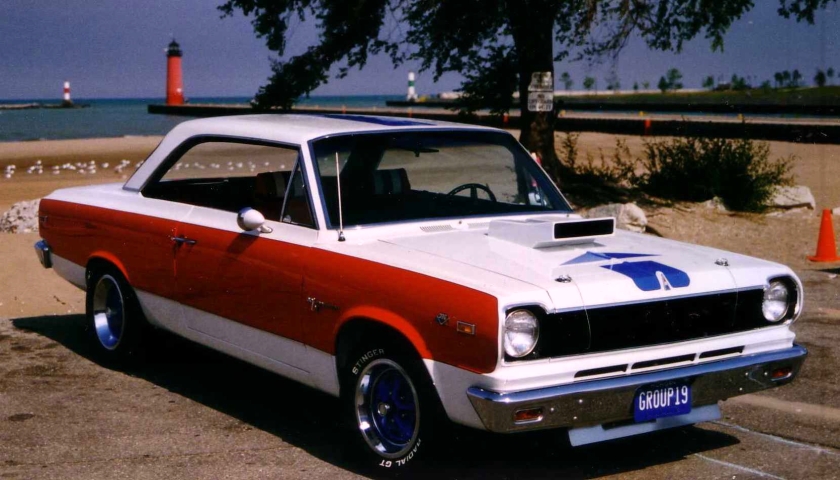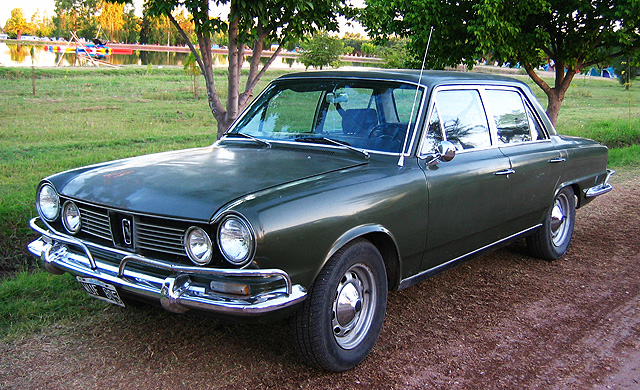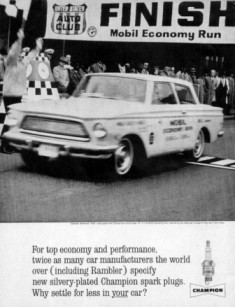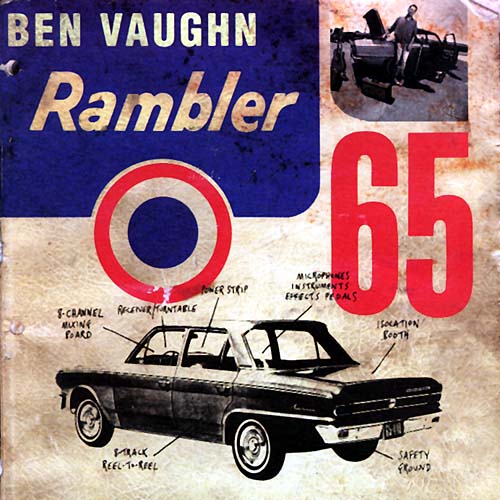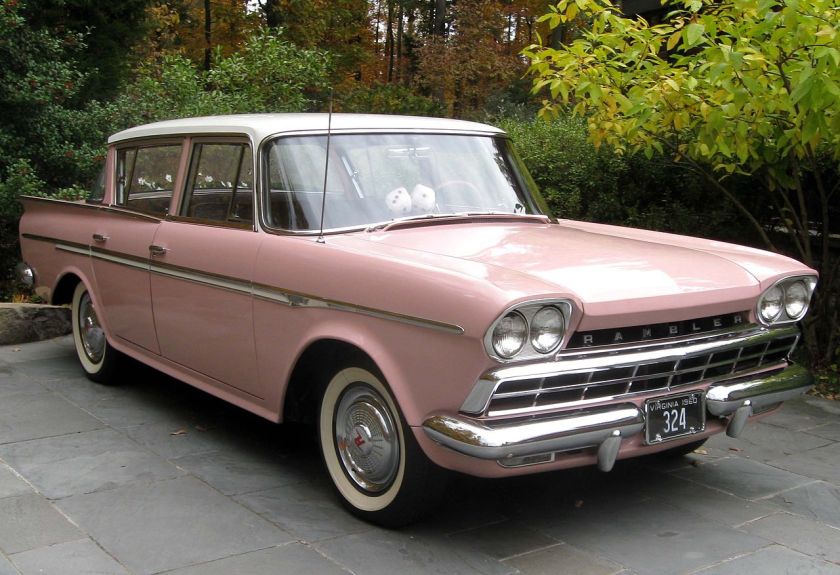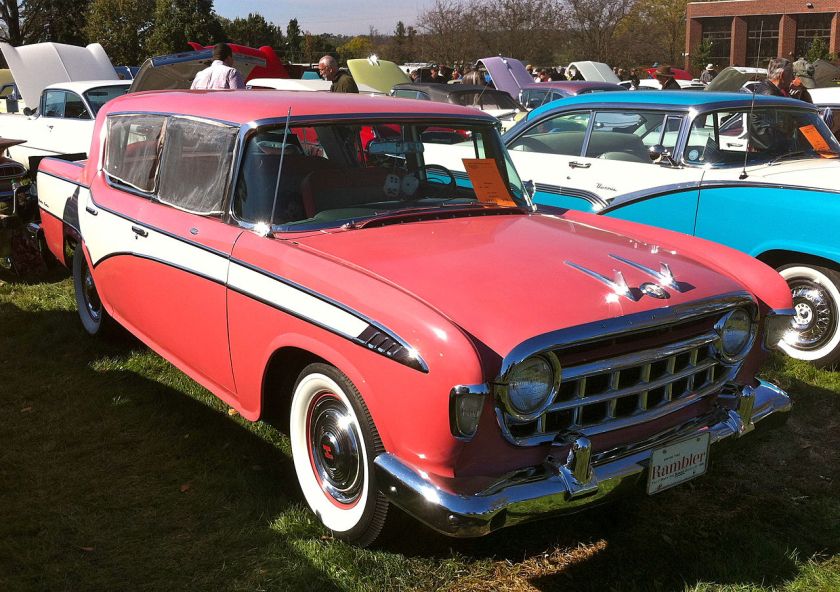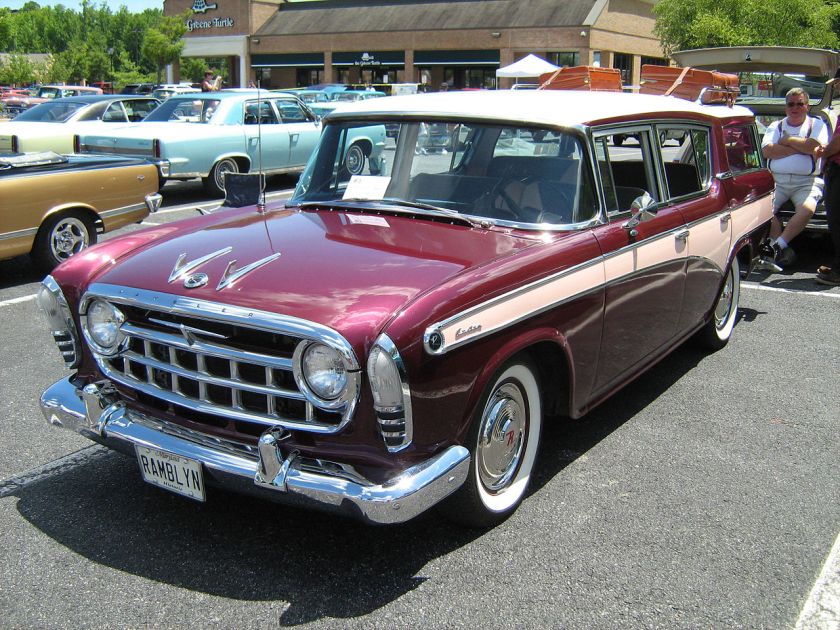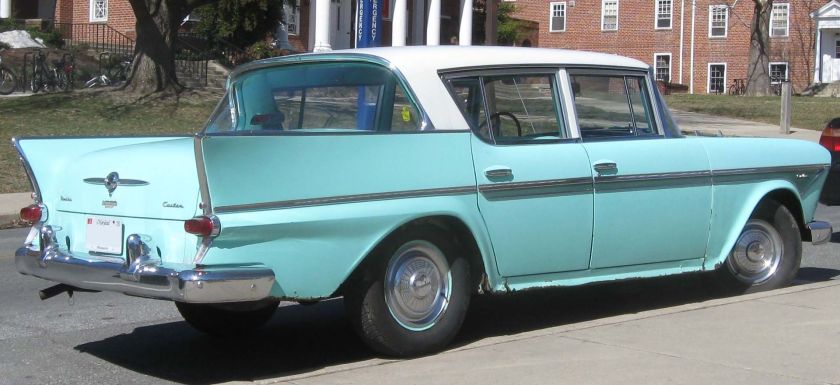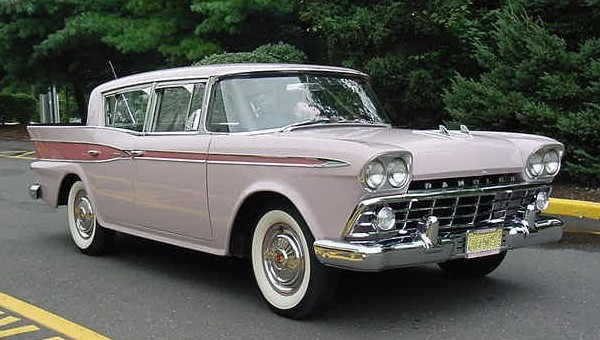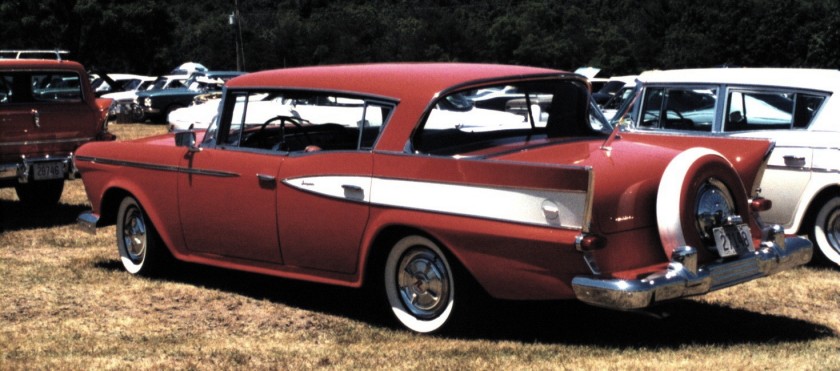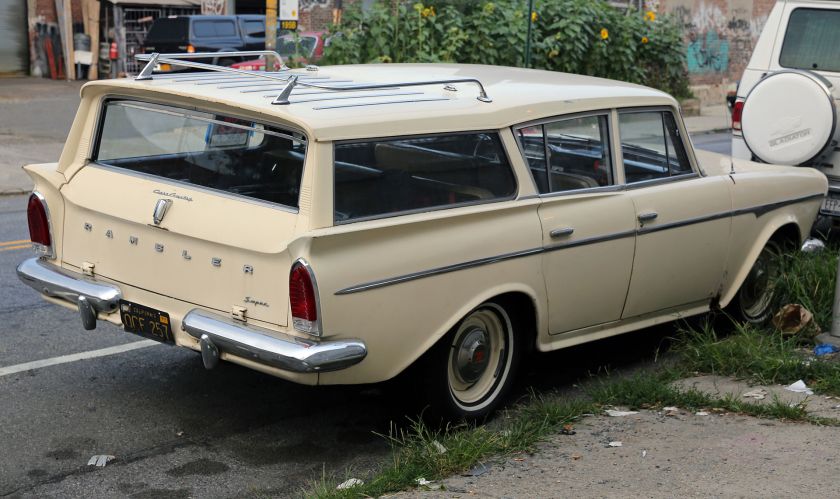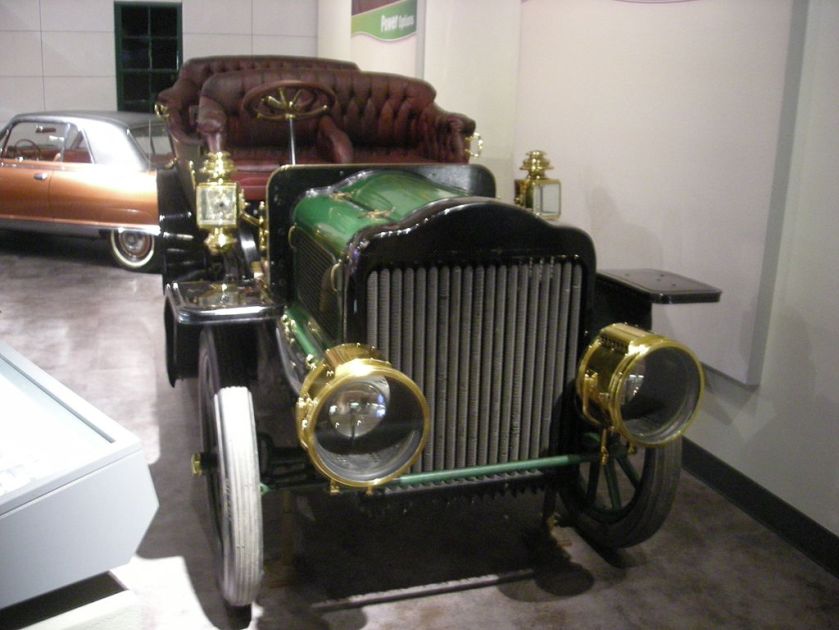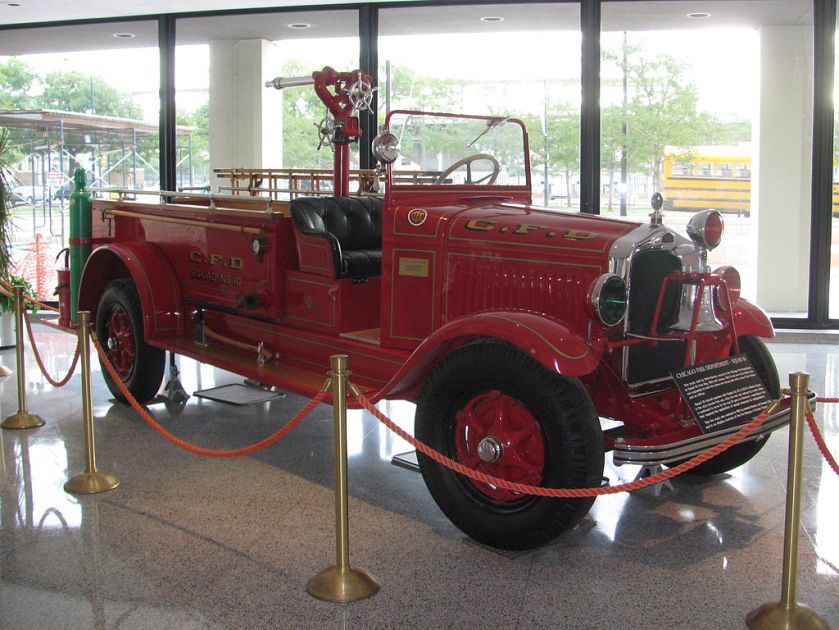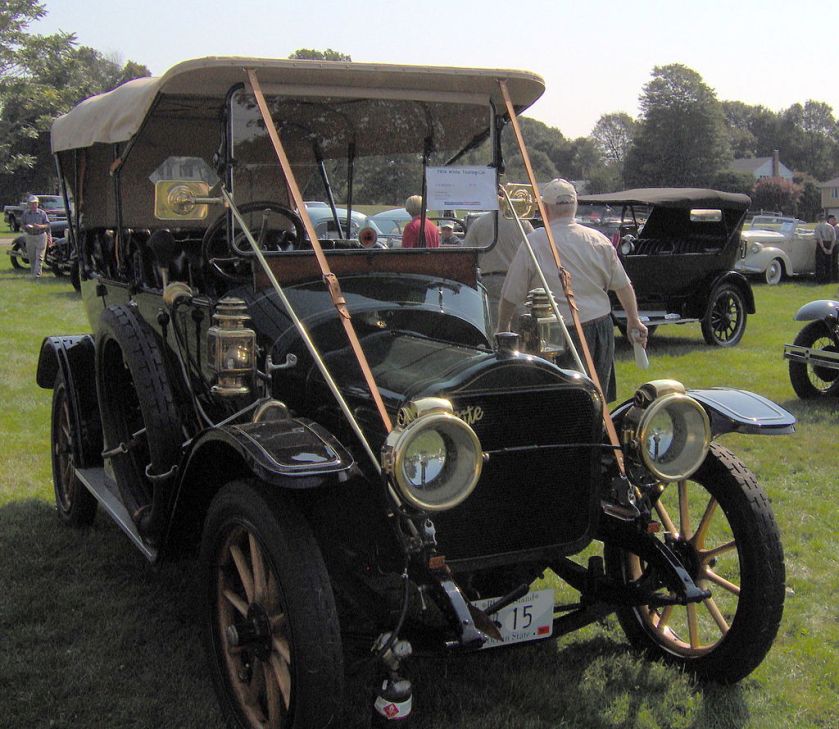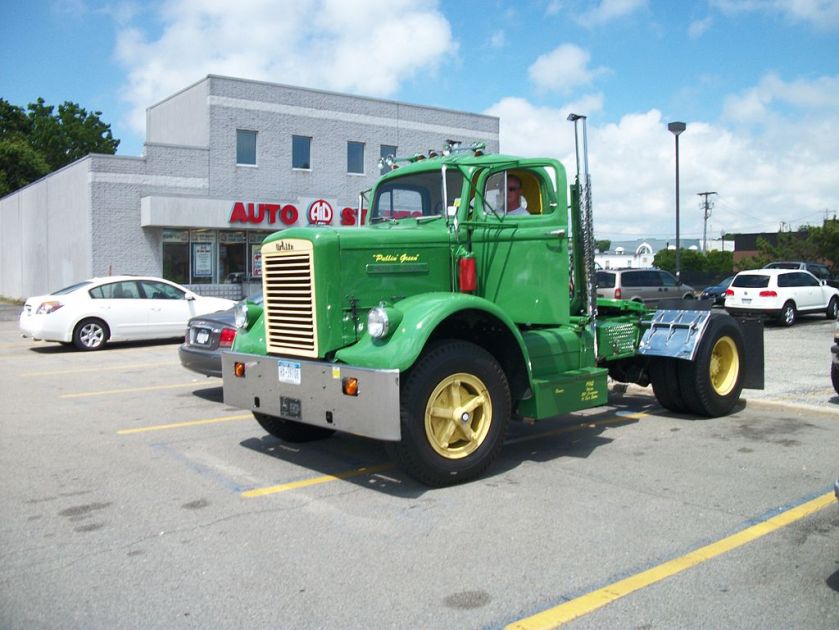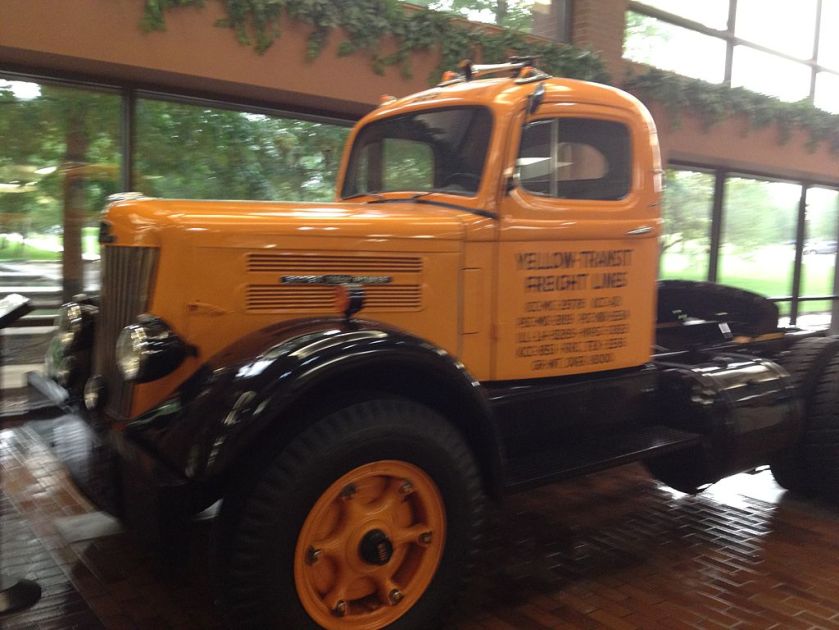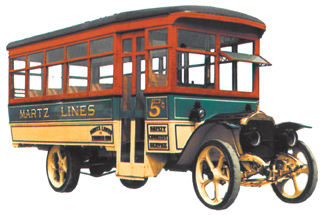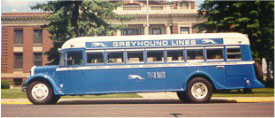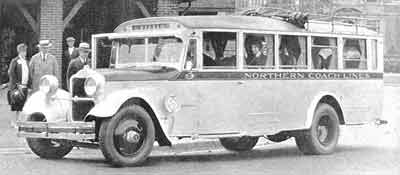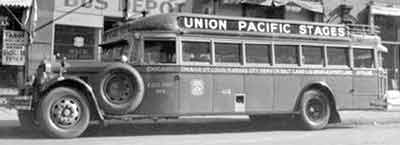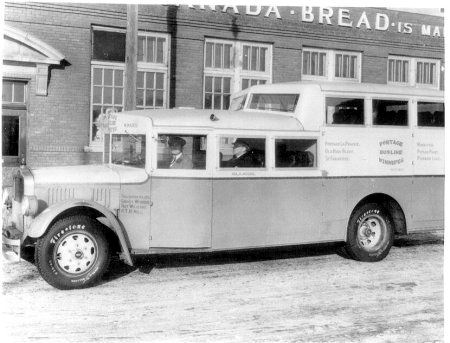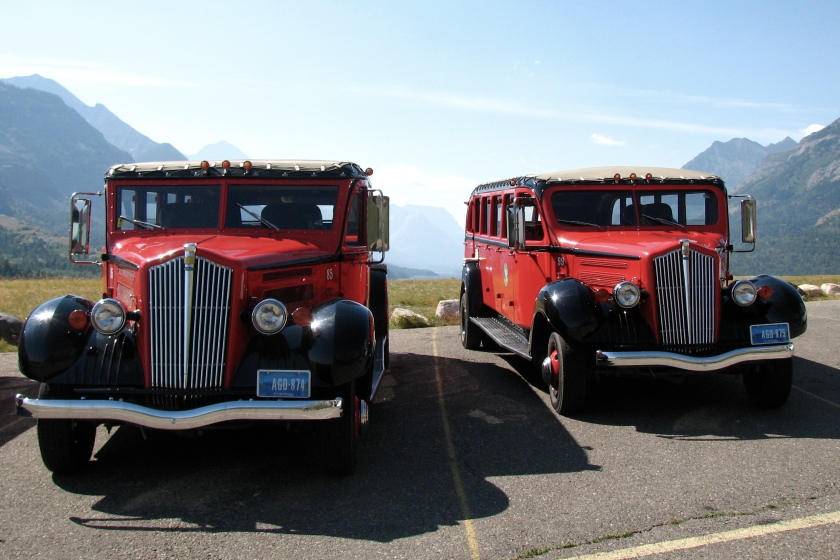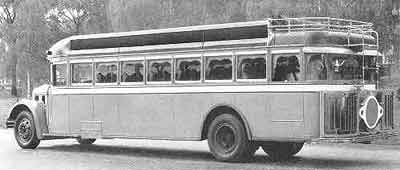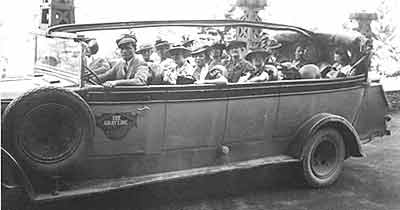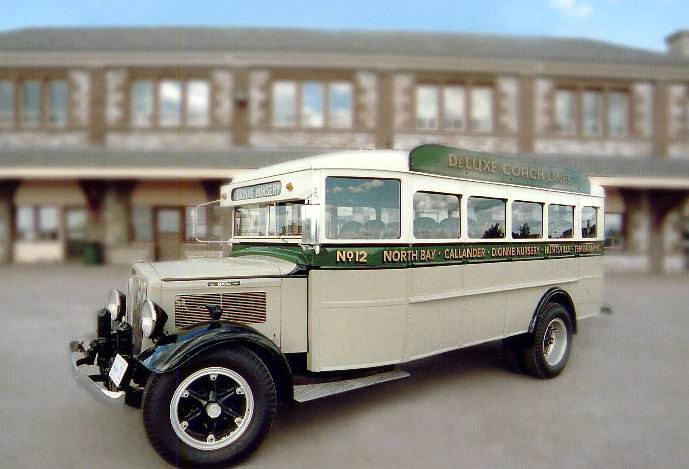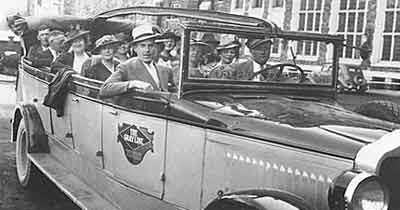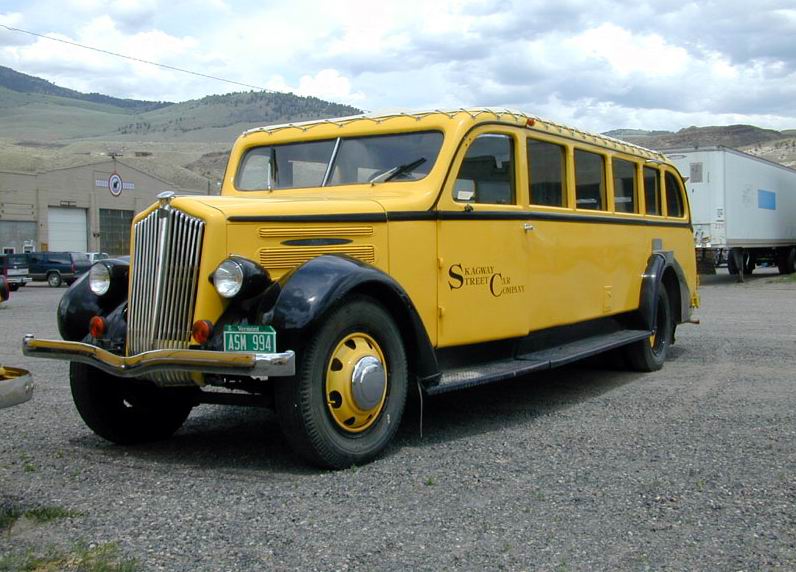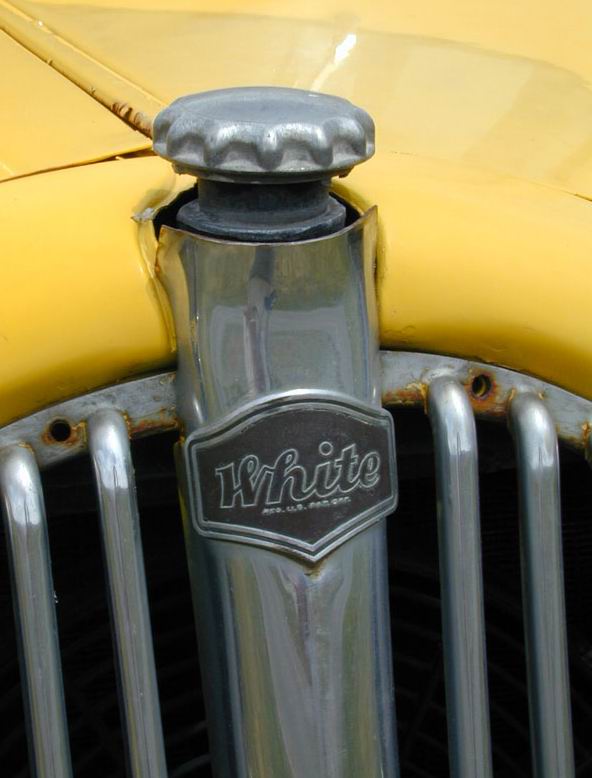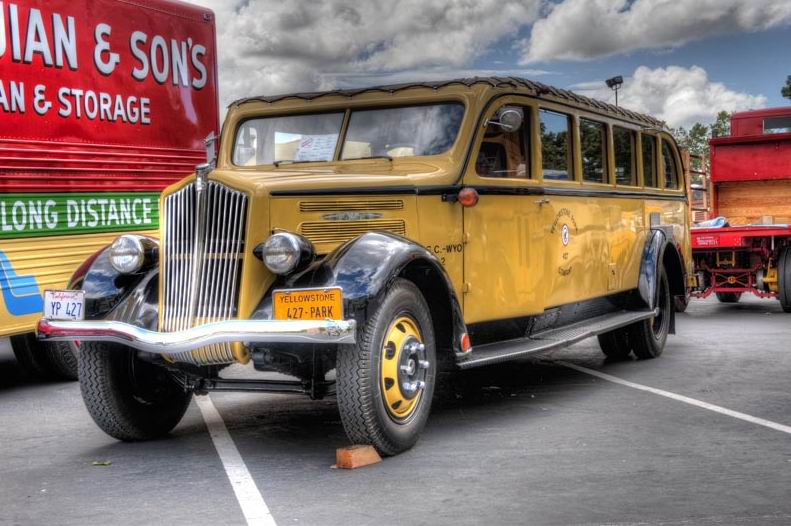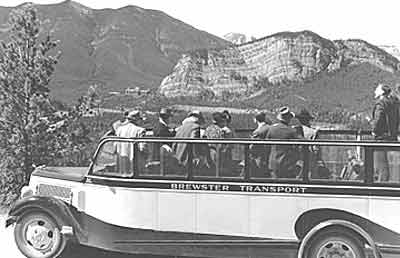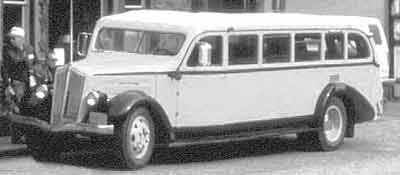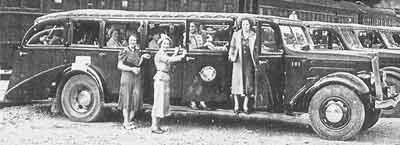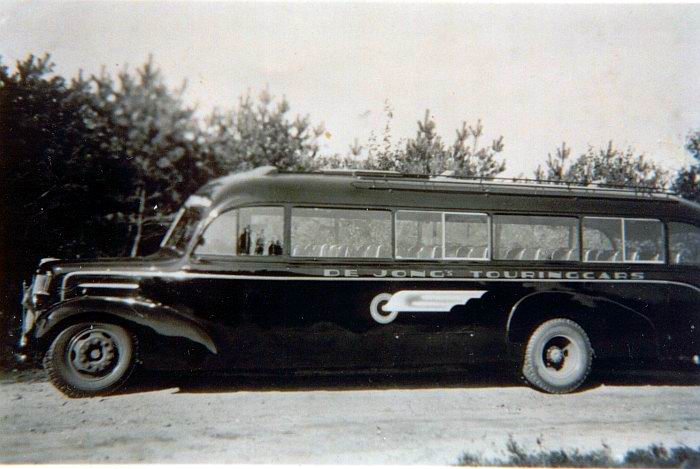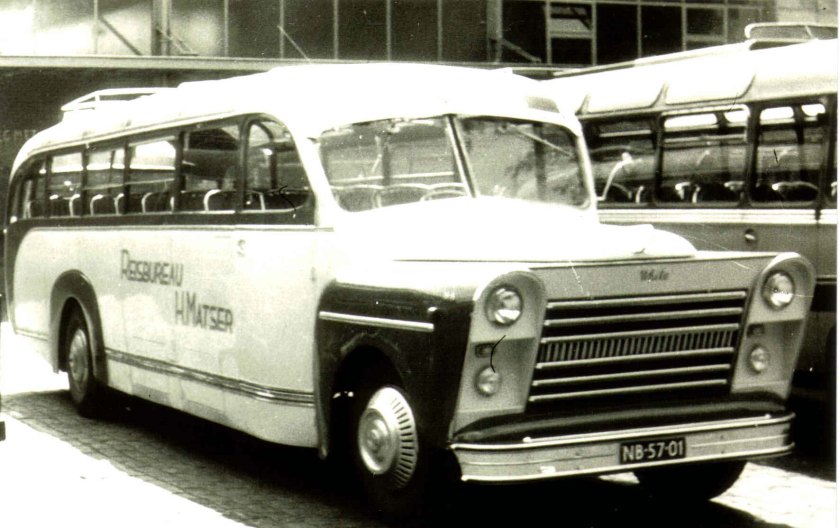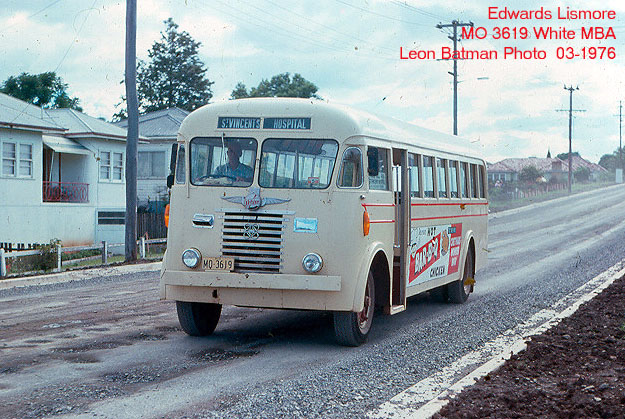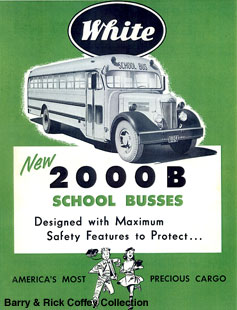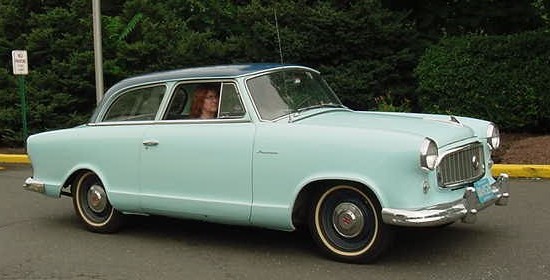
First generation 1959 2-door sedan
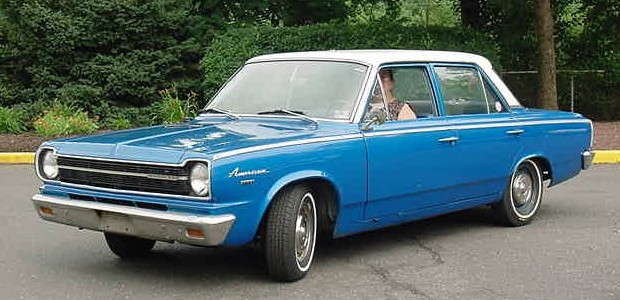
Third generation – 1966 4-door sedan. This example sports a 1969 grille.
The Rambler American is an automobile manufactured by the American Motors Corporation (AMC) between 1958 and 1969. The American was the second incarnation of AMC’s forerunner Nash Motors second-generation Rambler compact that was sold under the Nash and Hudson Motors marques from 1954 and 1955.
The American can be classified in three distinct model year generations: 1958 to 1960, 1961 to 1963, and 1964 to 1969. During the entire length of its production, the car was sold under the Rambler brand name, and was the last Rambler named automobile marketed in the Canadian and United States markets.
The compact Rambler American was most often the lowest priced car built in the U.S. It was popular for its economy in ownership, as was proven by numerous Mobilgas Economy Run championships. After an optional second-generation AMC V8 engine was added in 1966, it also became known as a powerful compact performance model that also included the 390 cu in (6.4 L) version built in conjunction with Hurst, the 1969 SC/Rambler.
A special youth-oriented concept car, the 1964 Rambler Tarpon, was built on an Rambler American platform that foretold the fastback design of the 1965 Rambler Marlin, as well as future trends in sporty-type pony cars, including the 1968 AMC Javelin.
The compact Rambler Americans were exported from the U.S. and Canada, as well as produced in other markets by AMC subsidiaries or assembled under license. It was manufactured in Australia, Iran, Mexico, and in Argentina, an offspring of the third generation American restyled by Pininfarina, the IKA Torino, later Renault Torino, was developed and made between 1966 and 1982. In Iran it was assembled from completely knocked down (CKD) kits and the models were named Aria and Shahin. Rambler Americans were built in South Africa starting in 1961 by Stanley Motors (controlled by the Rootes Group) and from 1964 by American Motors South Africa (Pty) Ltd.
Development
The genesis of the Rambler American began with the Nash Rambler, introduced in 1950. AMC President George Mason believed in small cars, and had introduced the Austin built/Nash designed Metropolitan in 1954. The Rambler line grew to a larger size (108″) in 1956. The cost to produce the Metropolitan were rising, so AMC decided to reintroduce a modified version of the 1955 Nash Rambler (the last 100″ wheelbase model). The domestically produced replacement let AMC control costs more closely. New AMC president George Romney also wanted to build momentum in AMC’s challenge to the domestic Big Three automakers by adding a third car line. The introduction of the new low priced sub compact Rambler was ideal—America had just entered into a recession in 1958 as the car was introduced.
The first proposals were to modify AMC’s captive import by extending the Metropolitan with a station wagon type roof design to make room for four passengers.[2] However the 85-inch (2,159 mm) wheelbase of the Met severely limited the necessary interior room, and costs of the overseas built model were harder to control. On the other hand, the company had retained the tooling from its 1955 model Rambler. The old model’s 100-inch (2,540 mm) wheelbase fit between its bigger family-sized 108-inch (2,743 mm) wheelbase Ramblers and the small import. The old design could be slightly modified and then used for the basis of the “new” American.
American Motors’ financial condition meant it could not afford to develop an entirely new model. The reintroduction of the old model leveraged the Rambler’s renown for fuel economy and wins in the Mobil Economy Runs, with the consumer’s need for a smaller and more efficient alternative to the standard-sized cars that were marketed by the domestic Big Three (General Motors, Ford, and Chrysler) at that time.
First generation
| First generation |
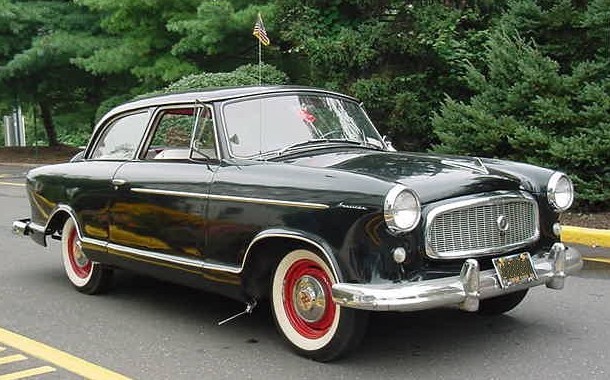
1959 Rambler American sedan
|
| Overview |
| Production |
1958 – 1960 |
| Body and chassis |
| Body style |
2-door coupe
2-door station wagon
4-door sedan |
| Powertrain |
| Engine |
195.6 cu in (3.2 L) I6 |
| Dimensions |
| Wheelbase |
100 in (2,540 mm) |
| Length |
178.25 in (4,528 mm) |
| Width |
73 in (1,854 mm) |
| Height |
57.32 in (1,456 mm) |
1958
American Motors’ designers gave the car a new grille and more open rear fender wells, giving the car a lighter appearance than that of the earlier car, which had hidden its rear wheels behind deeply skirted fenders. The original taillights were turned upside down, saving money on retooling. This design was originally mandated by Nash’s Airflyte styling motif, which sought to reach for the blinding optimism of post-World War II transportation. The car’s seemingly narrow 55-inch (1,397 mm) track was not much different from the industry standard, but rather an illusion fostered by the bulbous bodywork.
Romney worried about cannibalizing sales of his larger, more profitable senior Ramblers, so for 1958, the American was available only as a two-door sedan (senior Ramblers came only in a variety of 4-door body styles.) The only engine was a 195.6 cu in (3.2 L) flathead six producing 90 hp (67 kW; 91 PS). The American went on sale late January 1958, with a minimum of marketing and promotion. It was available in two trims, a base Deluxe model priced at US$ 1,789 allowing AMC to claim the lowest-priced car made in America (adjusted only for inflation, equal to US$14,624 in 2015 dollars) and as a Super trim version for $1,874 offering more “luxuries”. The car was advertised as being the only small car with an automatic transmission. All Americans were completely dipped in rust proofing.
The automotive press was positive to the reintroduced model. Tom McCahill wrote in Mechanix Illustrated, “There isn’t a better buy in the world today.” He continued, “The Rambler American … is an ideal-size small family car… It will give up to 30 miles on a gallon of gas (and more, with overdrive) and will outperform any imported sedan selling for under $2,000 except in the cornering department… It is by far the most rattle-and-squeak-free 1958 Detroit product I’ve driven-and I’ve driven them all!”
Reports by owners praised the car’s economy of operation, but ranked at the top its ease of handling. A “workhorse” priced at under $2,000 “it doesn’t look as though every penny was pinched out of it”, but retains a “chic look”. The American found 30,640 buyers during the abbreviated 1958 model year and helped Rambler become the only domestic make to post an increase in sales that year.
1959
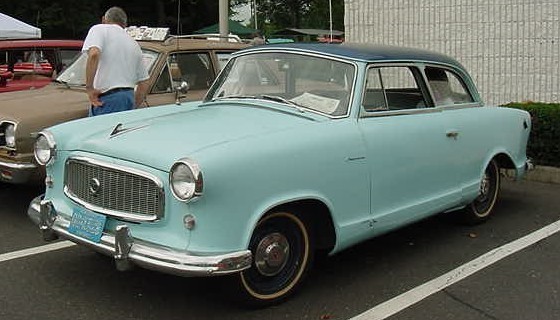
1959 Rambler American 2-door sedan
A two-door station wagon was added to the line in 1959. With the larger Rambler Six wagons offered only as four-door models, AMC’s management thought there would be little sales cannibalization from the American. The Deluxe wagon was priced at $2,060, while the $2,145 Super version included a standard cargo-area mat and roof rack. A Deliveryman commercial wagon, with no rear seat and an extended cargo floor, was available, but found few takers. Self-adjusting brakes were added in 1959.
Rambler sales increased in 1959, and AMC struggled to keep up with demand as production tripled to 91,491 Americans, with 32,639 (almost 36 percent) made up by the new wagon. The two-door sedans each sold nearly as well, also, at 29,954 for the lower-priced Deluxe and 28,449 for the top-line Super.
1960
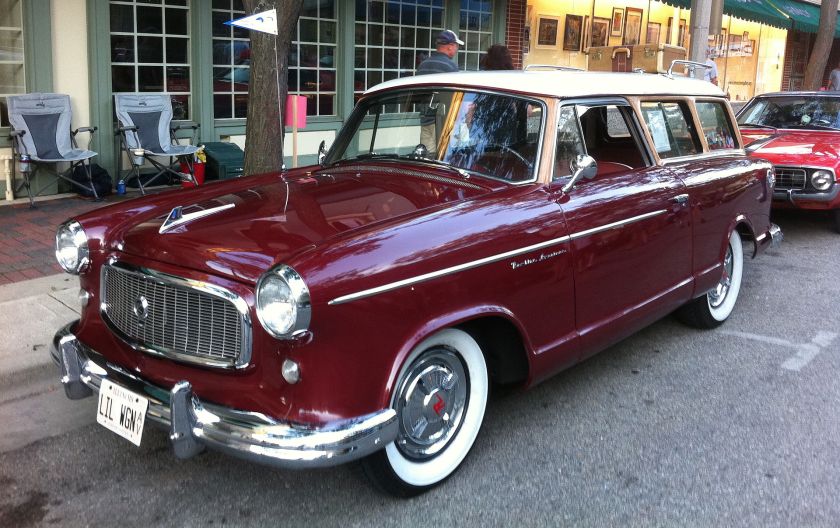
1960 Rambler American Custom wagon
For the 1960 model year, the Rambler American line added a four-door sedan body style and a third trim level, a top-of-the line Custom. The new four-door rode on the same 100 in (2,540 mm) wheelbase as the other models and was meant to battle the newly introduced compacts from the Big Three, the Ford Falcon, Chevrolet Corvair, and Plymouth Valiant.
The new Custom model came standard with a new 195.6 cu in (3.2 L) overhead valve engine with a slightly higher compression ratio of 8.7:1 producing an additional 37 hp (28 kW; 38 PS), for a total output of 125 hp (93 kW; 127 PS), while the base models retained the flathead as the standard engine. The flathead six had no visible intake manifold since it was integrated within the cylinder head, while the exhaust manifold is a “log-type” that looks like a long tube. All models received an enlarged gas tank, now 22 US gal (83 L; 18 imp gal) capacity, while power steering was a new option.
Even in the face of the new competition from much larger automakers, the compact Rambler American enjoyed appeal not only because of its low initial price, economy and high gas mileage, but also because its resale values ranked among the highest. The suggested delivered price for the Deluxe 2-door sedan was $1,795, and it was advertised as the lowest priced car in America. Demand for the traditional American continued to grow as sales increased to 120,603 units (of which 44,817 were two-door sedans, 46,973 four-door sedans, and 28,813 station wagons), thus helping AMC reach 7.5 percent of the U.S. market with a total Rambler sales of 485,745 automobiles and third place among domestic brands.
Second generation
The second generation Rambler American was achieved through a heavy restyling of the previous year’s model under AMC’s styling Vice President Edmund E. Anderson. While mechanically identical to the 1960 model, Anderson’s restyle resulted in a car that was three inches (76 mm) narrower and shorter in its exterior dimensions with an overall length of 173.1 inches (4,397 mm), but increased in its cargo capacity. Continuing to ride on the 100-inch (2,540 mm) wheelbase, the American’s new styling was more square (sometimes described as “breadbox”) instead of the round “rolly-polly” shape (or “bathtub”), and the visual connection with the original 1950 Nash model had finally disappeared. Popular Mechanics wrote “seldom has a car been completely restyled as the 1961 Rambler American and yet retain the same engine, driveline, suspension on the same unit body”. All outside sheetmetal was changed, but the side window frames remained the same as previous models. Only the back glass changed to conform to the new roof line. The firewall and dash board were new stampings, with the brakes moved from under the floor to the firewall.
1961
For 1961 the American line added a four-door station wagon, as well as a two-door convertible for the first time since 1954. It featured a power-operated folding top with roll-down door glass, rather than the fixed side-window frames of the original design. Passenger room increased from five to six.
The straight six was modernized with an overhead-valve cylinder head for higher-grade models, but the base cars continued with the flathead engine.
American Motors built a new assembly plant in Brampton, Ontario, Canada, for the production of Rambler Americans as well as the larger Rambler Classics.
1962
Setting new sales records, American Motors continued its “policy of making changes only when they truly benefit the customer.” The 1962 model year Rambler American lineup was essentially the same as in 1961. Model designations were changed with the Custom trim becoming a 400.
A new “E-stick” option combined a manual 3-speed transmission with an automatic clutch as a low-cost alternative to the fully automatic transmission. The E-stick was also available in conjunction with an overdrive unit. The system cost $59.50, but offered stick-shift economy, performance, and driver control without a clutch pedal by using engine oil pressure and intake manifold vacuum to engage and disengage the clutch when shifting gears.
Although the “Big Three” domestic automakers had introduced competitive compact models by 1962, the Rambler American remained the oldest, smallest, “stubbornly unique” refusing “to conform to Detroit’s standard pattern for scaled-down automobiles” and “free of gimmicky come-ons.” A 10,000-mile (16,093 km) road test by Popular Science described the 1962 Rambler American as “sturdy, solid, dependable little automobile, comfortable to drive … a good buy for what it’s built for – transportation, not a status symbol.”
The automaker’s president, George W. Romney, appeared prominently in advertisements asking potential customers to “think hard” about new cars and describing “more than 100 improvements in the 1962 Ramblers” and why they are not available in competitive cars, as well as AMC “workers as progress-sharing partners” so that buyers can “expect superior craftsmanship.”
1963
For 1963, model designations were changed once again with the 400 now called 440. A new hardtop (no B-pillar) coupe body design debuted, whose steel roof was designed to mimic the appearance of a closed convertible top. This was a one-model-year-only design with a thin profile, clean lines, stamped faux-convertible ribs, and a textured finish. A special top-of-the-line model called the 440-H was equipped with sports-type features including individually adjustable reclining front bucket seats and a center console, as well as a more powerful 138 hp (103 kW; 140 PS) version of Rambler’s stalwart 195.6 cu in (3.2 L) inline-6 engine. An optional console shifted “Twin-Stick” manual overdrive transmission was introduced. This transmission has a bigger gap between 2nd and 3rd gears compared to the regular three-speed transmissions with overdrive (that operated like a four-speed although the driver needed to know the governor cut-in speed, free-wheeling, as well as when to lock the overdrive in or out). This allowed the transmission to be shifted as a five-speed (1, 2, 2+OD, 3, and 3+OD). The Twin-Stick shifter had the kick-down button on top of the shift lever knob to facilitate five-speed shifting.
The entire product line from AMC earned the Motor Trend Car of the Year award for 1963. The recognition was used by AMC to promote the carryover Rambler American models.
First as the Nash Rambler and then as two generations of the Rambler American, this automobile platform performed the rare feat of having two distinct and successful model runs, an almost unheard of phenomenon in automobile history. The convertible and hardtop were the sportiest of the final 100-inch (2,540 mm) wheelbase Rambler Americans, and arguably the most desirable now.
Third generation
For its third generation, the American emerged with what would be its only completely new design. The entire line was treated to neat and trim lines with pleasing simplicity (compared to the more boxy predecessors) with characteristic tunneled headlights with a simple horizontal grille between them. The Rambler American’s wheelbase grew by six-inches or 152 mm (to 106 in or 2692 mm) and the interiors were made more spacious.The station wagons in the restyled 1964 series came with four doors and gained 17% more cargo space compared to the previous design. They all featured a new roll-down disappearing rear window for the bottom-hinged tailgate. Full coil front springs along with soft rear leaf units, gave the new American an unusually smooth ride, better than many larger domestic cars. The new models also incorporated various parts and components (such as doors) that were interchangeable with AMC’s larger cars. In essence, the new body was a shorter, narrower version of the previous years new Rambler Classic.
The new styling was the work of designer Richard A. Teague, who would go on to design the 1968 Javelin and AMX. Many viewed the newly designed station wagon as the best looking of any American wagon, with its new, trim lines and ample passenger and cargo room. Led by the top-line 440-series convertible, they were arguably the 1964’s most attractive Detroit compacts. Car Life magazine titled its road test of the 1964 Rambler American: “The Original Plain Jane Compact Car Just Got Back From the Beauty Parlor”.
1964

1964 American 440 convertible
In addition to the top-of-the-line 440 models, the cheaper 330 and 220 models were also available, and Rambler American sales soared to a record 160,000-plus. The old 195.6 cu in (3.2 L) I6 was a gas stingy champ in the Mobil Economy Runs and available in 90 hp (67 kW; 91 PS), 125 hp (93 kW; 127 PS), and 138 hp (103 kW; 140 PS) versions.
However, American Motors focused its marketing on the economy of the new models, an advertising of a kind that was previously only popular during the Great Depression. The company’s series of “Love Letters to Rambler” advertisements included “ordinary user testimonial” about the economy and reliability of their Ramblers, rather than in pursuit of buyers in the whole compact car market segment, a strategy that was copied ten years later by Datsun.
1965

1965 American 440 convertible
The 1965 Americans were little changed, but were advertised as “The Sensible Spectaculars”. This was part of Roy Abernethy‘s strategy for AMC to shed its “economy car” reputation and take on the domestic Big Three automakers in new market segments. There were few changes to AMC’s smallest models, as Abernethy pinned his hopes for recovery not so much on the low-priced Rambler American as on the medium and higher-priced Classic and Ambassador lines.
The year also saw the introduction of an entirely new 232 cu in (3.8 L) overhead valve straight-6 engine that AMC would use through 1979, with a smaller 199 cu in (3.3 L) version being used only during 1966-1970. The same engine was later available in a larger 258 cu in (4.2 L) version (used from 1971–89) and the fuel injected 242 cu in (4.0 L) versions that debuted in 1987, known as the Jeep 4.0, which Chrysler would continue their production after its purchase of AMC in 1987, all the way through 2006.
The 1965 models was the last year for the venerable flathead six. It was the last flathead engine to be used in a domestic U.S. car.
1966
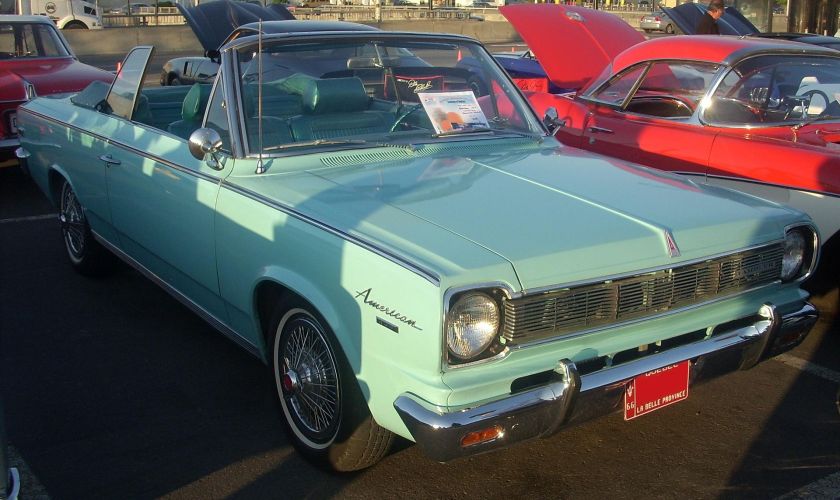
1966 American 440 convertible
As the automobile marketplace in the U.S. was moving away from economy and toward performance and upmarket vehicles, American Motors began removing the historic Rambler name from its larger models. However, the American and Classic models retained their economy car marketing image and their traditional nameplate. To cement this image, a Rambler American was again the overall winner in the Mobil Economy Run. The mid-trim level 330 model was dropped, leaving the top 440 and base 220 models in the lineup for 1966. The top of the line model, available only as a two-door hardtop, saw its name changed from 440-H toRogue.
The American models were facelifted for the 1966 model year with more squared-off front and rear styling. The front of the car was extended to add three inches (76 mm) to the inside of the engine compartment. This allowed air conditioning to be used with the new 199 and 232 in-line six-cylinder engines., which were longer than the old 195.6 models.
A completely new 290 cu in (4.8 L) “Typhoon” V8 engine was developed by AMC and it saw its introduction in a special mid-1966 Rogue model. Available in 200 hp (149 kW; 203 PS) two-barrel carburetor version or producing 225 hp (168 kW; 228 PS) with a 4-barrel carburetor and high compression, the new engines utilized “thin-wall” casting technology and weighed only 540 pounds (245 kg). The newly powered Rogue came with a 3-speed automatic transmission or a floor mounted 4-speed manual, and made the car “suitable for the Stoplight Grand Prix.” American Motors’ new engine design would expand in power and in applications across the company’s passenger cars, as well as eventually in Jeeps, and then continue to be assembled through 1991 for the Jeep Grand Wagoneer; long after AMC was sold to Chrysler.
1967
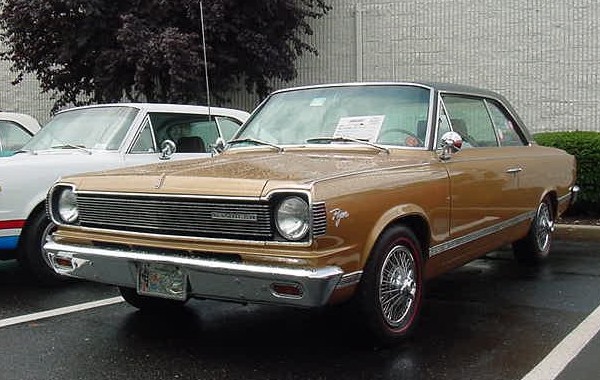
1967 Rambler Rogue 2-door hardtop
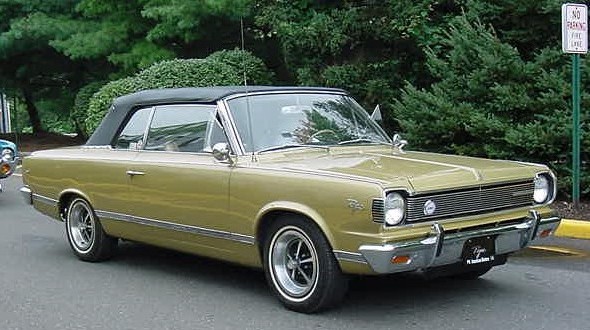
1967 Rambler Rogue convertible
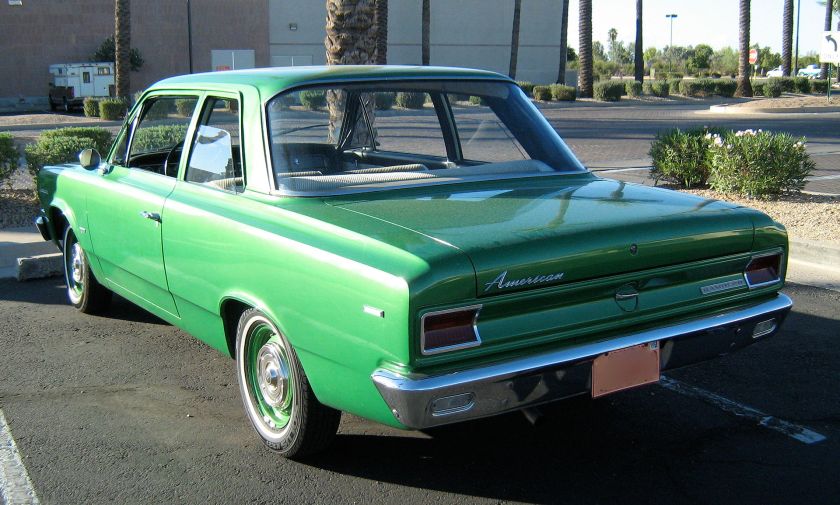
1967 Rambler 220 2-door sedan
The 1967 model year Rambler American used the same body styling as the previous year’s models, with only minor changes that included new taillamps and full-length body moldings on 440 and Rogue models that was now positioned lower on the sides. The last convertible available in the American series was in 1967, and it was moved up from 440 models to join the hardtop in the Rogue trim version. The American was available in nine models, and was the only U.S. compact to be available in “all” body styles (2-door, 4-door, sedan, wagon, pillar-less hardtop, and convertible).
For 1967 only, AMC’s new high-compression (10.2:1), high (octane rating) 343 cu in (5.6 L) V8 engine with a 4-barrel carburetor that produced 280 hp (209 kW; 284 PS) and 365 pound force-feet (495 N·m) of torque @ 3000rpm, was optional in Rogue and 440 models. Factory installations of this engine were in 58 Rogues and just 55 in the 440 models, with seven of them being in the convertible version. Out of the total production of 69,912 Rambler Americans for the 1967 model year, 921 were Rogue convertibles.
Rogues also received grille trim that wrapped around the fender sides. All Rambler Americans received a new grille insert with prominent chromed horizontal bars. The 1967 Rogue models were available in new two-tone paint schemes for the roof, trunk lid and hood that included border trim along the upper body line. The two-door hardtops were also available with a black or white vinyl roof cover. Taillight lenses were more sculptured into the rear panel.
The 1967 model year also saw the addition of the new safety standards for passenger cars mandated by the U.S. National Highway Traffic Safety Administration (NHTSA). The regulations began with seat belts on automobiles produced after March 1, 1967. The 1967 Rambler Americans also included a collapsible, energy-absorbing steering column and steering wheel, more padding on interior surfaces, 4-way hazard flashers, and locking seat back latches for 2-door models. The instrument cluster was changed from the previous rectangular design, to round gauges: the center dial housing the speedometer and odometer, the with twin smaller fuel and engine temperature gauges and matching warning light pods flanking each side of the speedometer.
All 1967 Americans were covered by AMC’s comprehensive warranty designed to increase customer confidence in their vehicles with the tagline: quality built in, so the value stays in. It was the strongest backing among all the automakers up to that time: 2-years or 25,000 miles (40,000 km) on the entire automobile, as well as 5-years or 50,000 miles (80,000 km) on the engine and power train. American Motors continued its industry exclusive ceramic-coated exhaust system as standard on Rambler Americans.
Newly appointed as AMC’s new Chairman and Chief Executive Officer, Roy D. Chapin, Jr. began to promote and reposition the Rambler American, the automaker’s least popular line. He bet on the Rambler American to improve the automaker’s financial performance after George W. Romney. Chapin also saw a price gap between U.S. cars and inexpensive imports (primarily the Volkswagen) and lowered the price to make the Rambler American’s “total value superior to the imports, as well as superior in both price and range of choice to U.S. compacts”. The suggested retail price of the base two-door Rambler American sedan dropped to $1,839 (US$ 13,007 in 2015 dollars) (its closest U.S. competitor was the $2,117 Plymouth Valiant), making the larger and more powerful American only $200 more than the Volkswagen Beetle.
American Motors announced that it was forgoing the annual styling changeovers that were expected among the domestic firms, thus saving retooling costs and passing on the savings to consumers by keeping the car’s price low. The automaker promised in a special $300,000 ($2,121,856 in 2015 dollars) advertising campaign that future changes to the car will be to enhance the safety and reliability of these cars. The Rambler American’s recent (1966) redesign was then continued mostly unchanged through the 1969 model year.
1968
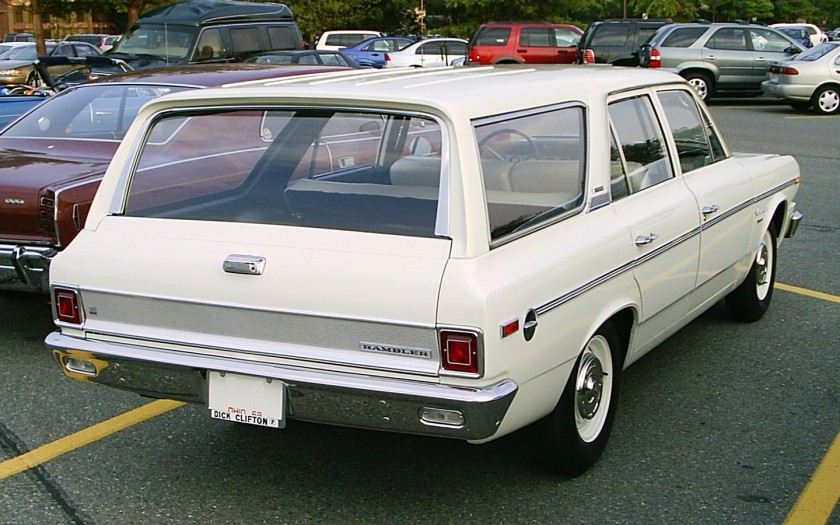
1968 Rambler American station wagon
For 1968, the line was further simplified from nine to five models, with the 2-door coupe and 4-door sedan comprising the base line (with the 220 designation no longer used), 4-door sedan and station wagon being offered in uplevel 440 guise, and a lone hardtop coupe making up the top-line Rogue trim line. The American, along with “A-body” Chryslers, were the only domestics that came as a hardtop coupe model, the Ford Falcon and Chevy Nova being only available as pillared sedans (and a wagon in the Ford Falcon line).
All Americans received a new chrome horizontal grille bar that extended outboard to the headlights, while the grille sections got an attractive “blackout” treatment. The wraparound rear window on the sedans was modified to a flat unit, with a more squared-off “C” pillar, which changed the appearance from the earlier sedans with their overhanging rooflines. The overall affect was a more formal-looking car. The 440 and Rogue versions picked up a stainless steel trim piece running stem to stern on either body side, straight back between the wheel wells and the belt line. At each end of the strip were the newly safety-mandated body side reflectors, amber for the front fenders, red for the rear. The U.S. National Highway Traffic Safety Administration (NHTSA) standards for all passenger cars sold in America for 1968 also called for shoulder harness for the front seats and elimination of reflective interior trim. Other requirements for all cars manufactured after 1 January 1968, included exhaust control systems to help reduce unburned hydrocarbon and carbon monoxide emissions.
However, the biggest change was the decision to keep the MSRP (manufacturer’s suggested retail price) of the base two-door model to within US$200 of the Volkswagen Beetle. The domestic Big Three automakers did not respond to this strategy, thus giving AMC a big price differential over the competing domestic models. Sales of the Rambler American increased and the showroom traffic boosted morale among AMC’s independent dealerships. This was backed up by a marketing campaign stating, “Either we’re charging too little for our cars or everyone else is charging too much.” The promotion and lower prices were designed to rekindle the Rambler American as a practical and economical car in customers’ minds. Advertisements by AMC’s new agency, Wells, Rich, and Greene, headed by Mary Wells Lawrence violated the accepted rule of not attacking the competition.
1969
Since its introduction “the Rambler American has done well at American Motors.” For its final model year, 1969, the “American” name was dropped as the car was now referred to as the “American Motors Rambler”. Continuing the tradition of minimal changes, the models received a new “suspended” accelerator pedal and cable throttle linkage. Additional safety equipment for the 1969 models included front shoulder belts and headrests for both front outboard seating positions and the front parking lights stayed on with the headlights. On the exterior, the center horizontal chrome grille bar was deleted.
As a true compact-sized car on a 106 in (2,692 mm) wheelbase, the Rambler station wagon had no domestic competitors, and it offered interior space advantage compared to imported models with its 66 cubic feet (1,869 L) of cargo space. Available only in 440 trim, the wagons came with a roll down rear window with drop-down tailgate, as well as a roof rack.
In part to commemorate the impending passing of the Rambler name, American Motors added the Rogue-based SC/Rambler to the line (detailed separately).
A total production for the 1969 model year was 96,029. The last U.S.-made Rambler was assembled in Kenosha, Wisconsin, on 30 June, making the production total of 4,204,925 units.
After the 1969 model year, a completely redesigned model, the AMC Hornet, replaced the American.
SC/Rambler
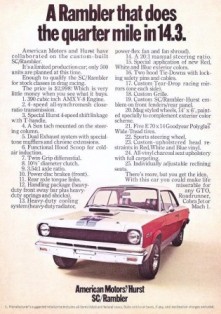
The SC/Rambler was purposefully promoted by AMC as a potent drag strip challenger
One of the muscle car era “most visually arresting examples” was a special model was produced during 1969 in collaboration with Hurst Performance, the Hurst SC/Rambler. “Likely the most outrageous musclecar from AMC” with 1,512 built, it was probably the only production model made and promoted for a specific drag racing class, the National Hot Rod Association (NHRA) F/Stock class.
The SC/Rambler “became one of the most potent cars of its time, throwing down quarter-mile times that only Hemis and Cobra Jets had previously touched.” A true muscle car with zero options and a suggested retail price(MSRP) of less than US$3,000, it would take down some much more vaunted cars.
Equipment
Each Hurst SC/Rambler came equipped with the 315 hp (235 kW; 319 PS) 390 cu in (6.4 L) AMC V8 engine from the AMX. There were no factory options to this package. Standard clutch was a 10.5-inch (267 mm) with a three finger long-style Borg and Beck pressure plate. The 390 engine was mated to a manual transmission four-speed T-10 with close gear ratios. A Hurst shifter came with a large metal “T” handle. The rear end was an AMC 3.54:1 “Twin-Grip” limited slip differential using Dana internals, with outer wheel hubs attached through a spline and keyway system. The hub attachment method was the only weak point in the rear end assembly.
Factory cast iron manifolds exited to a true dual exhaust with Thrush (a Tenneco brand) two-chamber oval mufflers with Woodpecker logos. These were standard baffled mufflers, not glass packs. Minimal baffeling gave a deep throaty sound, similar to modern Flowmasters. The exhaust exited through chrome tips attached with hose clamps.
While similar Rogue and American models had drum brakes, the SC package came with front discs, a heavier sway bar, as well as strengthened drive train and body components. These included connectors between the front and rear subframes. The rear end used staggered (fore and aft) rear shock absorbers to eliminate wheel hop (axle wrap) under extreme acceleration conditions with leaf spring suspensions. The staggered shocks required a special plate riveted in the trunk pan, as well as brackets for the subframe end of upper torque links. Other body modifications differentiating all Hurst SC Ramblers from regular hardtop Ramblers included rolling back front and rear wheel openings to allow for larger tires. American Motors called on Hurst to help develop a vehicle for the racing market. Because of stock class rules, a minimum of 500 identical vehicles had to be produced and sold. This led to the SC Hurst Rambler, (SC) meaning “Super Car”. This vehicle is commonly referred to as a “Scrambler”, although Jeeps later used the SCRAMBLER name.
Available only as a two-door hardtop, the interior came in standard gray charcoal vinyl upholstered reclining seats with a headliner embossed with small squares. The front seats reclined, and the newly safety mandated head restraints were upholstered in red, white, and blue stripes. The SC/Rambler included a standard 90-degree wide arc scale Sun tachometer. It was attached to the right side or top of the steering column with a stainless hose clamp. The only factory option was an AM radio.
The SC/Ramblers came with the wildest factory paint jobs ever put on a muscle car. All featured a forward-facing functioning box-type hood scoop with “390 CU. IN.” and “AIR” in large letters on both sides of it. The hood scoop air flapper was vacuum operated, allowing higher pressure cool air to pressurize a Carter AFB carburetor. A blue arrow on the hood pointed towards the air intake. The Scrambler came only in two types of red, white, and blue color schemes (“A” or “B” trims) with no other options available, with the exception of an AM radio. These schemes appeared randomly through early production.
Some AMC historians incorrectly claim that American Motors built a lot of 500 “A” scheme SC/Ramblers before switching to the “B” scheme, with 500 “B” models were built before AMC switched the final lot of 512 SC/Ramblers back to the “A” pattern. However, there are “B” scheme cars in the Hurst SC/Rambler registry with very early build dates putting their manufacture among the “A” scheme versions. AMC used the same paint code for all special paint schemes, so there is no way to determine exactly how the cars rolled out of the factory.
Some of the other unique standard items on this model included racing mirrors, anti-hop rear axle links, and blue Magnum 500 steel wheels (common to Fords) with chrome beauty rings and AMC hub centers. Tires were E-70-14 fiberglass belted 4-ply tires with red stripe Goodyear Polyglas tires. American Motors priced the SC/Rambler at $2,998 (after adjusting for only inflation, equivalent to US$19,280 in 2015dollars) a serious dragstrip contender because in its as-sold condition it could do the quarter mile in the low 14 seconds at about 100 miles per hour (161 km/h). For example, Road Test magazine reported 14.4 at 100.44 mph and reached 109 miles per hour (175 km/h) without topping out. With a few simple bolt on modifications they would run low 12’s. Modified SC/Ramblers have run the quarter-mile in the 9-second bracket.
The automaker provided AMC dealers with numerous “Group 19” parts and upgrades to make customer’s SC/Ramblers even quicker. Well-tuned legal stock S/C’s with allowable changes have run in the 12-second range. Charles Rauch set a D/S quarter mile record of 12.54 seconds at Detroit Dragway. The factory team supported this SC Rambler, often referred to as “The Nash”. Modifications included a special cast iron manifold, advanced camshaft timing, heavier valve springs, factory supplied carburetor, six cylinder front springs with factory supplied bottom shims to restore stock height, 90/10 front shocks, lightened chassis components, exhaust system modifications, Chevrolet 10.5-inch diaphragm pressure plate, wide ratio transmission gear set, 4.44 rear axle ratio, as well as larger, softer, G70-15 rear tires on identical design Magnum 500 15″ Ford wheels painted AMC blue. The manifold and some other parts were specially selected factory components for the stock 340 hp (254 kW; 345 PS) 1970 Rebel Machine engine, but legal for use in the big bore, short stroke 1969 AMC 390 engine.
IKA Torino
From 1966 to 1982, Industrias Kaiser Argentina (IKA) produced in Argentina a hybrid of the second-generation Rambler American and Classic platforms. The car was called IKA Torino, later Renault Torino, and featured AMC’s Automobile platform with a facelifted front and rear design and instrument panel by Pininfarina to create a new car. The Torino was received by journalists and the public as The Argentinean car.[70] It was available in two-door hardtop and four-door sedan body styles and all came with luxurious interior appointments.
The Torino’s engine, transmission, and upgraded interior fittings were unique to Argentina, and were not used on any of the U.S. market Ramblers. The engine was the Kaiser 230 cu in (3.8 L) overhead cam (OHC) six originally developed for the new 1963 Jeeps. The car was actually a 1963-1964 Rambler Classic passenger compartment with 1964-1965 Rambler American front and rear sections. The front suspension sills extended all the way under the floor to meet the rear suspension sills, a feature that made the Torino much stiffer than its U.S. produced cousins (The Rambler Marlin also used these long sills, but other models did not). The Torino handled the roads of the interior of the country very well while its engine acquired fame for being robust and reliable. The car was successful in Argentina. It was also entered in races against famous sport cars, including the “84 hours of Nürburgring” endurance race in 1969, where a Torino finished with the most laps, but was classified in fourth place due to penalties.
Aria and Shahin
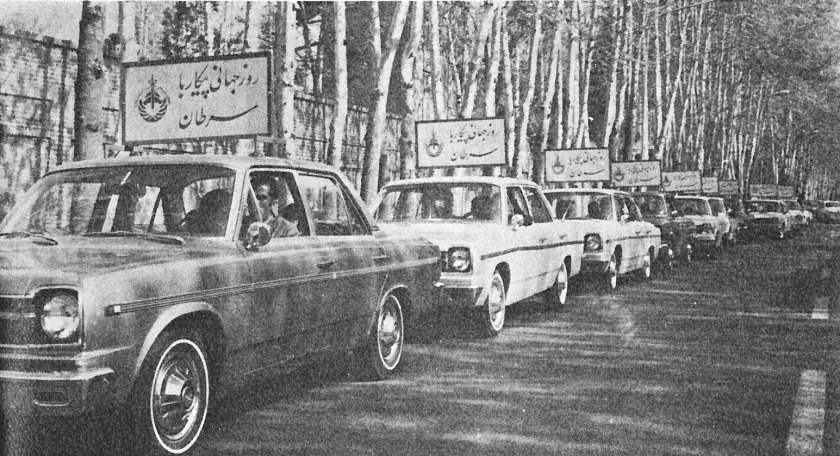
Sherkate Sahami Jeep company built Ramblers in
Iran
From 1967 to 1974, the 1966 version of the AMC Rambler American was assembled by the Sherkate Sahami Jeep company in Iran. The American was offered in two trim levels as Aria (sometimes spelled “Arya”) and Shahin. The Aria was a more luxurious version that came with a 3-speed automatic transmission, while the Shahin was the base model with a manual transmission. The engine used was AMC’s 195.6 cu in (3.2 L) inline-six producing 128 hp (95 kW; 130 PS). The cars were available with factory air conditioning, a unique feature for the Iranian market during that time.
The Aria and Shahin were assembled under the license of AMC by Pars Khodro starting in 1967. The factory in Tehran was dedicated by the last Shah of Iran. Five-year projections called for the Pars Khodro plant to build 75,000 Rambler Americans. The target was the upper and middle classes that had grown prosperous under the Shah. The Arya and Shahin versions of the Rambler American, as well as the Jeep Aho (Grand Wagoneer), “were among the best domestically produced vehicles.”
Production was continued by the Iran Jeep Company plant in Tehran. The Iran Jeep Company (Sherkate Sahami) formed a new company called General Motors Iran Ltd. in June 1972, and after production of Rambler Americans ended in early 1974, they continued to produce selected Opel Rekord, Chevrolet Nova and Pickup, Buick Skylark, and Cadillac Seville models from 1974 until 1987.
Australian production
The Rambler American was introduced to the Australian market in 1964. It was built by Australian Motor Industries in Port Melbourne from complete knock down (CKD) kits shipped from the U.S. The driver’s position was moved from left to right hand to comply with Australian law. There were also differences and overlaps in the Australian production and equipment compared to U.S. model years. The 1965 model Ramblers were produced trough 1966, mostly in 440 trim and with the smaller 195.6 cu in (3.2 L) engine. Because AMI assembled other automobile brands at its facility (including Toyotas and Triumphs), there were some sharing of colors, options, and interior trims. By 1967, the local content of the Rambler Americans had been progressively raised to 53%. Important for the Australian market, the Rambler was considered reliable, with the mechanicals being generally solid and trouble free.
Mexican production
The Rambler American was introduced to the Mexican market in 1958 through direct importation from the US. Early in the year, American Motors signed an agreement with an assembly plant based in Monterrey, Nuevo León, that produced a number of vehicles for different makes and had its own dealership network. Virtually, the whole Rambler line was available. However, the production and sales volumes were fairly low and the agreement was terminated in late 1959. American Motors resumed the importation of its products into the country until a new partner was located. Early in 1960, the company signed a new agreement with Willys Mexicana S.A. de C.V. and the first model produced was none other than the Rambler American, becoming the first American Motors product made and sold by what would become Vehículos Automotores Mexicanos S.A.
The 1960 Rambler American produced under Willys Mexicana was available in two-door sedan, four-door sedan and two-door station wagon body styles. They were powered by a 90 hp L-head 195.6 cubic inches six cylinder engine with 8.0:1 compression ratio and single-barrel carburetor coupled to a three speed manual transmission with column shift. Among its characteristics it featured a built-in flow through ventilation, four-wheel drum brakes, standard suspension, pull-handle parking brake, front parking lights, marker lights, bench seats, four side armrests, vacuum wipers, cigarette lighter, front ashtray, hood ornament, glove box, driver’s side remote mirror and hubcaps over standard wheels.
For 1961 the Rambler American for Mexico was available as the new second generation of the line, growing from three to four body styles with the introduction of the four-door station wagon. Wipers and washers changed to electric units, an Motorola AM radio with antenna and twin-circuit brakes became standard. The line continued with minor changes in 1962 and 1963. The most important aspect came in 1963 with the introduction of a fifth body style (two-door hardtop) that would become VAM’s first limited edition; the Rambler American Hardtop, Mexican equivalent to the Rambler American 440H model in the US. The car became the company’s first sporty compact as well as its first luxury one.
For 1964, the third generation Rambler American debuted in Mexico. The year’s line can be described as consolidated since it was available only as a two-door sedan, four-door sedan and four-door station wagon. The only engine available was still the L-head 90 hp 195.6 cubic inches inline six cylinder, but not much later it was replaced by the one-barrel 127 hp OHV version. The Rambler American line for 1965 switched to the new one-barrel 145 hp 232 cubic inches inline six cylinder engine, an aspect that was hidden from the public. The cars were advertised as being equipped with the also new 199 cubic inches six cylinder series, which wouldn’t be available until the midyear. The 232 engine series was already being produced in Mexico while the 195.6 engine series was imported from the US. In terms of product line volumes, warrantly claims among others, having those two engines available was not a cost-effective procedure. The company intended to consolidate and standardize production as much as possible, which was achieved by terminating the 195.6 engines and offer both the Rambler Classic and Rambler American lines with the 232 engines until the 199 was available for the latter. Had VAM announced the 232 six cylinder engine from the beginning in the Rambler American line and subsequently announcing the change to smaller less powerful engine would have taken its toll on the company’s image among the public. Also, announcing the 232 in the Rambler American from the beginning would most probably reduce any reasons to buy a Rambler Classic instead; a problem American Motors had to bear with under Roy Abernethy when the 287 cubic inch V8 was offered in the 1963 Rambler Classic, drawing several customers away from the more profitable Rambler Ambassador models that shared the same styling.
The two new engines were not the only outstanding novelties of the year, the Rambler American Hardtop was resurrected. The model kept the same luxury and sporty touches of the 1963 model and was once again a low volume limited edition. The cars came standard with the two-barrel 155 hp version of the 232 engine coupled to a Borg-Warner “Flash-o-Matic” three speed automatic transmission with floor shift. This was followed by individual reclining seats, high-trim upholstery, center console with locking compartment, two-point front seatbelts, custom wheel covers and bright molding package.
The Mexican Rambler American for 1966 and 1967 saw mostly the same cosmetic changes as its US counterparts. The hardtop model departed once more and the line was restricted to the 199 six cylinder with three speed manual transmission on the column. The 1968 models saw stronger changes in the form of the 232 engine as included standard equipment in the station wagon while becoming optional equipment in both sedan models. The 1969 models were almost the same with only minor changes. The most important aspect of the year for the line was the creation of VAM’s own original performance model in the form of an optional package for the two-door sedan. The model in question being the Rambler American Rally. This model was inspired by VAM’s successful 1965 racing season using Rambler American sedans and hardtop as well as the still building enthusiasm for the new muscle cars. The Rambler American Rally coincided in several aspects with the 1965 Rambler American Hardtop model. The package consisted of a two-barrel 155 hp 232 six cylinder, power drum brakes, fender-mounted “232 SIX” rectangular emblems and individual reclining front seats with center folding armrest. The only transmission available was still the three-speed manual with column-mounted shifter, even though a floor-mounted gearshift was available as an option. Other optional items applicable to performance included an over-dash 8,000 RPM tachometer and the sport steering wheel used in the Javelin models. The closest probable equivalent to this model in the US is the Rambler American Rogue, despite being a hardtop instead of a sedan and the lack of a V8 engine.
Like in the US, the Rambler American line was discontinued in 1969 in Mexico to make way for the all-new Hornet models. While the line was changed, the “Rambler American” name lived on the new Mexican-made compact. The Rambler American in Mexico always kept a high popularity and positive image among the Mexican public. For these reasons, the relatively similar styling and overall appearance between the old and the new model, and because VAM felt that the name “Hornet” would have no connotation whatsoever in the local market it was decided keep the predecessor’s name for the new line. The Rambler American model lived on as a “fourth generation” until its discontinuation in 1974; replaced with the updated and expanded new VAM American line for 1975.
The last hurrah for the true original Rambler American models in Mexico came in 1970 in the form of the four-door station wagon. While American Motors had two station wagons models to offer in 1970, the Rebel and Ambassador units, VAM had no station wagon other than the Rambler American-based unit. With the introduction of the new Hornet-based Rambler American that did not have a station wagon body style available, VAM could not afford the luxury of not offering one. The company decided to carry over the third generation station wagon for one more full year. The 1970 Camioneta Rambler American became the first VAM regular production compact model to offer a three speed automatic transmission as an option. Among other unique options was a bright molding package that included “440” emblems, even though there really were no different trim levels or versions that existed. The model was replaced in 1971 with the equivalent Hornet Sportabout version.
Rambler Tarpon
Main article:
Rambler TarponThe Rambler American also served as the basis for the Rambler Tarpon, a sporty 2 plus 2 “youth-oriented” concept car. The semi-boat tail roofed fastback hardtop coupe was developed in 1963 from the tooling that was already set for the 1964 model year Rambler Americans. Shown before the introduction of Ford’s compact Falcon-based Mustang, AMC’s show car was “an instant success” with 60 percent of surveyed potential buyers stating they would buy one. The Tarpon was aimed at the Plymouth Valiant and anticipated a new market segment that later became known as the pony cars; however, AMC executives introduced the Rambler Marlin, a larger personal luxury car. The automaker waited until the 1968 model year to introduce the Javelin, a small fastback aimed directly at the market segment that was created by the Ford Mustang.
Records
Economy
The American was introduced as the North American economy was in a recession and buyers were looking for smaller and more economical cars and the Rambler brand was known as a fuel miser. The Rambler American was a yearly winner of the best fuel economy in the Mobil Economy Run and the Pure Oil Company Economy Trials, even during later years when fuel efficiency was not a major factor in the purchase of automobiles.
For example, at the conclusion of the five-day event in 1959, that covered 1,898 miles (3,055 km), a Rambler American Deluxe topped the 47-car Mobilgas Economy Run field with an average 25.2878 miles per US gallon (9.3015 L/100 km; 30.3694 mpg-imp). The 1959 Pure Oil Trials were conducted from Los Angeles to Miami, featuring 2,837 miles (4,566 km) covering over all types of terrain and driving types, where a Rambler American with overdrive set the all time NASCAR-supervised coast-to-coast average economy record of 35.4 miles per US gallon (6.64 L/100 km; 42.5 mpg-imp).
In the 1960 Mobilgas Economy Run, a Custom two-door sedan returned 28.35 miles per US gallon (8.30 L/100 km; 34.05 mpg-imp) over a route of more than 2,000 miles (3,200 km), finishing first in the compact class. Further proof of the American’s exceptional fuel economy came when an overdrive-equipped car driven coast to coast under NASCAR’s watchful eyes averaged 38.9 miles per US gallon (6.05 L/100 km; 46.7 mpg-imp). However, the most astounding demonstration was the record set in the Pure Oil Economy Trials, another NASCAR-supervised event: 51.281 miles per US gallon (4.5868 L/100 km; 61.586 mpg-imp), which AMC sagely noted, “No car owner should expect to approach in everyday driving.”
In the 1964 run, a 6-cylinder Rambler American 440 sedan averaged 27.8336 miles per US gallon (8.4507 L/100 km; 33.4268 mpg-imp); once again, the best of all the cars that year.
Economy claims for stock cars could be confirmed by these open and sanctioned trials. American Motors (as well as its OEM suppliers, such as the print advertisement for Champion spark plugs) promoted the results of this popular event in its advertising as a marketing technique that further emphasized the thriftiness of the Rambler Americans.
Rambler’s emphasis on economy over performance can be observed through the example of automatic transmission use in a Rambler American where the 1959 owner’s handbook describes leaving the gear selector in the D-2 position (1.47:1 gear ratio) blocks access to low gear (2.40 ratio) when starting out from a stop; therefore, given the car’s 3.31 axle, this yields an initial 4.86:1 final drive ratio reducing crankshaft revolutions for maximum fuel economy.
Music
In 1958, the Playmates recorded a novelty song called “Beep Beep” about a duel between a Cadillac driver who just cannot shake a “little Nash Rambler” following him. The song uses an accelerating (accelerando) tempo and ends with the Rambler passing the Cadillac “…in second gear!” The song was on Billboard Top 40 charts for twelve weeks while also selling over one million copies, and it was awarded a gold disc. Concurrently with the popularity of this song, AMC was setting production and sales records for the Rambler models. This was also the same year the old Rambler reappeared as the new American, with the song popularizing the re-released car and making AMC the only automaker have increased sales during the recession of 1958.
Off-road
Mexico hosted a grueling mostly off-road race, the Baja 500. In July 1967, a Rambler American in the passenger-car category was driven by Spencer Murray and Ralph Poole and finished the run in a record 31 hours.
American Motors then got serious in this type of racing and signed up James Garner‘s “American International Racers” (AIR) team to a three-year contract. Garner’s shops prepared ten 1969 SC/Ramblers provided by AMC. The cars were modified for the punishing Baja 500 race. Raising the suspension and using Goodyear tires on 10×15-inch wheels increased ground clearance. All window glass was removed and roll cages were installed. The cars had 44 US gal (167 L; 37 imp gal) fuel tanks. Two cars were further modified with four-wheel drive. The AIR team built AMC’s 390 cu in (6.4 L) V8 engines to blueprint tolerances, thus increasing horsepower to 410 hp (306 kW; 416 PS) at the flywheel. The cars were capable of 140 mph (230 km/h) runs along smooth straights at about 7000 rpm in fourth gear.
On 11 June 1969, eight of the Ramblers were entered into the passenger-car category and the two 4WD versions were in the Experimental class. Garner did not drive in the race because of a film commitment in Spain. Seven of the Ramblers finished the grueling race, taking three of the top five places in the passenger-car class. One of the four-wheel-drive cars came in fourth in its class. The AIR team included a car with Bob Bondurant and Tony Murphy that took first place. For one of the winning Rambler drivers, this was his first ever race and the experience launched the career of Walker Evans.
Rally racing
Rambler Americans raced with good results in the Shell 4000 Rally that was held in Canada. In 1968, for example, the grueling 4,000-mile (6,437 km) rally over the often-tortuous muddy road from Calgary to Halifax, the AMC team finished 2nd, 3rd, and 5th winning the Manufacturers Team Award.
Drag racing
American Motors was not actively involved in auto racing during the early 1960s as not to glamorize dangerous speeds and driving. The automaker ran national advertisements: “Why don’t we enter high-performance Rambler V-8s in racing? Because the only race Rambler cares about is the human race.”
However, independent AMC dealerships began sponsoring cars in drag racing events. Preston Honea achieved fame with the 1964 “Bill Kraft Rambler” American from Norwalk, California. The car had a transplanted AMC V8 engine that was bored out to 418 cu in (6.8 L) with four carburetors on special intake manifold and featured a transistorized ignition system as well as an Isky 505-A camshaft. The big engine from an Ambassador added only 80 pounds (36.3 kg) more than the venerable 195.6 cu in (3.2 L) straight-6normally found in the small two-door American. However, with its 8200 rpm redline, the Rambler ran 112 mph (180 km/h) at the Fontana dragstrip.
After the departure of Roy Abernethy, AMC eagerly sponsored Rambler Americans in various motorsport venues and produced a factory-ready Rambler American for drag racing — as noted above with the 1969 SC/Rambler.
Battery power experiments
In 1959, AMC and Sonotone Corporation announced work on a car to be powered by a “self-charging” battery. It was to have sintered plate nickel-cadmium batteries. During the 1960s, AMC partnered with Gulton Industries to develop a new battery based on lithium and to use an advanced speed controller designed by Victor Wouk. However, the actual running prototype was a 1969 Rambler American station wagon converted from 290 cu in (4.8 L) V8 to an all car electric using nickel–cadmium batteries. Power consisted of 160 cells, each rated at 75 ampere-hours (Gulton KO-75), arranged in two banks of 80 cells each, and connected in parallel. The equipment Wouk designed “gave it good acceleration, but there was still a problem with the car’s range.” Later, AMC and Gulton developed the Amitron and the similar Electron city cars.
Legacy

3rd Rock from the Sun museum display
American Motors used the compact Rambler American chassis as the basis for the 1968 Javelin, a two-door hardtop marketed as a “hip”, dashing, and affordable pony car, as well as available in several muscle carperformance versions.
In 1988 Ben Vaughn, a musician and a longtime Rambler automobile fan, released El Rambler Dorado on his Blows Your Mind album. He later recorded an entire album in his 1965 Rambler American. Released in 1997 by Rhino Records and titled Rambler ’65, Vaughn turned his car into a makeshift studio. Putting the recording equipment inside his Rambler was a gimmick or an act of showmanship, but according to most reviews, the music he created inside his car is “timeless” rock roll. The Rambler ’65 24-minute music video also includes vintage AMC TV advertising clips.
Vaughn also achieved success in Hollywood as the composer for the hit NBC television series 3rd Rock from the Sun in which the main characters use a 1962 Rambler American convertible. The car is featured in posters and in the 100th episode (during season 5) entitled “The Fifth Solomon”, the space aliens “learn that it’s possible to get emotionally attached to a car” after they crash their Rambler and have no insurance.
During his 2006-2007 campaign for U.S. president, Mitt Romney sat in a Rambler American at fund-raising events as a way to emphasize the need for more efficient cars. He also stated that his father (George W. Romney) “was a man ahead of his time,” at campaign stops and that “He also coined the term ‘gas-guzzling dinosaurs.’ That’s what we’re driving today and that’s got to change.”
Collectibility
At more than 50 years after it was produced, the mission of the first generation Rambler American as “an affordable, stylish people hasn’t changed – though now it’s rolling stingily down the road as a collector’s item rather than a daily beater.” The economical car “that put Detroit on notice is one of today’s most affordable, fun collectibles.”
Benefiting from network television exposure, the 1962 Rambler American convertible became “a hot ticket item” for collectors after it began to appear regularly on the sitcom 3rd Rock from the Sun with owners of rusty cars asking high prices and prime examples commanding upward of $14,000. A fully restored 1962 convertible was given to Mitt Romney on his 60th birthday by his son, Tagg, in 2008.
The “outlandishly adorned” limited-edition, mid-model year addition to the Rambler line “built under the aegis of the Hurst shifter people” is unique. The SC/Rambler has a strong collector following, with websites, clubs, and a registry.
The SC/Rambler has become a popular muscle car to replicate because of the ease of installing a powerful AMC V8 drivetrain into one of the large number of inexpensive 1966 through 1969 Rambler Americans. To identify a true SC/Rambler, it must be a hardtop and the Vehicle Identification Number (VIN) must have the letter M in the third digit and the engine code of X as the seventh digit.
Most SC/Ramblers took extensive abuse as they were raced hard, and there are stories of cars being sold with their time slips passing along with the vehicle. According to Old Cars Weekly magazine, “a No. 1 condition example can still be had for mid five figures. A muscle devotee looking for a fun machine with lots of investment potential can’t miss with a SC/Rambler.”
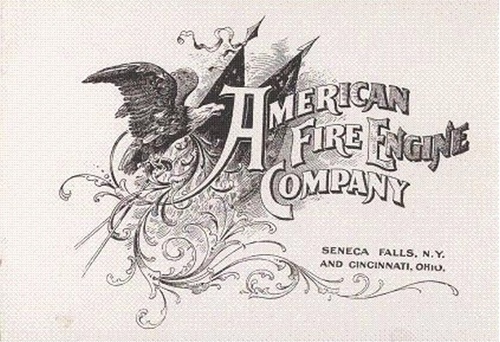
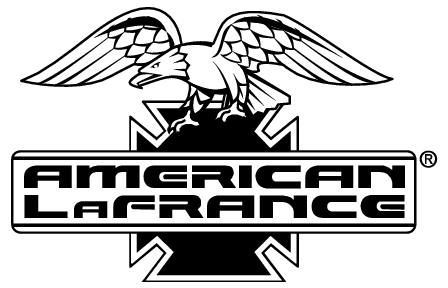

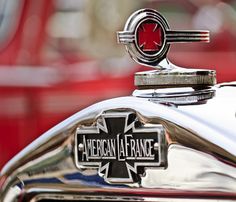
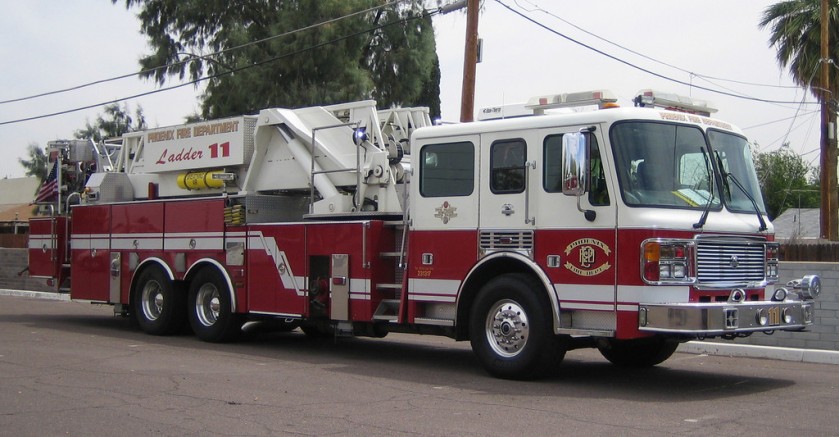

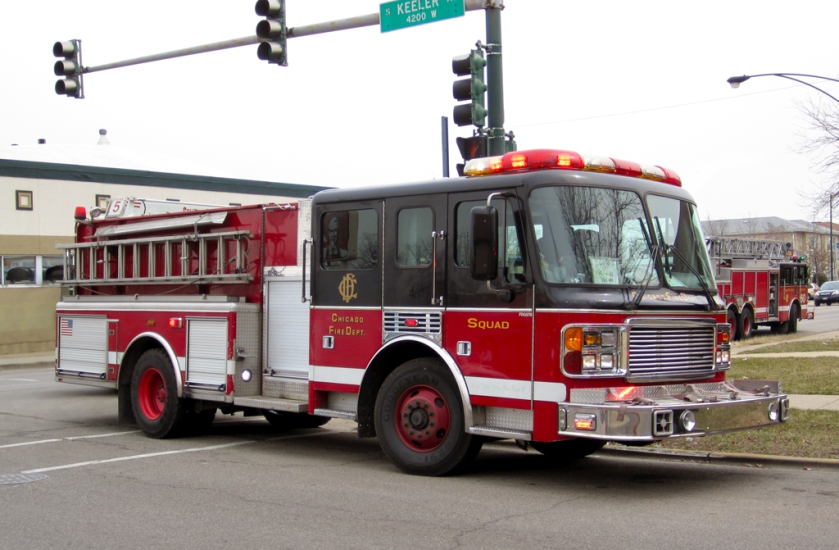
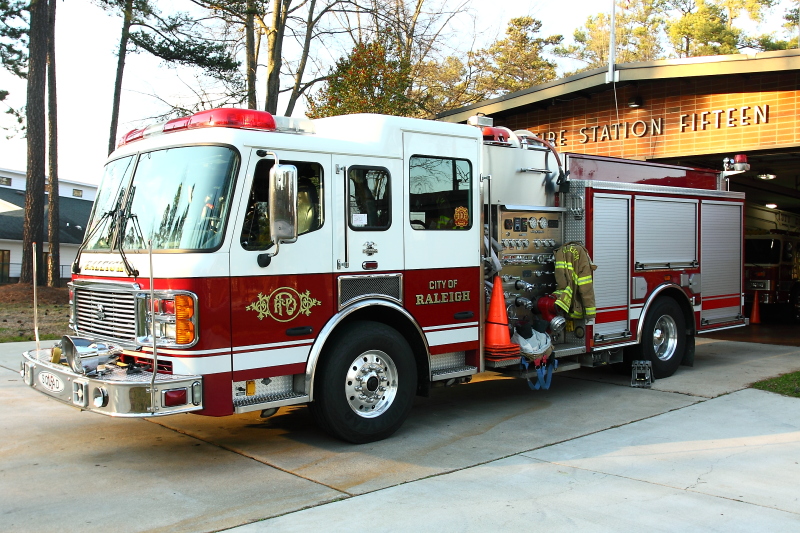

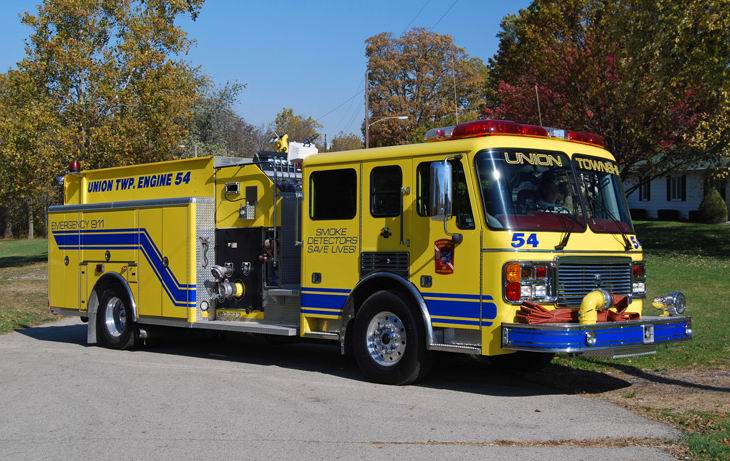

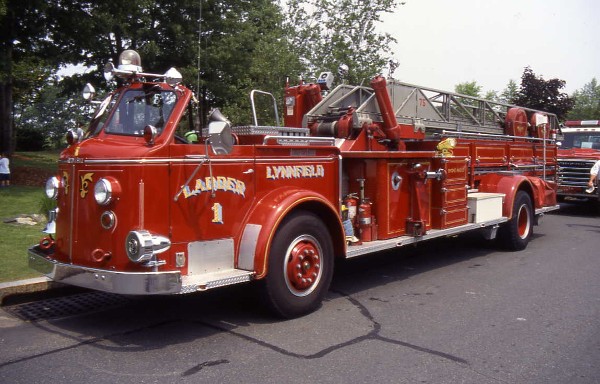
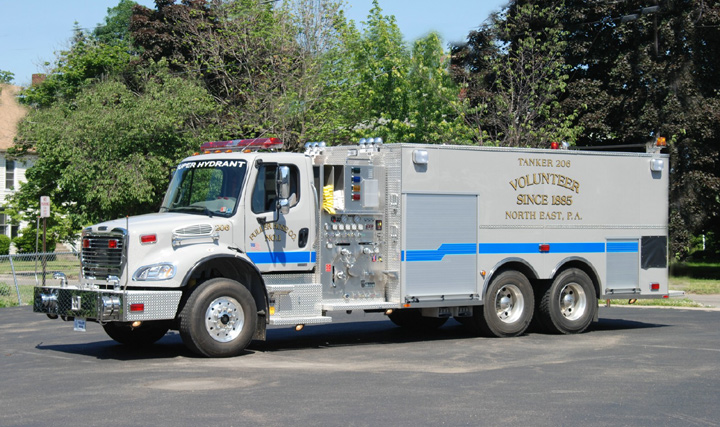
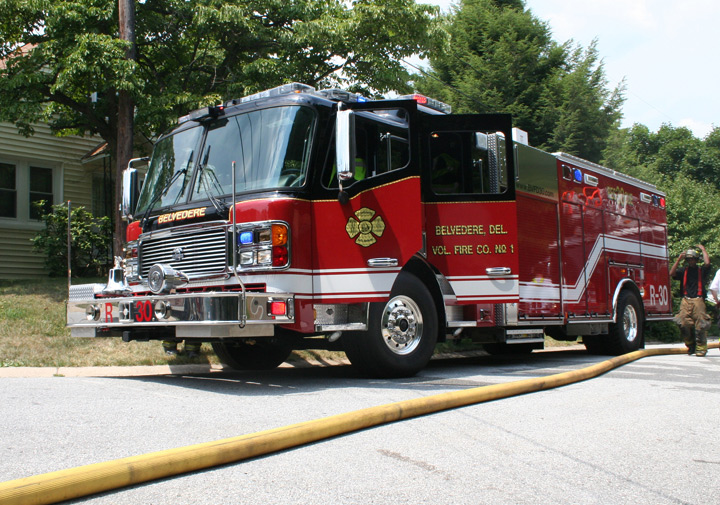
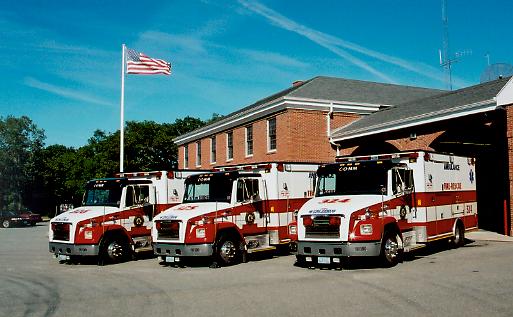
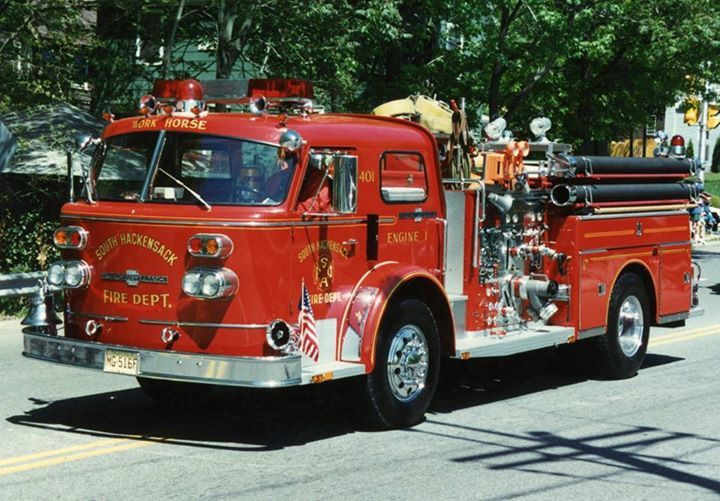
 2011 american-lafrance-fire-truck Liberty
2011 american-lafrance-fire-truck Liberty